ADTRAN TRC6320 TRACER 6000 Series Split System User Manual 612806320L1 1A
Adtran TRACER 6000 Series Split System 612806320L1 1A
ADTRAN >
Manual rev

612806320L1-1A
March 2005
TRACER 6000 SERIES
Split System Manual
12806200L1 TRACER 6200 Modular Indoor Unit (IDU)
12806320L1A TRACER 6320 5.8 GHz Outdoor Unit (ODU) Plan A
12806320L1B TRACER 6320 5.8 GHz Outdoor Unit (ODU) Plan B

Trademarks TRACER 6000 Series Split System Manual
2 Copyright © 2005 ADTRAN, Inc. 612806320L1-1A
Trademarks
Any brand names and product names included in this manual are trademarks, registered trademarks, or
trade names of their respective holders.
To the Holder of the Manual
The contents of this manual are current as of the date of publication. ADTRAN reserves the right to change
the contents without prior notice.
In no event will ADTRAN be liable for any special, incidental, or consequential damages or for
commercial losses even if ADTRAN has been advised thereof as a result of issue of this publication.
About this Manual
This manual provides a complete description of the TRACER 6000 Series split system and system
software.The purpose of this manual is to provide the technician, system administrator, and manager
with general and specific information related to the planning, installation, operation, and maintenance of
the TRACER 6000 Series split systems. This manual is arranged so that needed information can be quickly
and easily found.
901 Explorer Boulevard
P.O. Box 140000
Huntsville, AL 35814-4000
Phone: (256) 963-8000
Copyright © 2005 ADTRAN, Inc.
All Rights Reserved.
Printed in U.S.A.
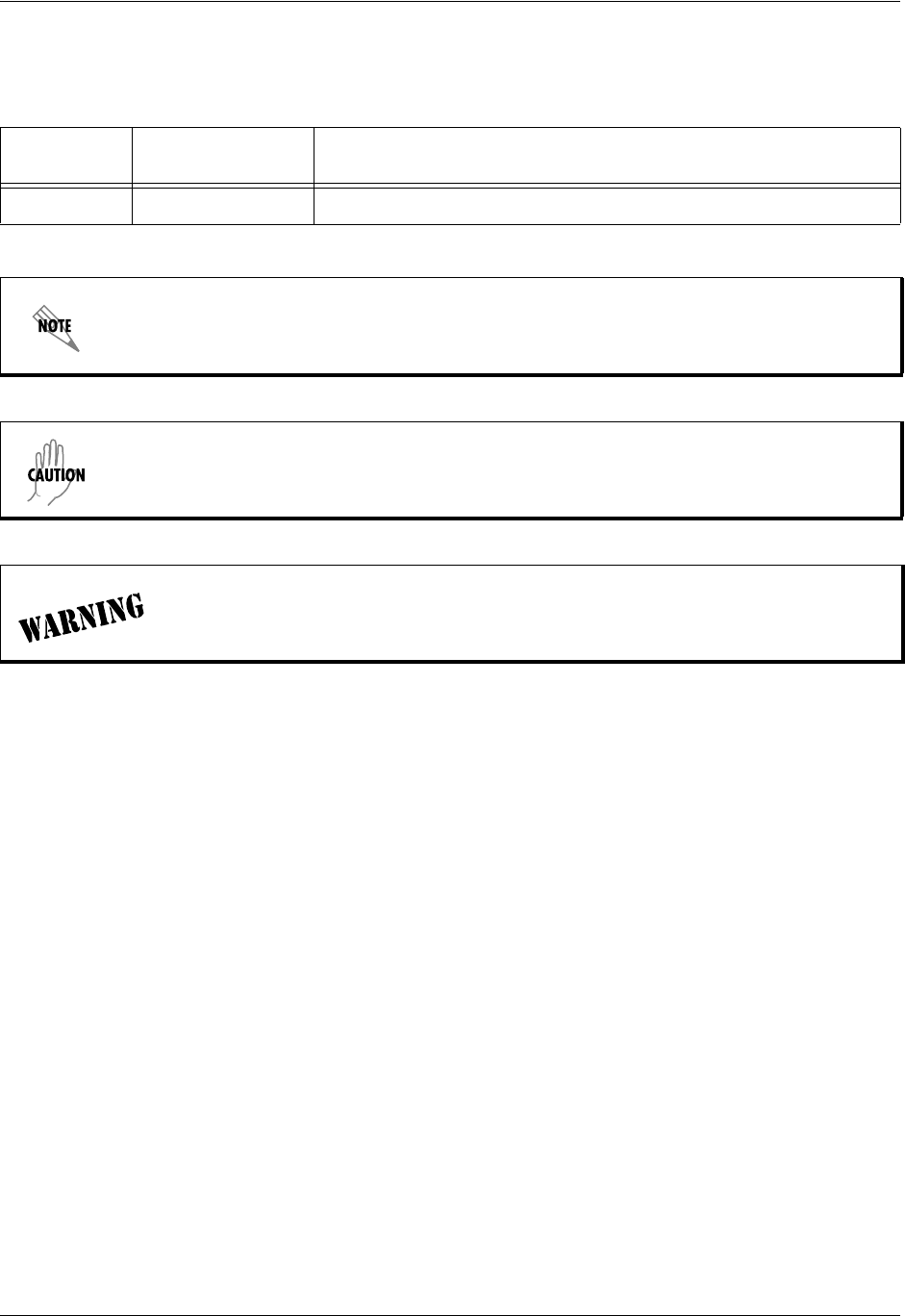
TRACER 6000 Series Split System Manual Revision History
612806320L1-1A Copyright © 2005 ADTRAN, Inc. 3
Revision History
Document
Revision Date Description of Changes
A March 2005 Initial release of manual.
Notes provide additional useful information.
Cautions signify information that could prevent service interruption.
Warnings provide information that could prevent damage to the equipment or
endangerment to human life.

Safety Instructions TRACER 6000 Series Split System Manual
4 Copyright © 2005 ADTRAN, Inc. 612806320L1-1A
Safety Instructions
When using your telephone equipment, please follow these basic safety precautions to reduce the risk of
fire, electrical shock, or personal injury:
1. Do not use this product near water, such as a bathtub, wash bowl, kitchen sink, laundry tub, in a
wet basement, or near a swimming pool.
2. Avoid using a telephone (other than a cordless-type) during an electrical storm. There is a remote
risk of shock from lightning.
3. Do not use the telephone to report a gas leak in the vicinity of the leak.
4. Use only the power cord, power supply, and/or batteries indicated in the manual. Do not dispose of
batteries in a fire. They may explode. Check with local codes for special disposal instructions.
Save These Important Safety Instructions
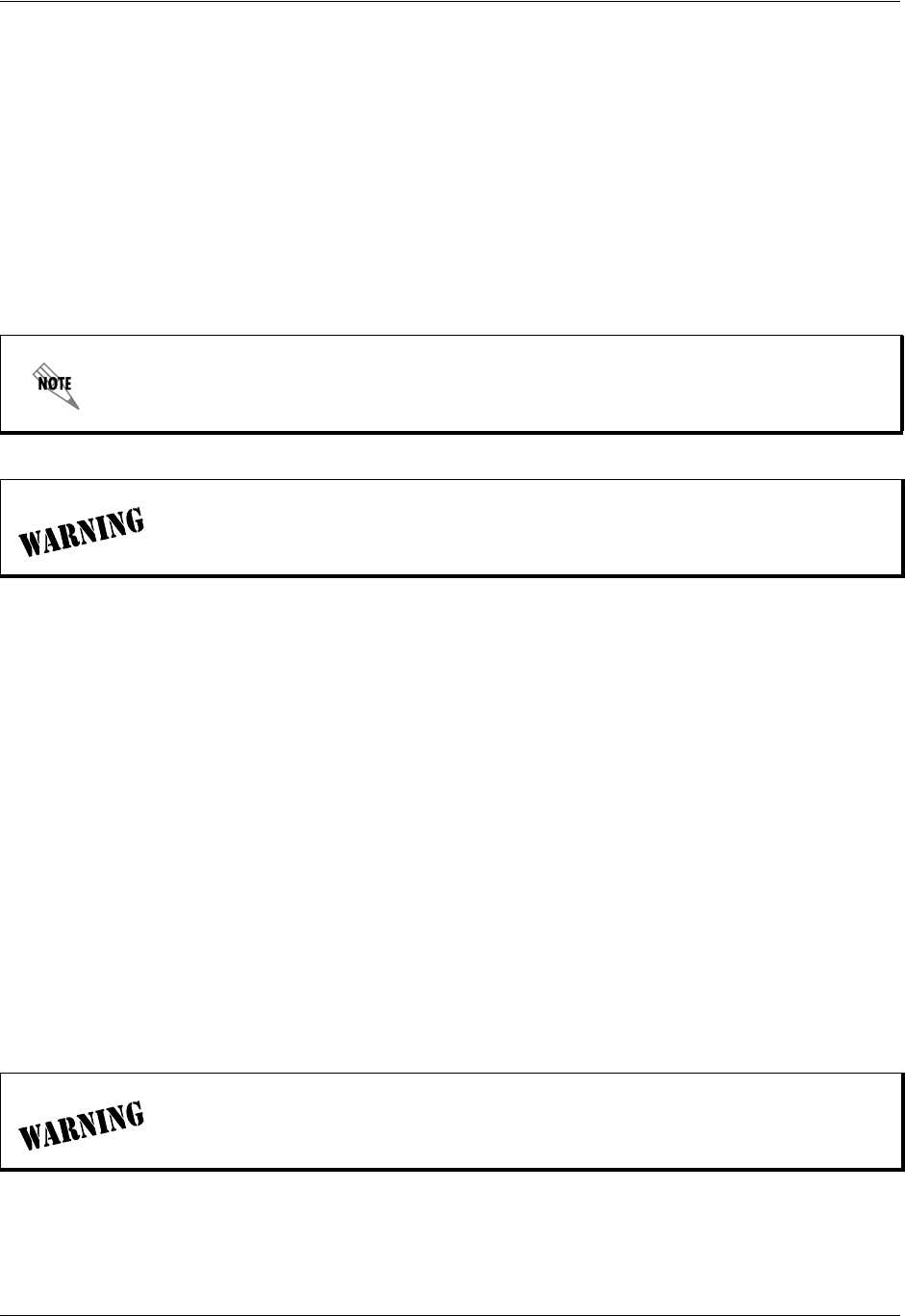
TRACER 6000 Series Split System Manual FCC-Required Information
612806320L1-1A Copyright © 2005 ADTRAN, Inc. 5
FCC-Required Information
Federal Communications Commission Radio Frequency Interference Statement
This equipment has been tested and found to comply with the limits for a Class A digital device, pursuant
to Part 15 of the FCC Rules. These limits are designed to provide reasonable protection against harmful
interference when the equipment is operated in a commercial environment. This equipment generates,
uses, and can radiate radio frequency energy and, if not installed and used in accordance with the
instruction manual, may cause harmful interference to radio frequencies. Operation of this equipment in a
residential area is likely to cause harmful interference in which case the user will be required to correct the
interference at his own expense.
Radio Frequency Interface Statement
This equipment has been tested and found to comply with the limits for an intentional radiator, pursuant to
Part 15, Subpart C of the FCC Rules. This equipment generates, uses, and can radiate radio frequency
energy. If not installed and used in accordance with the instructions, it may cause interference to radio
communications.
The limits are designed to provide reasonable protection against such interference in a residential situation.
However, there is no guarantee that interference will not occur in a particular installation. If this equipment
does cause interference to radio or television reception, which can be determined by turning the equipment
on and off, the user is encouraged to try to correct the interference by one or more of the following
measures:
• Reorient or relocate the receiving antenna of the affected radio or television.
• Increase the separation between the equipment and the affected receiver.
• Connect the equipment and the affected receiver to power outlets on separate circuits.
• Consult the dealer or an experienced radio/TV technician for help.
Shielded cables must be used with this unit to ensure compliance with Class A FCC limits.
Changes or modifications to this unit not expressly approved by the party responsible
for compliance could void the user’s authority to operate the equipment.
Changes or modifications not expressly approved by ADTRAN could void the user’s
authority to operate the equipment.

FCC-Required Information TRACER 6000 Series Split System Manual
6 Copyright © 2005 ADTRAN, Inc. 612806320L1-1A
FCC Output Power Restrictions
The FCC does not require licensing to implement this device. License-free operation in the industrial,
scientific, and medical band is documented in FCC Rules Part 15.247. It is the responsibility of the
individuals designing and implementing the radio system to assure compliance with any pertinent FCC
Rules and Regulations. This device must be professionally installed.
Exposure to Radio Frequency Fields
The TRACER 6320 is designed to operate at 5.8 GHz with 100 mW maximum transmit power.
This level of RF energy is below the Maximum Permissible Exposure (MPE) levels specified in FCC OET
65:97-01. The installation of high gain antenna equipment in the system configuration may create the
opportunity for exposure to levels higher than recommended for the general population at a distance less
than 15 feet (4.6 meter) from the center of the antenna. The following precautions must be taken during
installation of this equipment:
• The installed antenna must not be located in a manner that allows exposure of the general population to
the direct beam path of the antenna at a distance less than 15 feet (4.6 meters). Installation on towers,
masts, or rooftops not accessible to the general population is recommended; or
• Mount the antenna in a manner that prevents any personnel from entering the area within 15 feet (4.6
meter) from the front of the antenna.
• It is recommended that the installer place radio frequency hazard warnings signs on the barrier that
prevents access to the antenna.
• Prior to installing the antenna to the TRACER output, make sure the power is adjusted to the settings
specified in section 2 of this manual.
• During antenna installation, be sure that power to the TRACER equipment is turned off in order to
prevent any energy presence on the coaxial connector.
• During installation and alignment of the antenna, do not stand in front of the antenna assembly.
• During installation and alignment of the antenna, do not handle or touch the front of the antenna.
These simple precautions must be taken to prevent general population and installation personnel from
exposure to RF energy in excess of specified MPE levels.
This space reserved for international application notations.
Verify the antenna installation meets all regulations specified in the National Electric
Code (NEC) Article 810.

TRACER 6000 Series Split System Manual
612806320L1-1A Copyright © 2005 ADTRAN, Inc. 7
Warranty, Customer Service, Product Support Information, and Training
ADTRAN will repair and return this product within the warranty period if it does not meet its published
specifications or fails while in service. Warranty information can be found at www.adtran.com/warranty.
A return material authorization (RMA) is required prior to returning equipment to ADTRAN. For service,
RMA requests, training, or more information, use the contact information given below.
Repair and Return
If you determine that a repair is needed, please contact our Customer and Product Service (CaPS)
department to have an RMA number issued. CaPS should also be contacted to obtain information
regarding equipment currently in house or possible fees associated with repair.
Identify the RMA number clearly on the package (below address), and return to the following address:
Pre-Sales Inquiries and Applications Support
Your reseller should serve as the first point of contact for support. If additional pre-sales support is needed,
the ADTRAN Support website provides a variety of support services such as a searchable knowledge base,
latest product documentation, application briefs, case studies, and a link to submit a question to an
Applications Engineer. All of this, and more, is available at:
When needed, further pre-sales assistance is available by calling our Applications Engineering
Department.
CaPS Department (256) 963-8722
ADTRAN Customer and Product Service
901 Explorer Blvd. (East Tower)
Huntsville, Alabama 35806
RMA # _____________
http://support.adtran.com
Applications Engineering (800) 615-1176

TRACER 6000 Series Split System Manual
8 Copyright © 2005 ADTRAN, Inc. 612806320L1-1A
Post-Sale Support
Your reseller should serve as the first point of contact for support. If additional support is needed, the
ADTRAN Support website provides a variety of support services such as a searchable knowledge base,
updated firmware releases, latest product documentation, service request ticket generation and
trouble-shooting tools. All of this, and more, is available at:
When needed, further post-sales assistance is available by calling our Technical Support Center. Please
have your unit serial number available when you call.
Maintenance Support
The ADTRAN Custom Extended Services (ACES) program offers multiple types and levels of
maintenance services which allow you to choose the kind of assistance you need. This support is available
at:
For questions, call the ACES Help Desk.
Training
The Enterprise Network (EN) Technical Training Department offers training on our most popular
products. These courses include overviews on product features and functions while covering applications
of ADTRAN's product lines. ADTRAN provides a variety of training options, including customized
training and courses taught at our facilities or at your site. For more information about training, please
contact your Territory Manager or the Enterprise Training Coordinator.
http://support.adtran.com
Technical Support (888) 4ADTRAN
http://www.adtran.com/aces
ACES Help Desk (888) 874-ACES (2237)
Training Phone (800) 615-1176, ext. 7500
Training Fax (256) 963-6700
Training Email training@adtran.com

612806320L1-1A Copyright © 2005 ADTRAN, Inc. 9
Table of Contents
Section 1 System Description . . . . . . . . . . . . . . . . . . . . . . . . . . . . . . . . . . . . . . . . 11
Provides an overview of the TRACER 6000 Series split system.
Section 2 Microwave Path Engineering Basics . . . . . . . . . . . . . . . . . . . . . . . . . . 15
Explains the basics of analyzing a wireless microwave link or path. Defines significant
parameters and makes several installation recommendations.
Section 3 Engineering Guidelines . . . . . . . . . . . . . . . . . . . . . . . . . . . . . . . . . . . . . 29
Provides information to assist network designers with incorporating the TRACER 6000 Series
split system into their networks.
Section 4 Network Turnup Procedure. . . . . . . . . . . . . . . . . . . . . . . . . . . . . . . . . . 45
Provides shipment contents list, grounding instructions, mounting options, and specifics of
supplying power to the unit.
Section 5 User Interface Guide . . . . . . . . . . . . . . . . . . . . . . . . . . . . . . . . . . . . . . . 55
Provides detailed descriptions of all menu options and configuration parameters available for
the TRACER 6000 Series split system.
Section 6 Detail Level Procedures. . . . . . . . . . . . . . . . . . . . . . . . . . . . . . . . . . . . . 89
Provides detailed instructions on performing common system tasks such as connecting to the
system and upgrading firmware.
DLP-1 Connecting a VT100 Terminal or PC to the CRAFT Port . . . . . . . . . . . . . . . . . . . . . . 91
DLP-2 Logging into the TRACER System. . . . . . . . . . . . . . . . . . . . . . . . . . . . . . . . . . . . . . . . 93
DLP-3 Setting IP Parameters for the TRACER System. . . . . . . . . . . . . . . . . . . . . . . . . . . . . . 95
DLP-4 Verifying Communications Over an IP LAN . . . . . . . . . . . . . . . . . . . . . . . . . . . . . . . . 99
DLP-5 Updating the Firmware Using TFTP. . . . . . . . . . . . . . . . . . . . . . . . . . . . . . . . . . . . . . 101
DLP-6 Updating the Firmware Using XMODEM . . . . . . . . . . . . . . . . . . . . . . . . . . . . . . . . . 105
Section 7 MIBs. . . . . . . . . . . . . . . . . . . . . . . . . . . . . . . . . . . . . . . . . . . . . . . . . . . . 107
Provides a listing of SNMP Management Information Bases (MIBs) supported by the
TRACER 6000 split system. This section also lists traps supported for each MIB.
Section 8 Troubleshooting Guide . . . . . . . . . . . . . . . . . . . . . . . . . . . . . . . . . . . . 119
Provides helpful information for troubleshooting common configuration problems for the
TRACER 6000 Series.

Table of Contents TRACER 6000 Series Split System Manual
10 Copyright © 2005 ADTRAN, Inc. 612806320L1-1A

612806320L1-1A Copyright © 2005 ADTRAN, Inc. 11
SYSTEM DESCRIPTION
Provides an overview of the TRACER 6000 Series split system.
CONTENTS
System Overview . . . . . . . . . . . . . . . . . . . . . . . . . . . . . . . . . . . . . . . . . . . . . . . . . . . . . . . . . . . . . . . 12
Features and Benefits . . . . . . . . . . . . . . . . . . . . . . . . . . . . . . . . . . . . . . . . . . . . . . . . . . . . . . . . . . . 12
Configuration and Management . . . . . . . . . . . . . . . . . . . . . . . . . . . . . . . . . . . . . . . . . . . . . . . . . 12
Operational . . . . . . . . . . . . . . . . . . . . . . . . . . . . . . . . . . . . . . . . . . . . . . . . . . . . . . . . . . . . . . . . . 13
E1 Network Module. . . . . . . . . . . . . . . . . . . . . . . . . . . . . . . . . . . . . . . . . . . . . . . . . . . . . . . . . . . 13
T1 Network Module. . . . . . . . . . . . . . . . . . . . . . . . . . . . . . . . . . . . . . . . . . . . . . . . . . . . . . . . . . . 13
Quad Ethernet Switch Module . . . . . . . . . . . . . . . . . . . . . . . . . . . . . . . . . . . . . . . . . . . . . . . . . . 13

Section 1 System Description TRACER 6000 Series Split System Manual
12 Copyright © 2005 ADTRAN, Inc. 612806320L1-1A
1. SYSTEM OVERVIEW
The TRACER 6000 series wireless modular radio system provides license-free scalable connectivity for
service providers and corporate networks. These radios feature two modular network interface ports that
can accommodate various combinations of T1, E1, and Ethernet option cards up to 8xT1/E1 (16.384 Mbps
maximum). This flexibility provides customized time division multiplex (TDM) and packet solutions for
voice and data applications in a single platform. The TRACER 6000 series radios provide carrier class
point-to-point connectivity for up to 30 miles in the 5.8 GHz frequency band. A TRACER 6000 Series
split system consists of a TRACER 6200 Indoor Unit (IDU) and a TRACER 6320 Outdoor Unit (ODU) at
each end of the link. The TRACER 6200/6320 combination maximizes flexibility and reduces installation
costs by providing outdoor-mounted radio options (TRACER 6320).
Complete network management is supported via simple network management protocol (SNMP), Telnet
access, and a VT100 terminal interface (CRAFT port). SNMP traps are implemented for all RF link and
T1/E1/Ethernet alarm conditions and statistics, enabling remote installations to report outages without
requiring a visit to the remote site. Version 2 standard management information bases (MIBs) are
supported for all interface cards, while an enterprise-specific MIB is provided for radio functionality.
Triple-DES (3DES) security provides additional protection from unauthorized access without requiring
any additional external security appliances. Future upgrades and enhancements can be added through
FLASH firmware downloads via trivial file transfer protocol (TFTP) (on the Ethernet interface) or
XMODEM on the CRAFT port.
Receive sensitivity is optimized through the use of extensive forward error correction and
high-performance receiver design techniques. Dynamic receive sensitivity allows the user to increase
receiver performance by decreasing the delivered bandwidth. This feature maximizes link performance by
customizing the delivered bandwidth to the specific needs of the installation. Three software selectable
channel plans are supported to simplify frequency coordination at co-located sites. Channel plans are
easily changed via any of the software management interfaces without the added expense of hardware
upgrades or spare filter assemblies.
TRACER wireless solutions maximize equipment density through the combination of compact size (only
1U rack space required for the Indoor Unit (IDU)), low power consumption, and high thermal transfer.
TRACER systems can be deployed at twice the density of other available wireless products.
2. FEATURES AND BENEFITS
The following is a brief list of the TRACER 6000 Series split system features and benefits:
Configuration and Management
• VT100 control ports (RS232 via a DB-9 interface) for configuration and monitoring
• Telnet access via the 10/100BaseT/TX Management interface
• SNMPv2 control over the RF link and E1/T1/Ethernet interfaces using standard and enterprise-specific
MIBs
Reserved for international application notations.

TRACER 6000 Series Split System Manual Section 1 System Description
612806320L1-1A Copyright © 2005 ADTRAN, Inc. 13
Operational
• Frequency: 5.725 to 5.850 GHz
• Dual module slots for network connectivity
• Up to 8xT1 or E1s bandwidth (16.384 Mbps) using two 4xT1 or 4xE1 network modules
• Point-to-point transmission
• Indoor (IDU) and Outdoor (ODU) system components
• IDU 1U high for easy rack mounting
E1 Network Module
• Four E1 circuits provided through a single DB-25, 75Ω connector
• Complies with CCITT G.703, G.704, and G.823 standards (with the BNC breakout panel)
• E1 circuit alarm reporting capability
• Testing support through local and remote line and link loopbacks
•75Ω E1 breakout panel (P/N 1280060L1) provides BNC interfaces for E1 connections
T1 Network Module
• Four T1 circuits provided through four RJ-45 connectors
• Complies with ANSI T1.403 and AT&T 54016 and 62411
• T1 circuit alarm reporting capability
• Testing support through local and remote line and link loopbacks
Quad Ethernet Switch Module
• Four 10/100BaseT/TX interfaces provided through four RJ-45 connectors
• Auto MDI/MDIX crossover on all interfaces
• Back-pressure flow control on all half-duplex interfaces
• Pause-frame flow control on all full-duplex interfaces

Section 1 System Description TRACER 6000 Series Split System Manual
14 Copyright © 2005 ADTRAN, Inc. 612806320L1-1A

612806320L1-1A Copyright © 2005 ADTRAN, Inc. 15
MICROWAVE PATH ENGINEERING BASICS
Explains the basics of analyzing a wireless microwave link or path. Defines significant parameters and
makes several installation recommendations.
CONTENTS
Line-of-Sight . . . . . . . . . . . . . . . . . . . . . . . . . . . . . . . . . . . . . . . . . . . . . . . . . . . . . . . . . . . . . . . . . . . 16
Terminology . . . . . . . . . . . . . . . . . . . . . . . . . . . . . . . . . . . . . . . . . . . . . . . . . . . . . . . . . . . . . . . . 16
Decibels . . . . . . . . . . . . . . . . . . . . . . . . . . . . . . . . . . . . . . . . . . . . . . . . . . . . . . . . . . . . . . . . . . . . . . . 16
Calculating the Fade Margin . . . . . . . . . . . . . . . . . . . . . . . . . . . . . . . . . . . . . . . . . . . . . . . . . . . . . . 16
Receiver Power . . . . . . . . . . . . . . . . . . . . . . . . . . . . . . . . . . . . . . . . . . . . . . . . . . . . . . . . . . . . . . . . . 17
Antenna Gain . . . . . . . . . . . . . . . . . . . . . . . . . . . . . . . . . . . . . . . . . . . . . . . . . . . . . . . . . . . . . . . 18
Transmitted Power (PT) . . . . . . . . . . . . . . . . . . . . . . . . . . . . . . . . . . . . . . . . . . . . . . . . . . . . . . . 19
Carrier Wavelength (l). . . . . . . . . . . . . . . . . . . . . . . . . . . . . . . . . . . . . . . . . . . . . . . . . . . . . . . . . 19
Path Distance (d) . . . . . . . . . . . . . . . . . . . . . . . . . . . . . . . . . . . . . . . . . . . . . . . . . . . . . . . . . . . . 19
System Losses (L) . . . . . . . . . . . . . . . . . . . . . . . . . . . . . . . . . . . . . . . . . . . . . . . . . . . . . . . . . . . 19
Path Loss (LP) . . . . . . . . . . . . . . . . . . . . . . . . . . . . . . . . . . . . . . . . . . . . . . . . . . . . . . . . . . . . . . 20
Receiver Sensitivity . . . . . . . . . . . . . . . . . . . . . . . . . . . . . . . . . . . . . . . . . . . . . . . . . . . . . . . . . . . . . 22
Antenna Information . . . . . . . . . . . . . . . . . . . . . . . . . . . . . . . . . . . . . . . . . . . . . . . . . . . . . . . . . . . . 22
Antenna Alignment . . . . . . . . . . . . . . . . . . . . . . . . . . . . . . . . . . . . . . . . . . . . . . . . . . . . . . . . . . . 23
TRACER RSSI Test Points. . . . . . . . . . . . . . . . . . . . . . . . . . . . . . . . . . . . . . . . . . . . . . . . . . . . . 23
Antenna Beam Patterns . . . . . . . . . . . . . . . . . . . . . . . . . . . . . . . . . . . . . . . . . . . . . . . . . . . . . . . 23
Fresnel Zones, Earth Curvature, and Antenna Heights . . . . . . . . . . . . . . . . . . . . . . . . . . . . . . . 24
Other Considerations . . . . . . . . . . . . . . . . . . . . . . . . . . . . . . . . . . . . . . . . . . . . . . . . . . . . . . . . . . . . 26
Path Availability. . . . . . . . . . . . . . . . . . . . . . . . . . . . . . . . . . . . . . . . . . . . . . . . . . . . . . . . . . . . . . 26
FIGURES
Figure 1. Example Microwave Path with Parameters . . . . . . . . . . . . . . . . . . . . . . . . . . . . . . . . . . 18
Figure 2. Typical Antenna Beam Pattern . . . . . . . . . . . . . . . . . . . . . . . . . . . . . . . . . . . . . . . . . . . 24
TABLES
Table 1. Antenna Gain for Given Dish Diameters (Standard) . . . . . . . . . . . . . . . . . . . . . . . . . . . . 18
Table 2. Antenna Gain for Given Dish Diameters (Metric) . . . . . . . . . . . . . . . . . . . . . . . . . . . . . . 19
Table 3. Typical Coaxial Loss for Common Cable Types . . . . . . . . . . . . . . . . . . . . . . . . . . . . . . . 20
Table 4. Path Loss for Given Path Lengths (miles) . . . . . . . . . . . . . . . . . . . . . . . . . . . . . . . . . . . . 21
Table 5. Path Loss for Given Path Lengths (kilometers) . . . . . . . . . . . . . . . . . . . . . . . . . . . . . . . . 21
Table 6. Receiver Sensitivity for the TRACER 6320 . . . . . . . . . . . . . . . . . . . . . . . . . . . . . . . . . . . 22
Table 7. Minimum Antenna Height for Given Path Lengths . . . . . . . . . . . . . . . . . . . . . . . . . . . . . 25
Table 8. Minimum Antenna Height for Given Path Lengths . . . . . . . . . . . . . . . . . . . . . . . . . . . . . 25

Section 2 Microwave Path Engineering Basics TRACER 6000 Series Split System Manual
16 Copyright © 2005 ADTRAN, Inc. 612806320L1-1A
1. LINE-OF-SIGHT
The TRACER 6200/6320 system is designed for operation in the license-free 5.725 GHz to 5.850 GHz
industrial, scientific, and medical (ISM) band. Radio wave propagation in this band exhibits microwave
characteristics which are ideally suited for point-to-point, line-of-sight communications. Line-of-sight
requires that the transmitting antenna and receiving antenna are able to “see” each other, and that the
straight-line path between the two antennas is free of obstructions such as buildings, trees, mountains, and
in longer paths, even the curvature of the earth. For maximum signal strength, the area around the visual
line-of-sight where microwave signals reflect (Fresnel zone) must also be free of obstructions. Fresnel
zones are discussed in more detail on page 24.
Terminology
2. DECIBELS
Understanding the decibel (dB) format is key when discussing microwave path engineering because the
received signal power is often expressed in decibel format. In general, any quantity can be expressed in
decibels. If the quantity x is a power level (in Watts), the decibel equivalent is defined as
If the quantity x is referenced to a milliwatt (mW), then the decibel-milliwatt (dBm) is used instead of a
generic decibel.
Using the decibel format simplifies power calculations by reducing multiplication and division operations
into addition and subtraction operations.
3. CALCULATING THE FADE MARGIN
The fade margin (F ) is a value in decibels (dB) that represents the amount of signal reduction that can be
tolerated before the link exceeds the specified bit error rate (BER). Fade margin is simply the difference
between the available signal power at the receiver (PR ) and the receiver sensitivity (Psens ).
Point-to-Point Wireless communication from a single site to another individual
site. Contrast with point-to-multipoint.
Line-of-Sight An unobstructed, direct path exists between the transmitting and
the receiving antennas.
It is imperative to determine whether the proposed microwave path is suitable (at a
minimum) for ideal, nondistorted signals before attempting installation.
xdB 10 log10 x()
⋅
=(dB)
xdBm 10 log10 x
1mW
-------------
⎝⎠
⎛⎞
⋅
=(dBm)
FP
RPsens
–=(dB)
= PT + GT + GR - L - LP - Psens

TRACER 6000 Series Split System Manual Section 2 Microwave Path Engineering Basics
612806320L1-1A Copyright © 2005 ADTRAN, Inc. 17
where the variables in the equations are defined as
PRreceived power (dBm)
PTtransmitted power (adjustable up to 20 dBm maximum)
GTtransmit antenna gain (decibels referenced to an isotropic source – dBi)
GRreceive antenna gain (dBi)
Lother losses (RF coaxial cable, etc. – dB)
LPpath loss (dB)
Higher levels of fade margin indicate stronger protection against signal fading and a more reliable link. For
most applications, 20 to 30 dB of fade margin should ensure a reliable link.
The following sections further discuss the necessary power calculations and their components.
4. RECEIVER POWER
The viability of a particular microwave path is determined by the power of the transmitted microwave
signal, the transmit and receive antenna gain, distance, and accumulated system losses (such as RF coaxial
cable losses and path loss).
The equation relating received signal power to the other microwave parameters is
or (in decibel notation)
where the variables in the equations are defined as
PRreceived power (dBm)
PTtransmitted power (adjustable up to 20 dBm maximum)
GTtransmit antenna gain (decibels referenced to an isotropic source – dBi)
GRreceive antenna gain (dBi)
λcarrier wavelength (meters)
dpath distance (meters)
Lother losses (RF coaxial cable, etc. – dB)
LPpath loss (dB)
When using decibel notation, all quantities must be individually converted to decibels
prior to performing addition and subtraction.
PR
PTGTGR
λ
2
4
π
()
2d2L
------------------------------=(Watts, W)
(decibels referenced to a milliwatt, dBm)
PR = PT + GT + GR - L - LP
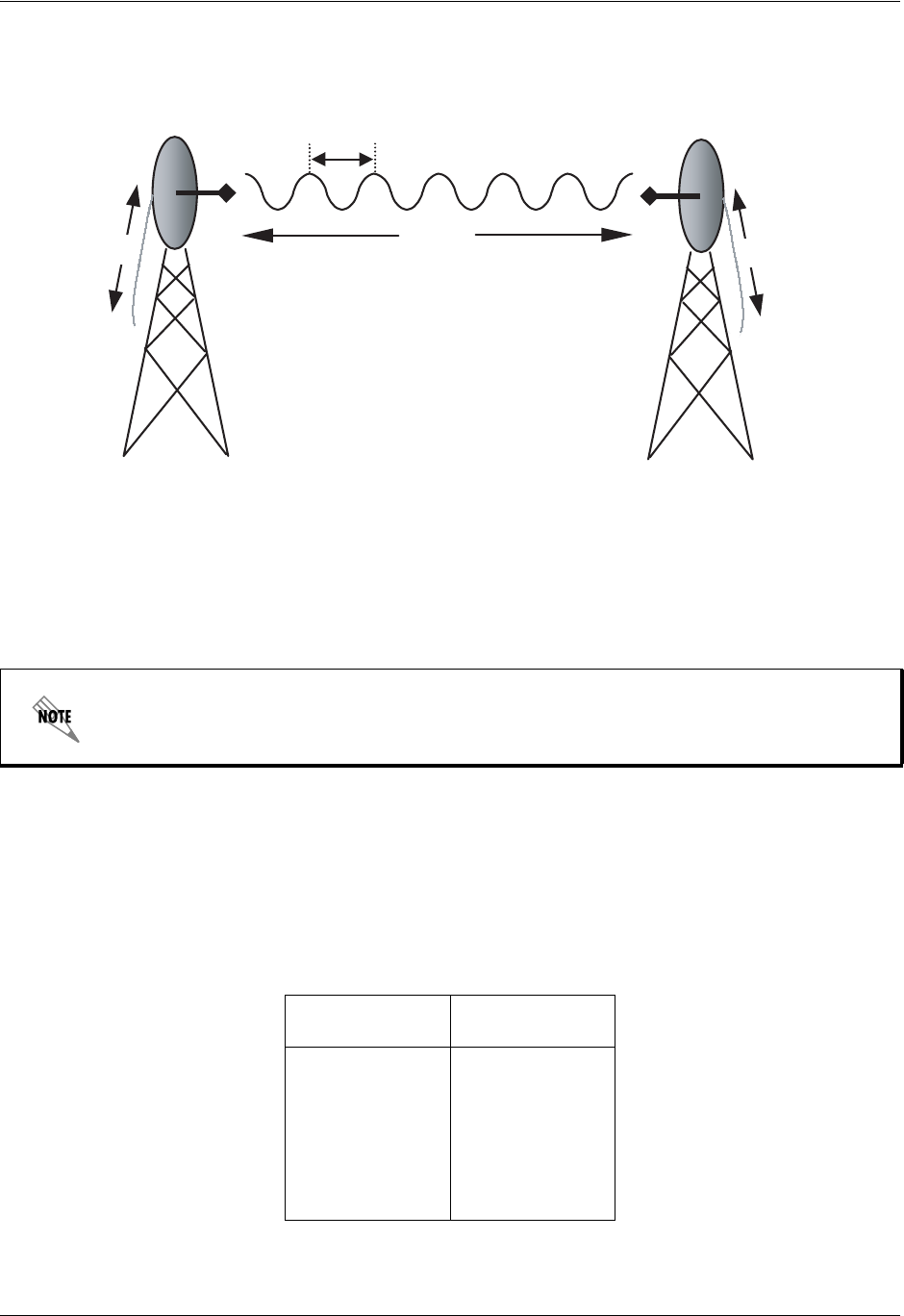
Section 2 Microwave Path Engineering Basics TRACER 6000 Series Split System Manual
18 Copyright © 2005 ADTRAN, Inc. 612806320L1-1A
Figure 1 illustrates a wireless link configuration containing all the parameters necessary for the power
budget analysis.
Figure 1. Example Microwave Path with Parameters
The following sections further discuss the power budget analysis and its components.
Antenna Gain
Actual transmit and receive antenna gain values depend strictly upon the physical characteristics of the
antennas installed for each link. In other words, the size of the dish determines the antenna gain. Using a
parabolic dish antenna results in the best performance. Antenna gains are specified in terms of decibels of
gain referenced to an isotropic source (dBi). An isotropic source is a hypothetical antenna having equal
radiation in all directions. Typical antenna gains are listed in Table 1 (standard) and Table 2 on page 19
(metric); however, dish manufacturers can provide gains for specific types of antennas.
This section does not apply to customers deploying the TRACER 6320 ODU with
integrated antenna.
Table 1. Antenna Gain for Given Dish Diameters (Standard)
Dish Diameter
(in feet) Gain at 5.8 GHz
(in dBi)
228.5
434.2
637.5
840.7
10 42.5
12 44.2
G
T
G
R
d, L
P
P
T
P
R
λ
L
L

TRACER 6000 Series Split System Manual Section 2 Microwave Path Engineering Basics
612806320L1-1A Copyright © 2005 ADTRAN, Inc. 19
Transmitted Power (PT)
The FCC specifies the maximum transmitter power used for antennae of a given gain. FCC Rules (Part 15,
Subpart 247) allow for a maximum transmit power of 1 Watt (30 dBm). Since the TRACER 6320
maximum transmit power is 100 milliwatts, there is no reduction in transmitter output power required.
The TRACER 6320 ODU with integrated antenna has a maximum transmit power of 100 milliwatts
(20 dBm). The transmitter can be adjusted from approximately 0 to 20 dBm. This antenna has an EIRP of
less than +33 dBm.
Carrier Wavelength (λ)
The carrier wavelength is the physical wavelength of the main RF carrier being used for communication,
and is usually approximated at the center frequency of the band (which is 5787.5 MHz for the
TRACER 6320). The carrier wavelength calculations follow
λ = c / f (meters)
where
c = speed of light (in meters)
f = frequency (in Hz)
resulting in the following carrier wavelength
λ = 3.00 x 108 / 5787.5 x 105
= 0.0518 m or 5.18 cm
Path Distance (d)
The path distance is simply the physical distance between the transmit and receive antennas. For the
TRACER 6320, these distances can range up to 30 miles (48.27 meters).
System Losses (L)
System losses are defined by RF coaxial cable loss, connector losses, and losses added from any additional
lightning protection devices for the power budget analysis. Coaxial cable is required to attach the
TRACER 6320 to the antenna (for all systems without the integrated antenna). The length of the cable
varies from a few feet to hundreds of feet, depending upon your application and the proximity of the
TRACER 6320 to the antenna. Various grades of coaxial cable will work sufficiently for connecting the
TRACER 6320 unit to the antenna. A low-loss coaxial cable will minimize cable losses.
Table 2. Antenna Gain for Given Dish Diameters (Metric)
Dish Diameter
(in meters) Gain at 5.8 GHz
(in dBi)
0.6 28.5
0.8 31.1
1.0 33.0
1.2 33.0
1.5 34.6
1.8 37.9
2.0 39.0

Section 2 Microwave Path Engineering Basics TRACER 6000 Series Split System Manual
20 Copyright © 2005 ADTRAN, Inc. 612806320L1-1A
One end of the coaxial cable requires an N-type male connector (plug) to mate with the TRACER 6320
unit. The other end of the coaxial cable requires a connector compatible with the antenna chosen for the
installation (usually an N-type male connector). Additionally, ADTRAN recommends that the outdoor
connector on the coaxial cable be weatherproofed to prevent corrosion and electrical shorting.
Table 3 gives typical loss figures for some of the more common coaxial cable types (per 100 feet).
Path Loss (LP)
Path loss is the estimated attenuation between the transmit and receive antennas caused by signal
separation and scattering. The path loss is considered basic transmission loss over the microwave link. The
following expression calculates path loss:
where
fcarrier frequency (Hz)
λcarrier wavelength (c / f) (meters)
dpath distance (meters)
cspeed of light, free-space (meters)
In areas where lightning strikes are frequent, a lightning arrestor should be installed
directly on the antenna coaxial cable. Installing lightning arrestors helps protect the
RF electronics (including the TRACER 6320 unit) in the downstream path from
damaging voltages and currents.
IF lightning arrestors must have the ability to pass DC voltages (up to +/- 60 volts)
and should be installed with care.
Table 3. Typical Coaxial Loss for Common Cable Types
Cable Type 5.8 GHz Loss/100 ft (in dB)
RG58 N/A
RG8 (air) N/A
RG8 (foam) N/A
1/4” Coax 11.36
3/8” Coax 9.65
1/2” Coax 6.49
5/8” Coax 4.90
7/8” Coax N/A
1 1/4” Coax N/A
1 5/8” Coax N/A
5.8 GHz Elliptical Waveguide 1.23
LP4
π
d
λ
----------
⎝⎠
⎛⎞
24
π
df
c
------------
⎝⎠
⎛⎞
2
== (dB)

TRACER 6000 Series Split System Manual Section 2 Microwave Path Engineering Basics
612806320L1-1A Copyright © 2005 ADTRAN, Inc. 21
or
where d is expressed in miles and f in GHz.
Path loss, as shown here, increases rapidly as either the path length increases or the carrier wavelength
decreases (which happens as the carrier frequency increases). Therefore, longer microwave paths naturally
experience more path loss than shorter paths. Likewise, higher frequency microwave communication
experiences more path loss than lower frequency microwave communication.
The path loss values for various path lengths for the TRACER 5.8 GHz system are listed in Table 4 (miles)
and Table 5 (kilometers). Values not listed in the tables can be interpolated from those listed.
Table 4. Path Loss for Given Path Lengths (miles)
Path Length
(miles) Path Loss
(dB)
1112
2118
3121
4124
5126
10 132
15 135
20 138
25 140
30 141
35 143
Table 5. Path Loss for Given Path Lengths (kilometers)
Path Length
(kilometers) Path Loss
(dB)
1108
2114
3117
4120
5122
10 128
15 131
20 134
25 136
30 137
35 139
LP96.6 20 log10 d() 20·log+10 f()
⋅
+= (dB)

Section 2 Microwave Path Engineering Basics TRACER 6000 Series Split System Manual
22 Copyright © 2005 ADTRAN, Inc. 612806320L1-1A
5. RECEIVER SENSITIVITY
Receiver sensitivity is a value expressed in decibels referenced to one milliwatt (dBm) that corresponds to
the minimum amount of signal power needed at the receiver to achieve a given bit error rate (BER).
Receiver sensitivity is usually a negative number of decibels, and smaller receiver sensitivity (higher
quantity negative number) is better for a given BER. Several factors affect receiver sensitivity, including
the data bandwidth of the wireless link and the amount of additional signal degradation introduced in the
receiver electronics.
Receiver sensitivity of the TRACER 6320 is dynamic as a function of the desired bandwidth; receiver
sensitivity improves as delivered bandwidth decreases. TRACER bandwidth is provided in the form of
8 channels available for mapping to the interface modules. For T1 and E1 modules, each channel mapped
represents a single T1 or E1 interface. For Quad Ethernet Switch modules, each channel mapped represents
2 Mb of Ethernet data delivered to the module. In situations where 8-channel connectivity is not required,
the delivered bandwidth can be decreased to 4 or 2 channels, and the receiver sensitivity will be improved
as follows:
6. ANTENNA INFORMATION
The overall wireless system is directly affected by the antenna selection and installation, discussed in the
following sections.
Table 6. Receiver Sensitivity for the TRACER 6320
Delivered Bandwidth Receiver
Sensitivity
8xT1 -85 dBm
4xT1 -89 dBm
2xT1 -92 dBm
8xE1 or 16 Mbps Ethernet -83 dBm
4xE1 or 8 Mbps Ethernet -87 dBm
2xE1 or 4 Mbps Ethernet -90 dBm
Should an interferer be present nearby, three software-selectable band plans are provided
for frequency agility. Changing the TRACER 6320 band plan does not require additional
components, or opening of the radio. See > RF Link Configuration > RF Band Plan on
page 65 for additional details.
Verify the antenna installation meets all regulations specified in the National Electric
Code (NEC) Article 810.

TRACER 6000 Series Split System Manual Section 2 Microwave Path Engineering Basics
612806320L1-1A Copyright © 2005 ADTRAN, Inc. 23
Antenna Alignment
With line-of-sight microwave communications, optimum system performance requires that the
transmitting and receiving antennas are properly aligned. This ensures maximum received signal power at
each receiver. Antenna alignment must be achieved in both azimuth (along a horizontal plane) and
elevation (along a vertical plane). By ensuring maximum received signal strength, a received signal
strength indicator (RSSI) helps the equipment installer to determine when alignment is maximized.
TRACER RSSI Test Points
RSSI for the TRACER 6000 Series split system is provided through the RSSI test points located on the
front of the TRACER 6200 IDU and on the bottom of the TRACER 6320 ODU. It is also presented via the
VT100 terminal menus as a series of bars indicating signal strength. More bars means more RSSI, which
ensures greater received signal strength and better link performance.
If both the local and remote end of the system are operational, the remote system receive power can be
viewed from the local TRACER 6200 IDU VT100 terminal menu interface.
An RSSI test point is provided on the front panel of the TRACER 6200 IDU and beneath a weatherproof
cap on the bottom of the TRACER 6320 ODU. The RSSI test points provide a DC voltage level (relative to
the GND test point) that corresponds to the amount of signal being received from the far end’s transmitter.
The voltage at this test point can vary from approximately 0 to 5 VDC. An RSSI calibration sheet is
shipped with the system to provide the installer a cross-reference between actual received signal level (in
dBm) and RSSI voltage. This sheet is useful for verifying link budget calculations and ensuring proper
equipment installation
Antenna Beam Patterns
Directly related to the subject of antenna alignment is the topic of antenna beam patterns. Antennas used
with the TRACER system have a particular beam shape, determined in part by the physical construction
and geometry of the antenna. The antenna beam patterns are characterized by a dominant main lobe, which
is the preferred lobe to use for point-to-point communications, and several side lobes, as shown in
Figure 2. When setting up a microwave link, antenna alignment is nothing more than steering the main
lobes of both antennas until the main lobe of one transmitter is centered on the receiving element of the
receiving antenna.
This section does not apply to systems deploying the TRACER 6320 ODU with integrated
antenna.
This section does not apply to systems deploying the TRACER 6320 ODU with integrated
antenna.
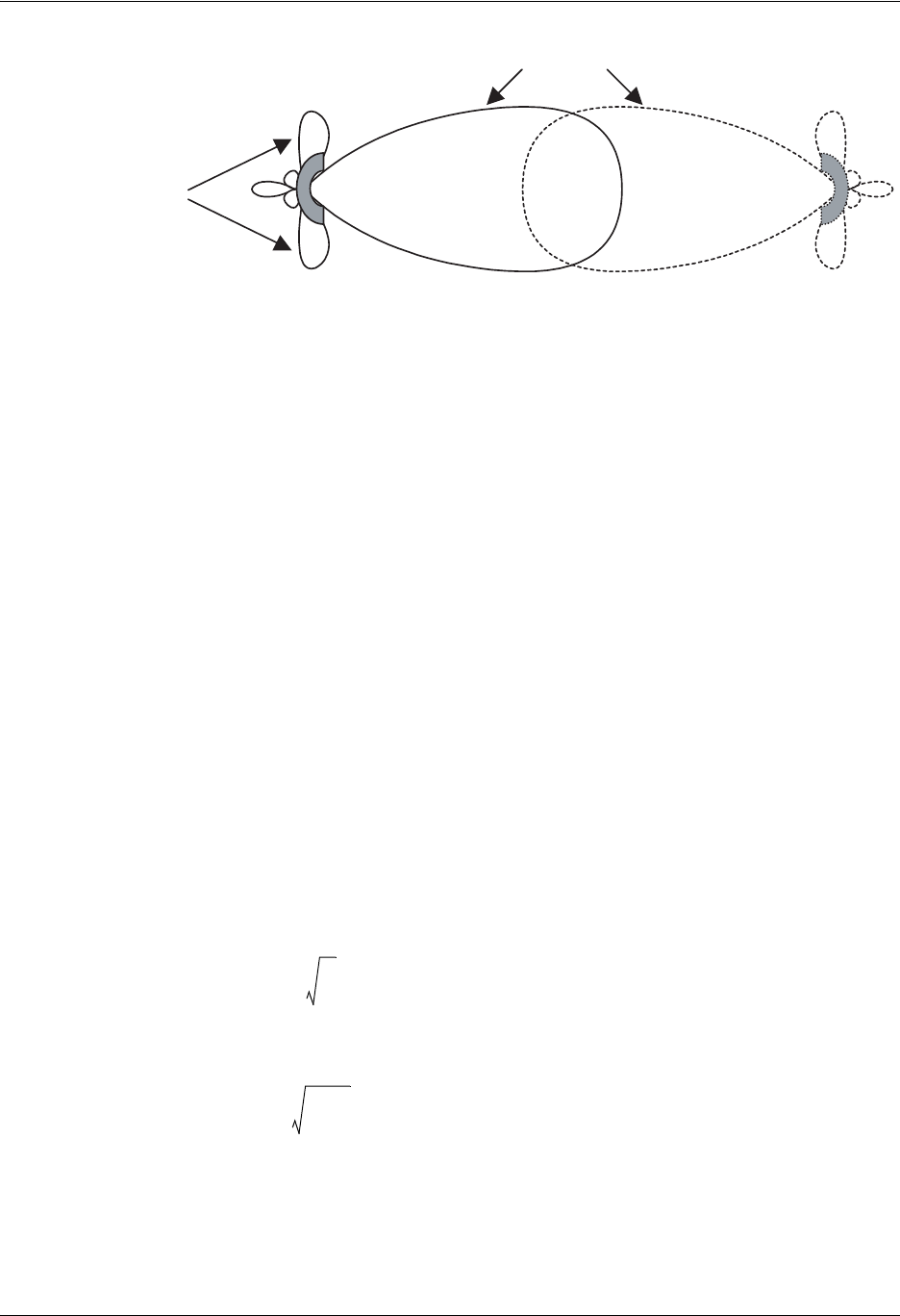
Section 2 Microwave Path Engineering Basics TRACER 6000 Series Split System Manual
24 Copyright © 2005 ADTRAN, Inc. 612806320L1-1A
Figure 2. Typical Antenna Beam Pattern
Antennas are also designed to radiate RF energy efficiently for a specific range of frequencies. Please
consult the data sheet for your particular antenna make and model to ensure that it is specified to operate in
the 5725 MHz to 5850 MHz frequency band for the TRACER 6320 system.
Fresnel Zones, Earth Curvature, and Antenna Heights
Fresnel zones correspond to regions in the microwave path where reflections of the intended signal occur
and combine in both constructive and destructive manners with the main signal, thereby either enhancing
or reducing the net power at the receiver.
In general, the odd numbered Fresnel zones (1, 3, 5, ...) add constructively at the receiver, while the even
numbered Fresnel zones (2, 4, 6, ...) add destructively at the receiver.
The first Fresnel zone corresponds to the main lobe, 60 percent of which must be free of physical
obstructions for the path calculations to be valid. Since the main lobe contains the vast majority of the
microwave energy, this zone is typically used to determine proper antenna heights when placing antennas
on towers or buildings.
The curvature of the Earth becomes a legitimate obstruction for path lengths of 7 miles (11.26 kilometers)
or greater, and must also be accounted for when determining minimum antenna heights.
The aggregate expression for minimum antenna height that incorporates both the 60 percent first Fresnel
zone and the Earth’s curvature is given by
where f is in GHz and d is in miles, or
where f is in GHz and d is in kilometers.
The minimum antenna heights for given path lengths are displayed in Table 7 on page 25 (feet/miles) and
Table 8 on page 25 (meters/kilometers).
main lobe
side lobes
h72.1
d
4f
-----0.125d2
+= (feet)
h21.975 d
6.436f
-------------0.0147d2
+= (meters)

TRACER 6000 Series Split System Manual Section 2 Microwave Path Engineering Basics
612806320L1-1A Copyright © 2005 ADTRAN, Inc. 25
Table 7. Minimum Antenna Height for Given Path Lengths
Path Length
(miles) Min. Antenna Height
(ft)
222
432
641
850
10 60
14 81
16 92
18 104
20 117
22 131
24 145
26 161
28 177
30 194
32 213
34 232
36 252
Table 8. Minimum Antenna Height for Given Path Lengths
Path Length
(kilometers) Min. Antenna Height
(meters)
2 5
4 8
610
811
10 13
14 16
16 18
18 20
20 22
22 24
24 26
26 28
28 31
30 33
32 35
34 38
36 41

Section 2 Microwave Path Engineering Basics TRACER 6000 Series Split System Manual
26 Copyright © 2005 ADTRAN, Inc. 612806320L1-1A
7. OTHER CONSIDERATIONS
Path Availability
The path availability of a wireless link is a metric that expresses the fractional amount of time a link is
available over some fixed amount of time, and depends on several factors. Path availability is expressed as
where the parameters are
aterrain factor
bclimate factor
fcarrier frequency (GHz)
dpath length (miles)
Ffade margin (dB)
or
where the parameters are
aterrain factor
bclimate factor
fcarrier frequency (GHz)
dpath length (kilometers)
Ffade margin (dB)
Terrain Factor (a)
The terrain factor is a quantity that compensates the link availability for different types of terrain.
Generally speaking, the smoother an area’s terrain, the less availability a wireless link running over that
terrain will have, primarily due to multipath reflections. In contrast, secondary microwave signals will be
randomly dispersed over rough terrain and will not interfere with the main signal lobe as badly as in the
smooth terrain case. The terrain factor values normally used are listed below:
Terrain Terrain Factor Description
Smooth 4water, flat desert
Average 1moderate roughness
Mountainous 1/4 very rough, mountainous
A12.510
6–
×
()abfd310 F10
⁄
–
()–[]100%
×
=(%)
A1
6.00 10 7–
×
()abfd310 F10
⁄
–
()–[]100%
×
=(%)

TRACER 6000 Series Split System Manual Section 2 Microwave Path Engineering Basics
612806320L1-1A Copyright © 2005 ADTRAN, Inc. 27
Climate Factor (b)
The climate factor is a quantity that compensates the link availability for different types of climates
(weather). In general, microwave links operating in areas with high humidity will have less availability
than those in arid areas, primarily because water is a dispersive mechanism to microwave energy and
causes the main signal lobe to refract and disperse away from the receiver location. The climate factor
values normally used are listed below:
Climate Climate Factor Description
Very Dry 1/8 desert regions
Temperate 1/4 mainland, interior region
Humid 1/2 humid and coastal regions

Section 2 Microwave Path Engineering Basics TRACER 6000 Series Split System Manual
28 Copyright © 2005 ADTRAN, Inc. 612806320L1-1A

612806320L1-1A Copyright © 2005 ADTRAN, Inc. 29
ENGINEERING GUIDELINES
Provides information to assist network designers with incorporating the TRACER 6000 Series split system
into their networks.
CONTENTS
Equipment Dimensions . . . . . . . . . . . . . . . . . . . . . . . . . . . . . . . . . . . . . . . . . . . . . . . . . . . . . . . . . . 31
Power Requirements . . . . . . . . . . . . . . . . . . . . . . . . . . . . . . . . . . . . . . . . . . . . . . . . . . . . . . . . . . . . 31
Reviewing the Front Panel Design . . . . . . . . . . . . . . . . . . . . . . . . . . . . . . . . . . . . . . . . . . . . . . . . . 31
RSSI Monitoring Interface. . . . . . . . . . . . . . . . . . . . . . . . . . . . . . . . . . . . . . . . . . . . . . . . . . . . . . 32
Front Panel LEDs . . . . . . . . . . . . . . . . . . . . . . . . . . . . . . . . . . . . . . . . . . . . . . . . . . . . . . . . . . . . 32
AUX RS232 Interface (RJ-45). . . . . . . . . . . . . . . . . . . . . . . . . . . . . . . . . . . . . . . . . . . . . . . . . . . 32
CRAFT Port (DB-9). . . . . . . . . . . . . . . . . . . . . . . . . . . . . . . . . . . . . . . . . . . . . . . . . . . . . . . . . . . 33
Reviewing the TRACER 6200 Rear Panel Design . . . . . . . . . . . . . . . . . . . . . . . . . . . . . . . . . . . . . 34
MGMT 10/100BaseT/TX Connection (RJ-45). . . . . . . . . . . . . . . . . . . . . . . . . . . . . . . . . . . . . . . 35
DC Power Connection (Plug-In Terminal Block). . . . . . . . . . . . . . . . . . . . . . . . . . . . . . . . . . . . . 35
Fuse . . . . . . . . . . . . . . . . . . . . . . . . . . . . . . . . . . . . . . . . . . . . . . . . . . . . . . . . . . . . . . . . . . . . . . 35
Alarm Contacts (Plug-In Terminal Block) . . . . . . . . . . . . . . . . . . . . . . . . . . . . . . . . . . . . . . . . . . 35
To ODU Interface (N-Type Connector) . . . . . . . . . . . . . . . . . . . . . . . . . . . . . . . . . . . . . . . . . . . . 36
TRACER 6320 Outdoor Unit (ODU) . . . . . . . . . . . . . . . . . . . . . . . . . . . . . . . . . . . . . . . . . . . . . . . . .36
RSSI Monitoring Interface. . . . . . . . . . . . . . . . . . . . . . . . . . . . . . . . . . . . . . . . . . . . . . . . . . . . . . 37
To IDU. . . . . . . . . . . . . . . . . . . . . . . . . . . . . . . . . . . . . . . . . . . . . . . . . . . . . . . . . . . . . . . . . . . . . 37
Network Module Interfaces . . . . . . . . . . . . . . . . . . . . . . . . . . . . . . . . . . . . . . . . . . . . . . . . . . . . . . . 38
4xE1 Module . . . . . . . . . . . . . . . . . . . . . . . . . . . . . . . . . . . . . . . . . . . . . . . . . . . . . . . . . . . . . . . . 38
4xT1 Module . . . . . . . . . . . . . . . . . . . . . . . . . . . . . . . . . . . . . . . . . . . . . . . . . . . . . . . . . . . . . . . . 39
Quad Ethernet Switch Module . . . . . . . . . . . . . . . . . . . . . . . . . . . . . . . . . . . . . . . . . . . . . . . . . . 40
At-A-Glance Specifications . . . . . . . . . . . . . . . . . . . . . . . . . . . . . . . . . . . . . . . . . . . . . . . . . . . . . . . 40
FIGURES
Figure 1. TRACER 6200 Front Panel Layout . . . . . . . . . . . . . . . . . . . . . . . . . . . . . . . . . . . . . . . . 31
Figure 2. TRACER 6200 Rear Panel . . . . . . . . . . . . . . . . . . . . . . . . . . . . . . . . . . . . . . . . . . . . . . 34
Figure 3. TRACER 6320 ODU Bottom Panel without Integrated Antenna . . . . . . . . . . . . . . . . . . 36
Figure 4. TRACER 6320 ODU Bottom Panel with Integrated Antenna. . . . . . . . . . . . . . . . . . . . . 37
Figure 5. E1 Breakout Panel . . . . . . . . . . . . . . . . . . . . . . . . . . . . . . . . . . . . . . . . . . . . . . . . . . . . . 39
TABLES
Table 1. TRACER 6200 Front Panel Description . . . . . . . . . . . . . . . . . . . . . . . . . . . . . . . . . . . . . 31
Table 2. TRACER 6200 LEDs . . . . . . . . . . . . . . . . . . . . . . . . . . . . . . . . . . . . . . . . . . . . . . . . . . . .32
Table 3. AUX RS232 Pinout . . . . . . . . . . . . . . . . . . . . . . . . . . . . . . . . . . . . . . . . . . . . . . . . . . . . . 33
Table 4. CRAFT Pinout . . . . . . . . . . . . . . . . . . . . . . . . . . . . . . . . . . . . . . . . . . . . . . . . . . . . . . . . . 33
Table 5. Null-Modem Pinout . . . . . . . . . . . . . . . . . . . . . . . . . . . . . . . . . . . . . . . . . . . . . . . . . . . . . 34
Table 6. Rear Panel Description . . . . . . . . . . . . . . . . . . . . . . . . . . . . . . . . . . . . . . . . . . . . . . . . . . 34
Table 7. MGMT 10/100BaseT/TX Interface Pinout . . . . . . . . . . . . . . . . . . . . . . . . . . . . . . . . . . . . 35

Section 3 Engineering Guidelines TRACER 6000 Series Split System Manual
30 Copyright © 2005 ADTRAN, Inc. 612806320L1-1A
Table 8. DC Power Connector Example Pinout . . . . . . . . . . . . . . . . . . . . . . . . . . . . . . . . . . . . . . 35
Table 9. Alarm Contact Connector Pinout . . . . . . . . . . . . . . . . . . . . . . . . . . . . . . . . . . . . . . . . . . . 36
Table 10. ODU Bottom Panel Description . . . . . . . . . . . . . . . . . . . . . . . . . . . . . . . . . . . . . . . . . . . . 37
Table 11. 4xE1 Module DB-25 Connector Pinout . . . . . . . . . . . . . . . . . . . . . . . . . . . . . . . . . . . . . . 38
Table 12. DB-25 to 75Ω Unbalanced Cable Pinout . . . . . . . . . . . . . . . . . . . . . . . . . . . . . . . . . . . . 39
Table 13. 4xT1 Module RJ-45 Connector Pinout . . . . . . . . . . . . . . . . . . . . . . . . . . . . . . . . . . . . . . 40
Table 14. Quad Ethernet Switch RJ-45 Connector Pinout . . . . . . . . . . . . . . . . . . . . . . . . . . . . . . . 40
Table 15. At-A-Glance Specifications . . . . . . . . . . . . . . . . . . . . . . . . . . . . . . . . . . . . . . . . . . . . . . .41

TRACER 6000 Series Split System Manual Section 3 Engineering Guidelines
612806320L1-1A Copyright © 2005 ADTRAN, Inc. 31
1. EQUIPMENT DIMENSIONS
The TRACER 6200 Indoor Unit (IDU) is 17.2-inch (43.7 cm) W, 11.4-inch (28.9 cm) D, and 1.7-inch
(4.4 cm) H, weighs 5 lbs (2.3 kg), and can be used in rackmount configurations. The Outdoor Unit (ODU)
is 10.24-inch (26.01 cm) W, 4.78-inch (12.14 cm) D, and 12.74-inch (32.36 cm) H, weighs 9.5 lbs (4.3 kg),
and can be mounted using standard U-bolts.
2. POWER REQUIREMENTS
The TRACER 6000 Series system has a maximum power consumption of 25 W and a maximum current
draw of 1.8 A (at 21 VDC).
3. REVIEWING THE FRONT PANEL DESIGN
The TRACER 6200 front panel contains an RSSI monitoring interface, a GND interface for reference
with RSSI, a TEST interface for factory use only, a DB-9 CRAFT port for management and configuration,
and an AUX RS232 interface (RJ-45) that provides an end-to-end serial port interface (at 9600 bps), and
status LEDs to provide visual information about the TRACER system. Figure 1 identifies the various
interfaces and the LEDs and Table 1 provides a brief description of each interface.
Figure 1. TRACER 6200 Front Panel Layout
Table 1. TRACER 6200 Front Panel Description1
1 Detailed discussions (including pinouts) of front panel components (where applicable) follow the table.
Name Connector Description
ARSSI bantam DC voltage indicating strength of the received signal at the
antenna
BStatus LEDs N/A Visual status information about the system
CGND bantam Ground reference for the RSSI interface
DTest 3.5 mm mini-jack Factory use only
EAUX RS232 RJ-45 Serial interface for a 9600 bps connection between the
local and remote systems over the RF link
FCRAFT PORT DB-9 RS-232 interface for connection to a VT100 terminal or PC
with terminal emulation software
TRACER 6200
B
C
A
E F
D

Section 3 Engineering Guidelines TRACER 6000 Series Split System Manual
32 Copyright © 2005 ADTRAN, Inc. 612806320L1-1A
RSSI Monitoring Interface
The RSSI voltage is a function of the signal strength at the receiver and is used to measure the received
signal strength. RSSI varies from approximately 0 to 5 VDC. An RSSI calibration sheet is shipped with the
system to provide the installer a cross-reference between actual received signal level (in dBm) and RSSI
voltage. This sheet is useful for verifying link budget calculations and ensuring proper equipment
installation.
Front Panel LEDs
With the TRACER 6200 powered-on, the front panel LEDs provide visual information about the status of
the TRACER system. Table 2 provides detailed information about the LEDs.
AUX RS232 Interface (RJ-45)
The AUX RS232 interface provides a female RJ-45 terminal connection (wired as a DCE interface), which
is used for a 9600 bps point-to-point connection between the local and remote systems (over the RF link).
Table 3 on page 33 shows the pinout.
Table 2. TRACER 6200 LEDs
For these LEDs... This color light... Indicates that...
PWR Green (solid) the system is connected to a power source.
Off the system is not currently powered up.
TST Amber (flashes once) power-up self-test is in progress. If the LED continuously flashes
or remains on (solid) after 10 seconds, the unit has failed
self-test.
STATUS
MOD1 and MOD2 Green the module in installed and functioning properly.
Red (solid) a port on the installed module is currently in alarm.
Off no module occupies the slot.
PLAN A Green (solid) the system is transmitting on Frequency Plan A.
Off the system is not transmitting on Frequency Plan A.
PLAN B Green (solid) the system is transmitting on Frequency Plan B.
Off the system is not transmitting on Frequency Plan B.
RF LOW Red (solid) the RSSI level is below suggested minimum threshold
(approximately 10 dBm above the minimum receive sensitivity).
RF DWN Red (solid) there is a communication problem between the local and remote
systems.
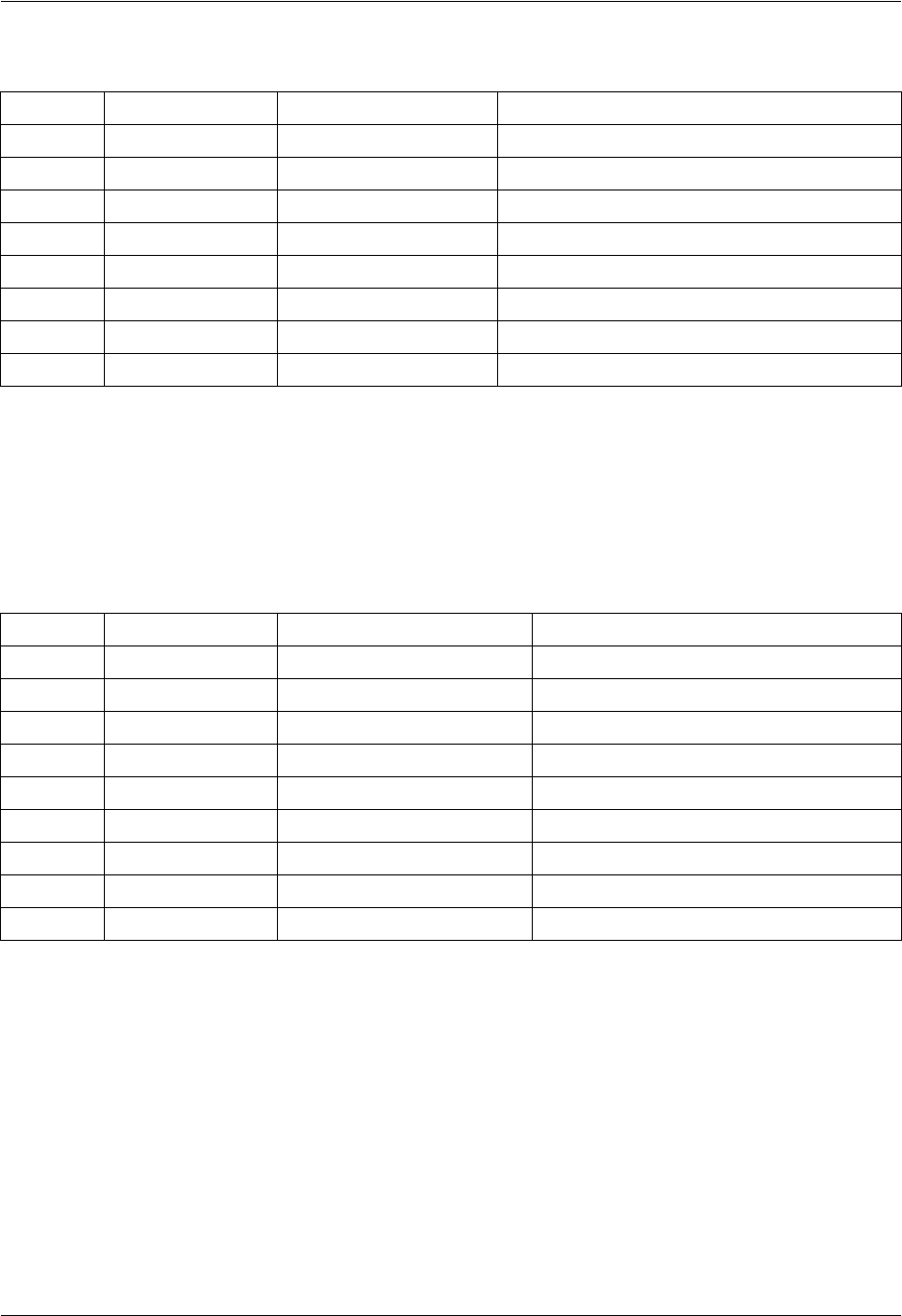
TRACER 6000 Series Split System Manual Section 3 Engineering Guidelines
612806320L1-1A Copyright © 2005 ADTRAN, Inc. 33
CRAFT Port (DB-9)
The CRAFT connector provides a female DB-9 terminal connection (wired as a DCE interface), which is
used for terminal access to the TRACER system. Table 4 shows the pinout. A null modem cable is
necessary for connecting the CRAFT port to a modem for remote dial-up access. Table 5 on page 34 shows
the pinout for a null modem cable.
Table 3. AUX RS232 Pinout
Pin Name Source Description
1GNDCommon Signal ground
2RTS Attached Equipment Request to send (unused)
3TXDATAAttached Equipment Transmit data (from attached equipment)
4DSR TRACER Data set ready
5RXDATATRACER Received data (to attached equipment)
6CTS TRACER Clear to send
7DTR Attached Equipment Data terminal ready (unused)
8CD TRACER Carrier detect
Table 4. CRAFT Pinout
Pin Name Source Description
1 CD TRACER Carrier detect
2 RXDATA TRACER Received data (to attached equipment)
3 TXDATA Attached Equipment Transmit data (from attached equipment)
4 DTR Attached Equipment Data terminal ready (unused)
5 GND Common Signal ground
6 DSR TRACER Data set ready
7 RTS Attached Equipment Request to send (unused)
8 CTS TRACER Clear to send
9 RI TRACER Ring indicator (unused)
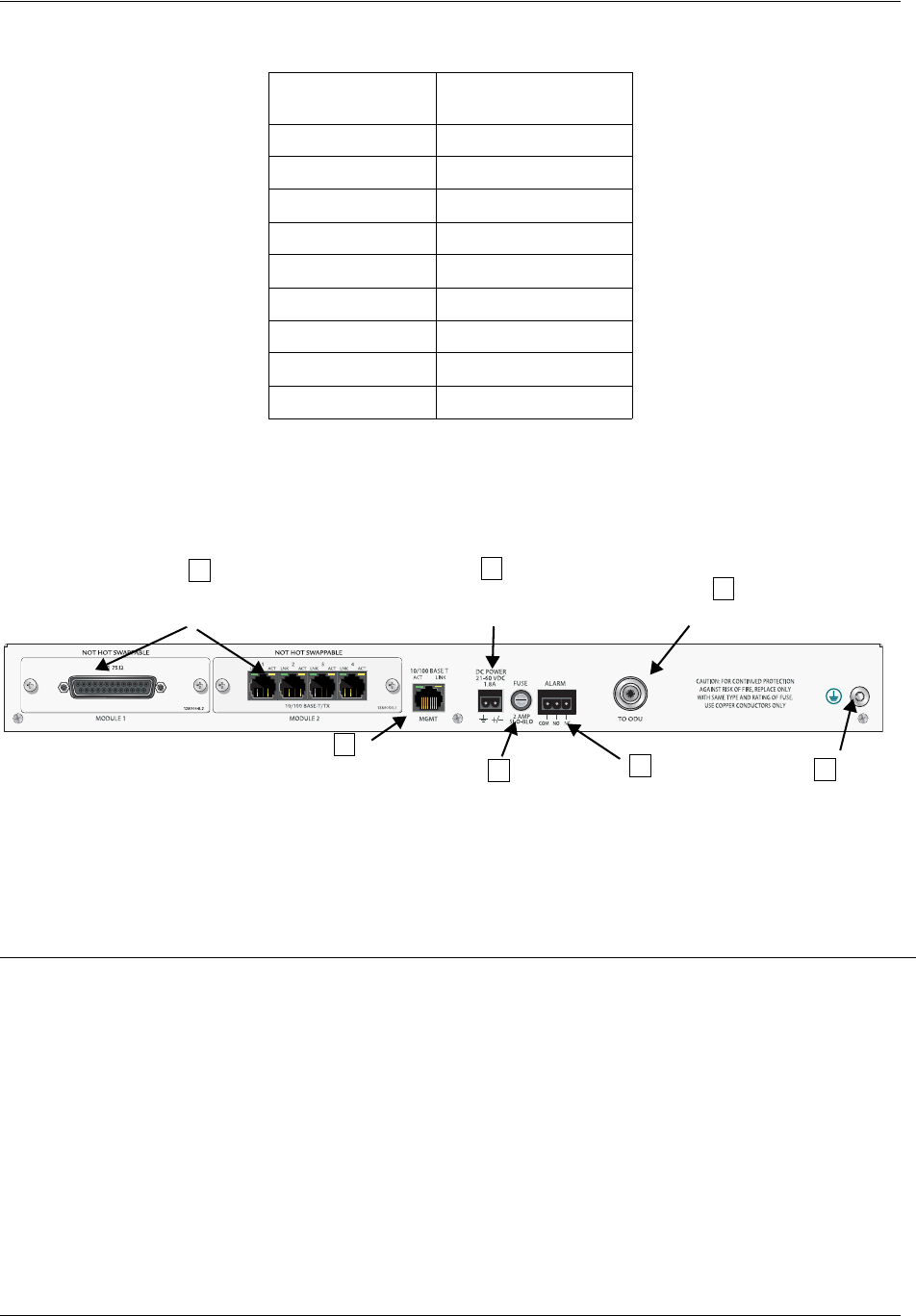
Section 3 Engineering Guidelines TRACER 6000 Series Split System Manual
34 Copyright © 2005 ADTRAN, Inc. 612806320L1-1A
4. REVIEWING THE TRACER 6200 REAR PANEL DESIGN
Figure 2 identifies the features of the TRACER 6200 rear panel, and Table 6 provides a brief description of
each interface.
Figure 2. TRACER 6200 Rear Panel
Table 5. Null-Modem Pinout
Modem
Pin TRACER
Pin
1 (CD) Unconnected
2 (RXD) 3 (TXD)
3 (TXD) 2 (RXD)
4 (DTR) 6 (DSR)
5 (GND) 5 (GND)
6 (DSR) 4 (DTR)
7 (RTS) 8 (CTS)
8 (CTS) 7 (RTS)
9 (RI) Unconnected
Table 6. Rear Panel Description1
1 Detailed discussions (including pinouts) of rear panel components (where applicable) follow the table.
Name Connector Description
ANetwork Module
Slots N/A Dual network module slots for system flexibility (shown with an
E1 and Ethernet Switch module installed)
BMGMT RJ-45 10/100BaseT/TX Ethernet interface for SNMP, TFTP, and Telnet
access
CDC Power Terminal block 21 to 60 VDC power source connection
DFuse N/A 2A, 250 V, 2-inch slo-blo fuse
EAlarm Terminal block External alarm monitoring system connection
FAntenna N-type Antenna feedline cable connection
GGround Lug N/A Earth ground connection
To ODU
DC Power
Connection
Ground
Lug
Fuse Alarm
Contacts
CF
BE
DG
Ethernet
Interface
Network
Module Slots
A
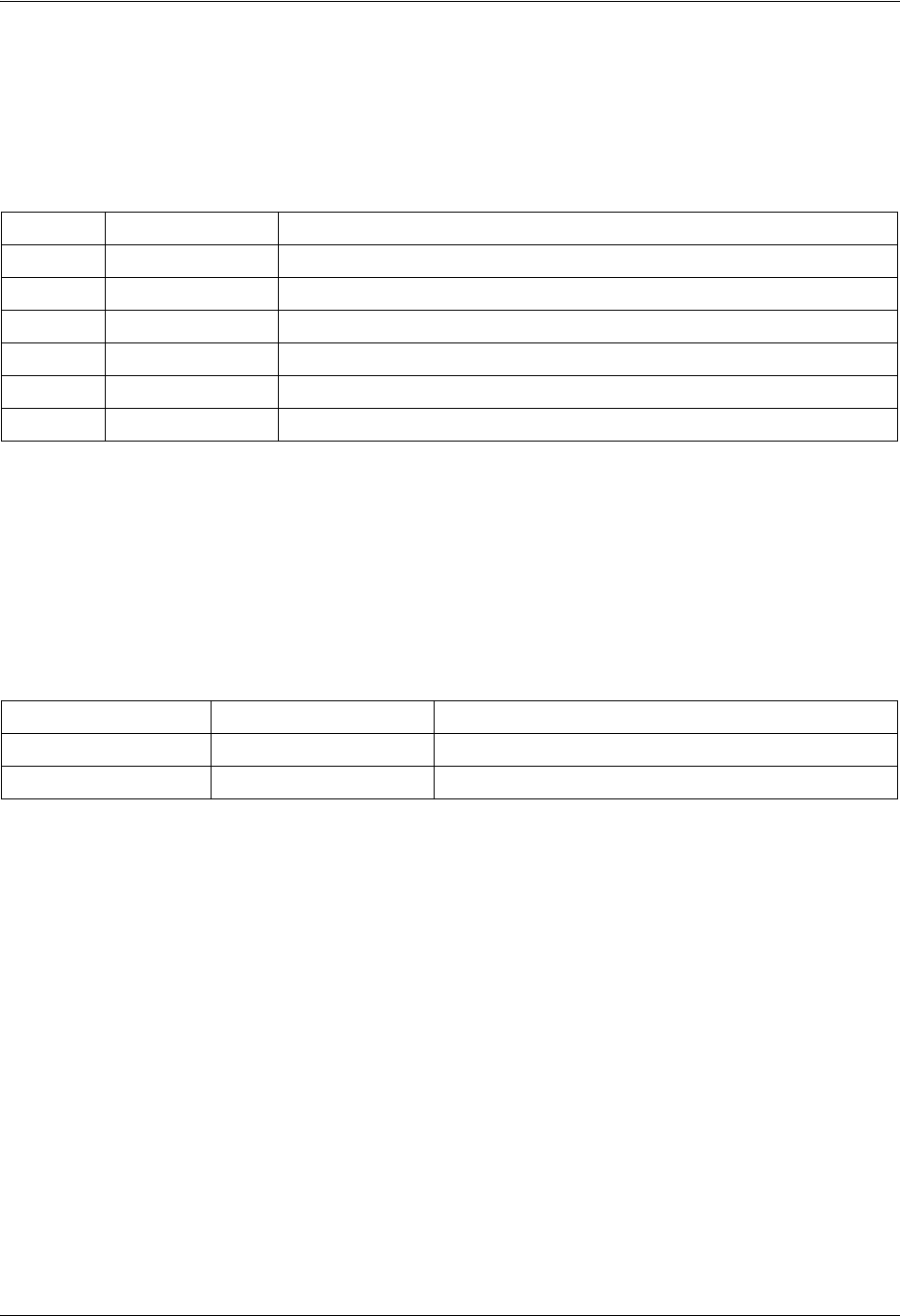
TRACER 6000 Series Split System Manual Section 3 Engineering Guidelines
612806320L1-1A Copyright © 2005 ADTRAN, Inc. 35
MGMT 10/100BaseT/TX Connection (RJ-45)
The physical Ethernet interface is provided by a single RJ-45 jack (labeled MGMT) that delivers
10/100BaseT/TX for LAN connectivity. The MGMT port is used for Telnet, SNMP, and TFTP access and
is not a router interface. Each port has a green LINK LED to indicate a valid link and an amber ACT LED
that blinks with data activity on the interface. Table 7 shows the pinout.
DC Power Connection (Plug-In Terminal Block)
The TRACER 6200 can operate from a supply between 21 and 60 VDC, with either polarity referenced to
ground, and consumes less than 25 W. Power supplies should be able to provide up to 25 W at the selected
voltage. Current required (in amps) is determined by dividing the power consumed (in watts) by the
applied voltage (in volts). For example, at 48 V, TRACER 6200 would draw approximately 0.52 A
(25 W/48 V). Table 8 shows the DC power connection pinout.
Fuse
The fuse holder, accessible from the rear panel of the TRACER 6200, accepts a generic 2 A, 250 V, 2-inch
slow-blo fuse.
Alarm Contacts (Plug-In Terminal Block)
An RF link down condition is indicated with both normally open (NO) and normally closed (NC) alarm
contacts on the rear panel of the TRACER 6200 system. In normal operation, the NC contact is electrically
connected to the common contact (COM) and the NO contact is isolated. When the RF link drops, the NC
contact becomes isolated and the NO is electrically connected to COM. This allows RF down conditions
to be reported to external alarm monitoring systems. Table 9 on page 36 provides the alarm contact pinout.
Table 7. MGMT 10/100BaseT/TX Interface Pinout
Pin Name Description
1TX1 Transmit positive
2TX2 Transmit negative
3RX1 Receive positive
4,5 —Unused
6RX2 Receive negative
7, 8 —Unused
Table 8. DC Power Connector Example Pinout
Pin Name Description
1+/– Voltage
2GND Ground
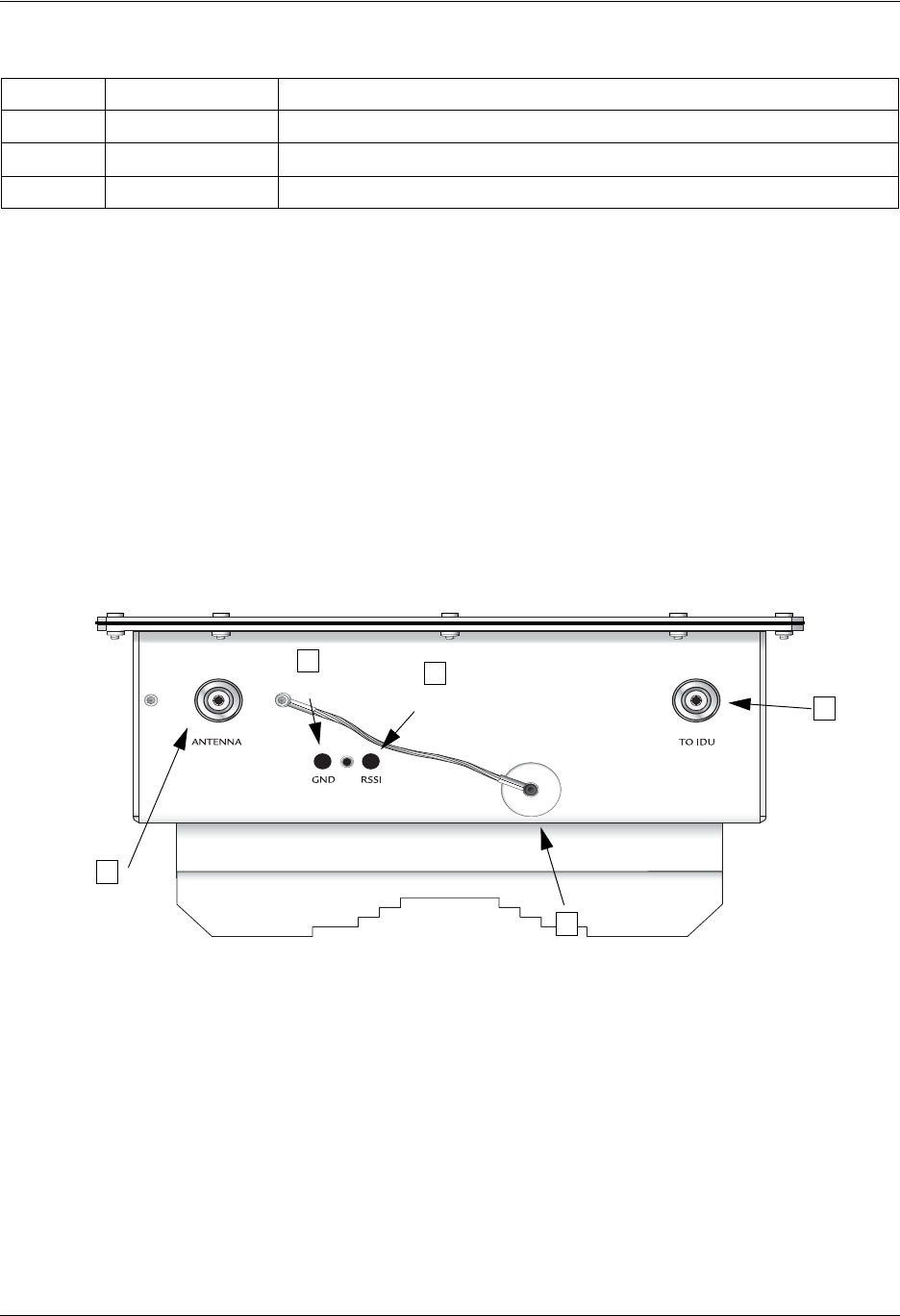
Section 3 Engineering Guidelines TRACER 6000 Series Split System Manual
36 Copyright © 2005 ADTRAN, Inc. 612806320L1-1A
To ODU Interface (N-Type Connector)
The TO ODU interface (N-type connector) is the IDU-side IF connection between the IDU and ODU. The
IDU transmits payload data to the ODU on a 280 MHz carrier and receives the ODU data on a 140 MHz
carrier. The IF connection also provides a full-duplex control and monitoring channel between the IDU and
ODU on a 4.5 MHz carrier. Additionally, this interface provides DC power to the ODU, taken directly
from the voltage supplied to the power connection on the rear of the IDU. The power supply is protected
from a short-circuit on the IDU/ODU connection via a thermal protection device.
5. TRACER 6320 OUTDOOR UNIT (ODU)
Figure 3 identifies the features of the TRACER 6320 ODU bottom panel without the integrated antenna
(Figure 4 on page 37 shows the system with the integrated antenna) and Table 10 on page 37 provides a
brief description of each interface.
Figure 3. TRACER 6320 ODU Bottom Panel without Integrated Antenna
Table 9. Alarm Contact Connector Pinout
Pin Name Description
1 COM Common Contact
2NO Normally-Open Contact
3NC Normally-Closed Contact
Antenna
Connector
A
GND
B
RSSI
C
Weather-proof
Cover for RSSI and GND
D
Connection
to IDU
E
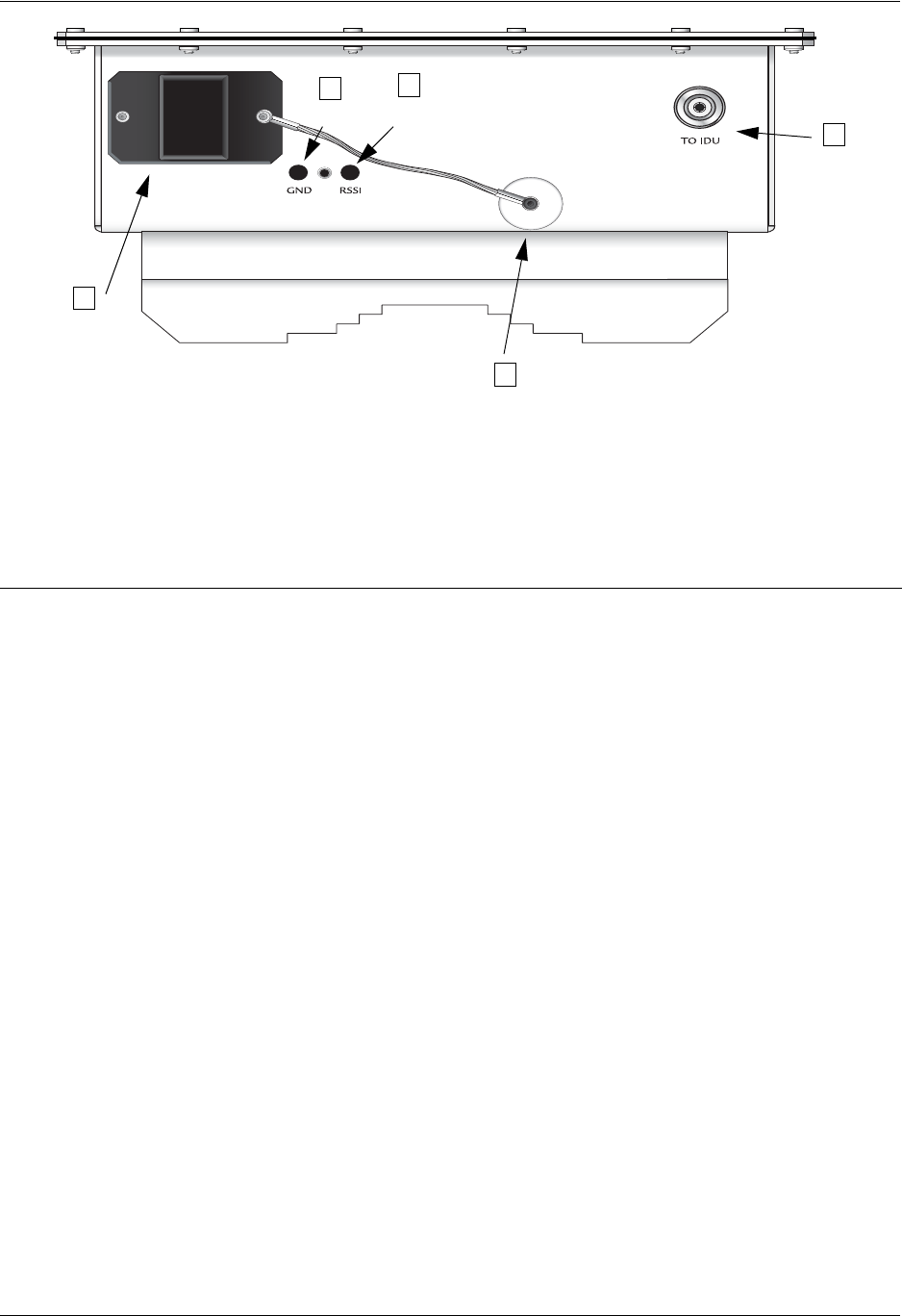
TRACER 6000 Series Split System Manual Section 3 Engineering Guidelines
612806320L1-1A Copyright © 2005 ADTRAN, Inc. 37
Figure 4. TRACER 6320 ODU Bottom Panel with Integrated Antenna
RSSI Monitoring Interface
The RSSI voltage is a function of the signal strength at the receiver and is used to measure the received
signal strength. RSSI varies from approximately 0 to 5 VDC. An RSSI calibration sheet is shipped with the
system to provide the installer a cross-reference between actual received signal level (in dBm) and RSSI
voltage. This sheet is useful for verifying link budget calculations and ensuring proper equipment
installation.
To IDU
The TO IDU interface (N-type connector) is the ODU-side IF connection between the IDU and ODU. The
ODU transmits payload data to the IDU on a 140 MHz carrier and receives the IDU data on a 280 MHz
carrier. The IF connection also provides a full-duplex control and monitoring channel between the IDU and
ODU on a 4.5 MHz carrier. Additionally, this interface accepts DC power from the IDU, taken directly
from the voltage supplied to the power connection on the rear of the IDU. The power supply is protected
from a short-circuit on the IDU/ODU connection via a thermal protection device.
Table 10. ODU Bottom Panel Description
Name Connector Description
AIntegrated
Antenna N/A Integrated antenna for some international applications
(when applicable)
OR
Antenna N-type (female) Antenna feedline cable connection
BGND Bantam Ground reference for the RSSI interface
CRSSI Bantam DC voltage indicating strength of the received signal at the
antenna
DCover N/A Weather-proof (removable) cover for protecting GND and
RSSI interfaces
ETo IDU N-type Feedline cable for connecting to the Indoor Unit
Integrated
Antenna
A
GND
BRSSI
C
Weather-proof
Cover for RSSI and GND
D
Connection
to IDU
E

Section 3 Engineering Guidelines TRACER 6000 Series Split System Manual
38 Copyright © 2005 ADTRAN, Inc. 612806320L1-1A
6. NETWORK MODULE INTERFACES
4xE1 Module
The 4xE1 network module provides four E1 interfaces (through a single DB-25 interface) that provide the
following functions:
• AMI or HDB3 coding
• Framed, multi-framed, and unframed framing support
• Network performance monitoring and reporting
• Test loopbacks (both line and link)
Table 11 provides the DB-25 interface pinout for the 4xE1 network module. A separate breakout panel is
available to provide 75Ω BNC unbalanced interfaces (see Table 12 on page 39 for the pinout of the 75Ω
cable). Figure 5 displays the E1 breakout panel.
Table 11. 4xE1 Module DB-25 Connector Pinout
Pin Name Description
1 E1D RX TIP Receive signal for E1 D interface
2 E1D TX TIP Output signal for E1 D interface
3 GND Ground
4 E1C RX TIP Receive signal for E1 C interface
5 E1C TX TIP Output signal for E1 C interface
6 GND Ground
7 E1B TX TIP Output signal for E1 B interface
8 E1B TX TIP Output signal for E1 B interface
9 GND Ground
10 E1A TX TIP Output signal for E1 A interface
11 E1A TX TIP Output signal for E1 A interface
12-25 GND Ground
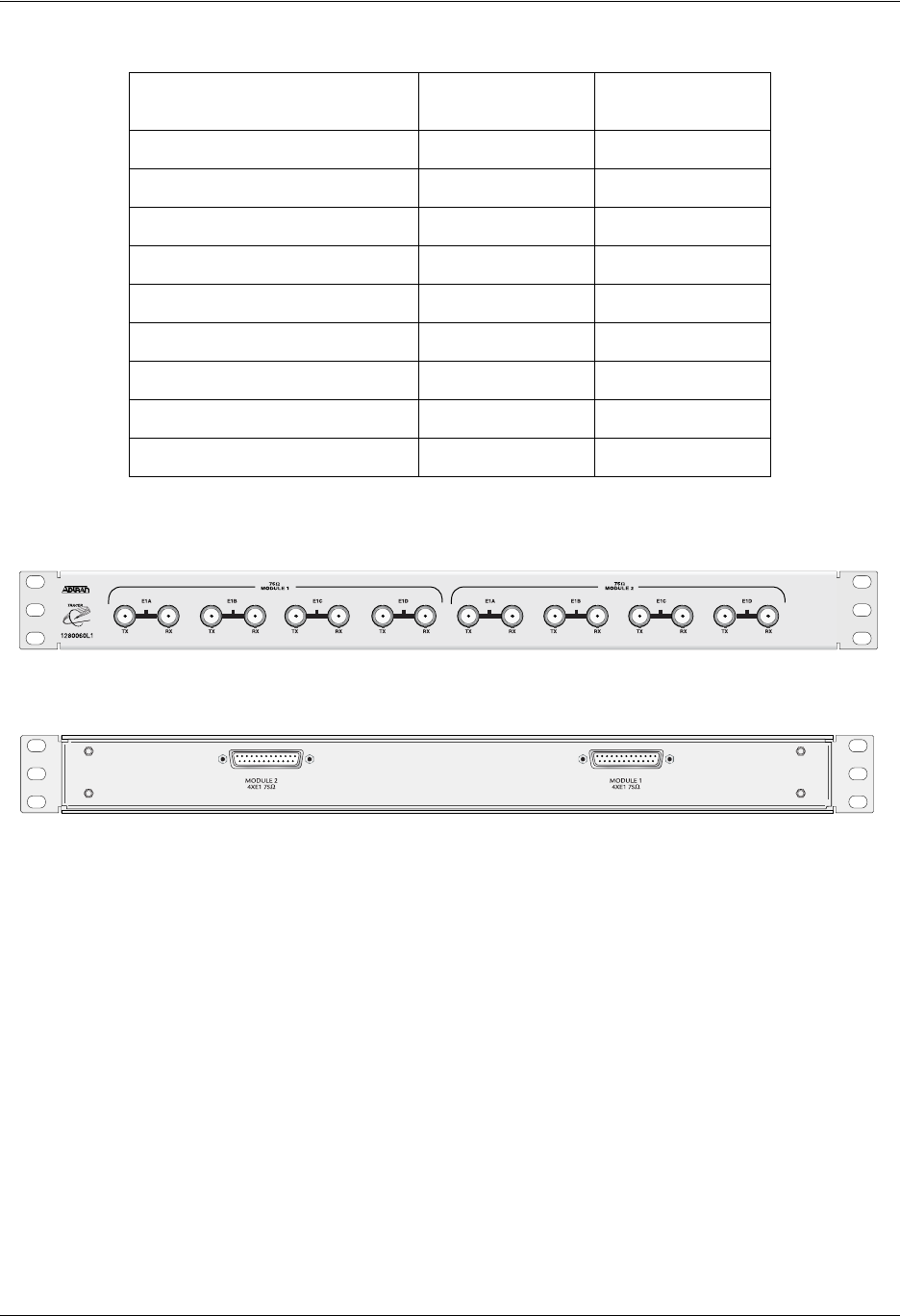
TRACER 6000 Series Split System Manual Section 3 Engineering Guidelines
612806320L1-1A Copyright © 2005 ADTRAN, Inc. 39
Figure 5. E1 Breakout Panel
4xT1 Module
The 4xT1 network module has four T1 interfaces (through four RJ-45 ports) that provide the following
functions:
• ANSI T1.403 and AT&T® 54016 and 62411 compliant
• AMI or B8ZS coding
• Extended Super Frame (ESF) and Super Frame (SF) framing support
• Manual line build out
• Network performance monitoring and reporting
• Test loopbacks (both line and link)
Table 12. DB-25 to 75Ω Unbalanced Cable Pinout
E1 Cable Interface DB-25 Male
(TRACER Side) DB-25 Male
(Breakout Panel)
Channel 1 Input 10 14
Channel 1 Output 11 3
Channel 2 Input 717
Channel 2 Output 8 6
Channel 3 Input 420
Channel 3 Output 5 9
Channel 4 Input 123
Channel 4 Output 212
Ground All other pins All other pins

Section 3 Engineering Guidelines TRACER 6000 Series Split System Manual
40 Copyright © 2005 ADTRAN, Inc. 612806320L1-1A
Table 13 provides the RJ-45 interface pinout for the 4xT1 network module.
Quad Ethernet Switch Module
The Quad Ethernet Switch module has four 10/100BaseTX interfaces (through four RJ-45 ports) that
provide the following functions:
• IEEE 802.3 and 802.3u compliant
• Auto MDI/MDIX crossover
• Back-pressure flow control on all full-duplex interfaces
• Link and activity LEDs for each port
Table 14 provides the RJ-45 interface pinout for the Quad Ethernet Switch module.
7. AT-A-GLANCE SPECIFICATIONS
Table 15 on page 41 contains a list of specifications for the TRACER 6000 Series split system.
Table 13. 4xT1 Module RJ-45 Connector Pinout
Pin Name Description
1 R Transmit data (ring) towards the network
2 T Transmit data (tip) towards the network
3, 6-8 UNUSED —
4 R1 Receive data (ring) toward the network
5 T1 Receive data (tip) from the network
Table 14. Quad Ethernet Switch RJ-45 Connector Pinout
Pin Name Source Description
1 RX1 Attached Equipment Receive Positive
2 RX2 Attached Equipment Receive Negative
3 TX1 Module Transmit Positive
4, 5 UNUSED N/A —
6 TX2 Module Transmit Negative
7, 8 UNUSED N/A —

TRACER 6000 Series Split System Manual Section 3 Engineering Guidelines
612806320L1-1A Copyright © 2005 ADTRAN, Inc. 41
Table 15. At-A-Glance Specifications
Hardware Description Specification
Transmitter
Output Power +20 dBm, maximum
EIRP
(For models with integrated antenna) +33 dBm, maximum
Frequency Range 5725 to 5850 MHz
Receiver
Receive Level,
Minimum -85 dBm @ 8xT1
-89 dBm @ 4xT1
-92 dBm @ 2xT1
-83 dBm @ 8xE1/16Mbps Ethernet
-87 dBm @ 4xE1/8 Mbps Ethernet
-90 dBm @ 2xE1/4 Mbps Ethernet
Receive Level, Maximum -30 dBm
Receive Level, Nominal -55 dBm
Intermediate Frequencies (IF)
IDU to ODU 280 MHz
ODU to IDU 140 MHz
Frequency Plan
Plan A
Channel Plan
1Tx 5.744 GHz, Rx 5.824 GHz
2Tx 5.747 GHz, Rx 5.827 GHz
3Tx 5.751 GHz, Rx 5.831 GHz
Plan B
Channel Plan
1Tx 5.824 GHz, Rx 5.744 GHz
2Tx 5.827 GHz, Rx 5.747 GHz
3Tx 5.831 GHz, Rx 5.751 GHz
Data Encryption
Encryption Type Symmetric Triple-DES (3DES)
User Interface
Panel Alarm LEDs
Diagnostics RF link diagnostics and error history, transmit and
receive packets history
Test Points RSSI and Ground (GND)
Alarms Normally Open (NO) and Normally Closed (NC)

Section 3 Engineering Guidelines TRACER 6000 Series Split System Manual
42 Copyright © 2005 ADTRAN, Inc. 612806320L1-1A
User Interface
VT100 Terminal Menu driven user interface, control of the remote end,
event history
Telnet Access Menu driven user interface, control of the remote end,
event history
SNMP Standard MIB support (T1/E1 and Ether-like MIBs);
Enterprise MIB support (ADTRAN TRACER MIB)
VT100 Terminal Interface
Data Rate 9600, 19200, 38400, 57600, 115200 bps
Data Bits 8
Parity None
Stop Bits 1
Terminal Emulation VT100
Mechanical and Environmental (IDU)
Operating Temperature -25°C to 65°C
Size 1.7-inch (4.4 cm) H
17.2-inch (43.7 cm) W
11.4-inch (28.9 cm) D
Humidity 95 percent, Noncondensing
Weight 5 lbs (2.3 kg)
Mechanical and Environmental (ODU)
Operating Temperature -40°C to 65°C
Size 12.74-inch (32.36 cm) H
10.24-inch (26.01 cm) W
4.78-inch (12.14 cm) D
Humidity 95 percent, Noncondensing
Weight 9.5 lbs (4.3 kg)
Power
Input Voltage 21 to 60 VDC, either polarity referenced to ground
Power Consumption < 25 W
Connector 2-pin terminal block (DC)
Fuse 2 A, 250 V slow-blo fuse (2-inch)
Table 15. At-A-Glance Specifications (Continued)
Hardware Description Specification

TRACER 6000 Series Split System Manual Section 3 Engineering Guidelines
612806320L1-1A Copyright © 2005 ADTRAN, Inc. 43
Network Modules
Quad E1 Module Connection Single DB-25 connector on module; 75Ω unbalanced
interface available using BNC breakout panel
Capacity 4xE1 (CCITT G.703)
Line Code HDB3 (default), AMI
Alarms LOS, LCV, AIS, RMT, OOF, CRC
Loopbacks Local and remote line and link
Quad T1 Module Connection Four RJ-45 interfaces
Capacity 4xT1 (ANSI T1.403, AT&T® 54016 and 62411)
Line Code B8ZS (default), AMI
Alarms AIS, Red, Yellow, BPVs, LOS
Quad Ethernet
Switch Module
Connection Four RJ-45 interfaces
Interface Type Four 10BaseT/100BaseTX interfaces with auto
MDI/MIDX crossover
Flow Control Back-pressure flow control on half-duplex interfaces
Pause-frame flow control on full-duplex interfaces
Table 15. At-A-Glance Specifications (Continued)
Hardware Description Specification

Section 3 Engineering Guidelines TRACER 6000 Series Split System Manual
44 Copyright © 2005 ADTRAN, Inc. 612806320L1-1A

612806320L1-1A Copyright © 2005 ADTRAN, Inc. 45
NETWORK TURNUP PROCEDURE
Provides shipment contents list, grounding instructions, mounting options, and specifics of supplying
power to the unit.
CONTENTS
Introduction . . . . . . . . . . . . . . . . . . . . . . . . . . . . . . . . . . . . . . . . . . . . . . . . . . . . . . . . . . . . . . . . . . . . 46
Tools Required . . . . . . . . . . . . . . . . . . . . . . . . . . . . . . . . . . . . . . . . . . . . . . . . . . . . . . . . . . . . . . . . . 46
Unpack and Inspect the System . . . . . . . . . . . . . . . . . . . . . . . . . . . . . . . . . . . . . . . . . . . . . . . . . . . 46
Contents of Shipment . . . . . . . . . . . . . . . . . . . . . . . . . . . . . . . . . . . . . . . . . . . . . . . . . . . . . . . . . 46
Customer Provides . . . . . . . . . . . . . . . . . . . . . . . . . . . . . . . . . . . . . . . . . . . . . . . . . . . . . . . . . . . 47
Channel Selection . . . . . . . . . . . . . . . . . . . . . . . . . . . . . . . . . . . . . . . . . . . . . . . . . . . . . . . . . . . . . . 47
Grounding Instructions . . . . . . . . . . . . . . . . . . . . . . . . . . . . . . . . . . . . . . . . . . . . . . . . . . . . . . . . . . 48
Supplying Power to the Unit . . . . . . . . . . . . . . . . . . . . . . . . . . . . . . . . . . . . . . . . . . . . . . . . . . . . . . 49
Mounting Options . . . . . . . . . . . . . . . . . . . . . . . . . . . . . . . . . . . . . . . . . . . . . . . . . . . . . . . . . . . . . . . 49
Indoor Unit (IDU). . . . . . . . . . . . . . . . . . . . . . . . . . . . . . . . . . . . . . . . . . . . . . . . . . . . . . . . . . . . . 49
Outdoor Unit (ODU) . . . . . . . . . . . . . . . . . . . . . . . . . . . . . . . . . . . . . . . . . . . . . . . . . . . . . . . . . . 51
Installing Modules . . . . . . . . . . . . . . . . . . . . . . . . . . . . . . . . . . . . . . . . . . . . . . . . . . . . . . . . . . . . . . 52
Instructions for Installing Network Modules. . . . . . . . . . . . . . . . . . . . . . . . . . . . . . . . . . . . . . . . . 53
Connecting the Module Interfaces . .. . . . . . . . . . . . . . . . . . . . . . . . . . . . . . . . . . . . . . . . . . . . . . . .53
Quad T1 Module Interfaces. . . . . . . . . . . . . . . . . . . . . . . . . . . . . . . . . . . . . . . . . . . . . . . . . . . . . 53
Quad E1 Module Interfaces . . . . . . . . . . . . . . . . . . . . . . . . . . . . . . . . . . . . . . . . . . . . . . . . . . . . 53
Quad Ethernet Switch Module . . . . . . . . . . . . . . . . . . . . . . . . . . . . . . . . . . . . . . . . . . . . . . . . . . 54
FIGURES
Figure 1. 5.8 GHz Bandwidth Division (TRACER 6320) . . . . . . . . . . . . . . . . . . . . . . . . . . . . . . . . 48
Figure 2. 19-inch Rackmount Illustration. . . . . . . . . . . . . . . . . . . . . . . . . . . . . . . . . . . . . . . . . . . . 50
Figure 3. 23-inch Rackmount Illustration. . . . . . . . . . . . . . . . . . . . . . . . . . . . . . . . . . . . . . . . . . . . 51
Figure 4. Mounting the Outdoor Unit (ODU) . . . . . . . . . . . . . . . . . . . . . . . . . . . . . . . . . . . . . . . . . 52
Figure 5. TRACER 6200 Network Module Slot Designation . . . . . . . . . . . . . . . . . . . . . . . . . . . . . 52
Figure 6. E1 Connection with Breakout Panel. . . . . . . . . . . . . . . . . . . . . . . . . . . . . . . . . . . . . . . . 54
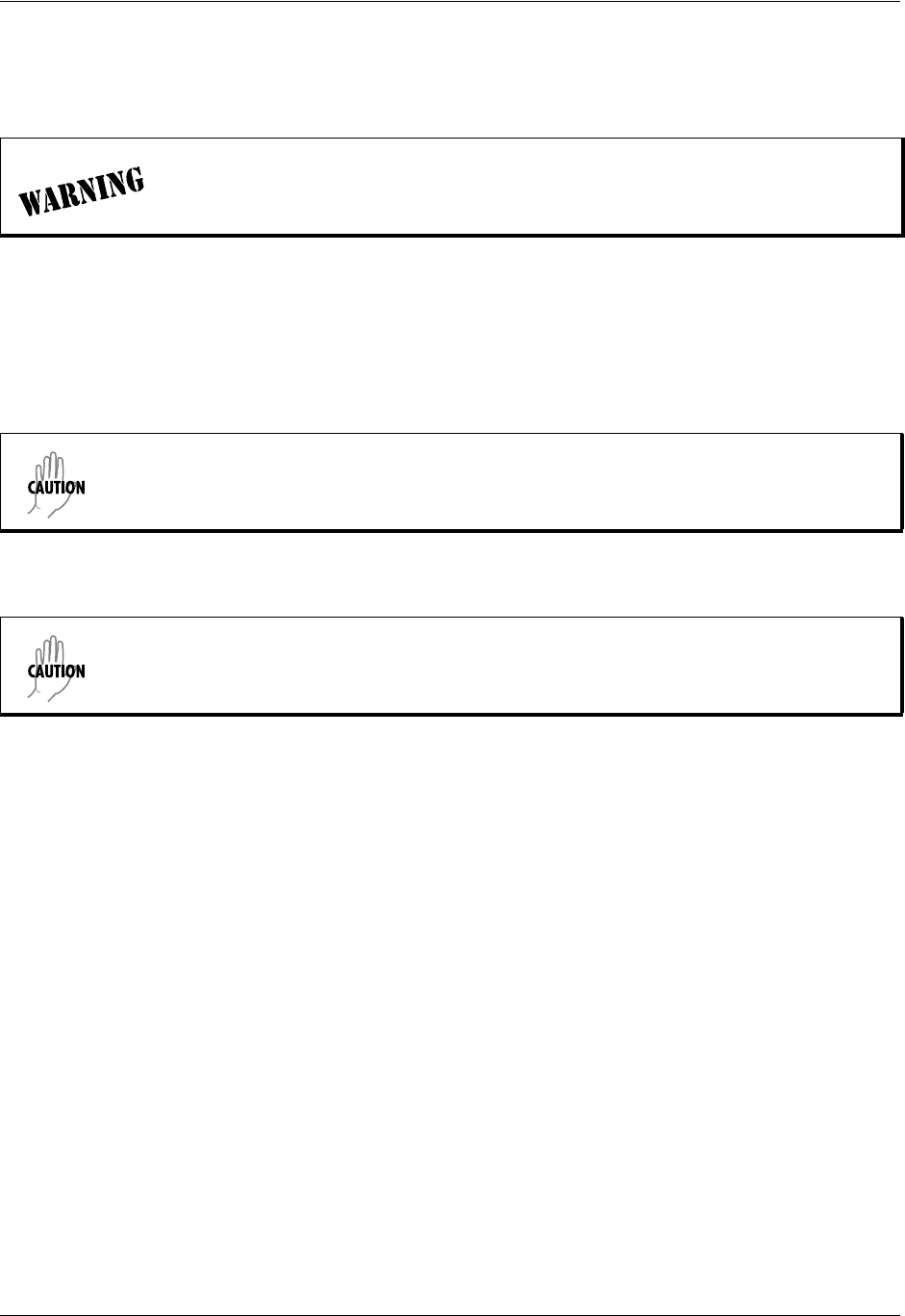
Section 4 Network Turnup Procedure TRACER 6000 Series Split System Manual
46 Copyright © 2005 ADTRAN, Inc. 612806320L1-1A
1. INTRODUCTION
This section discusses TRACER 6000 Series split system installation.
2. TOOLS REQUIRED
The tools required for TRACER 6000 Series split system installation are:
• VT100 terminal or PC with terminal emulation software
• RS-232 (DB-9 male for TRACER 6200) cable for connecting to terminal
3. UNPACK AND INSPECT THE SYSTEM
Each TRACER 6000 Series split system is shipped in its own cardboard shipping carton. Open each carton
carefully and avoid deep penetration into the carton with sharp objects.
After unpacking the unit, inspect it for possible shipping damage. If the equipment has been damaged in
transit, immediately file a claim with the carrier; then contact ADTRAN Customer Service (see Warranty,
Customer Service, Product Support Information, and Training information in the front of this manual).
Contents of Shipment
Your TRACER 6200 IDU shipment includes the following items:
• TRACER 6200 IDU
• Rackmount brackets
• Accessory bag that includes:
RJ-45 to DB-9 adapter (for connection to the AUX RS232 port)
6-foot silver satin cable (for connection to the AUX RS232 port)
alarm contact connector (3-position terminal block)
power connector (2-position terminal block)
extra fuse
• TRACER 6000 Series Documentation CD
Changes or modifications not expressly approved by ADTRAN could void the user’s
authority to operate the equipment.
To prevent electrical shock, do not install equipment in a wet location or during a lightning
storm.
This system MUST be installed by qualified service personnel in a Restricted Access
Location.

TRACER 6000 Series Split System Manual Section 4 Network Turnup Procedure
612806320L1-1A Copyright © 2005 ADTRAN, Inc. 47
Your TRACER 6320 ODU shipment includes the following items:
• TRACER 6320 ODU
• ODU mounting hardware
Your Quad T1 module shipment includes the following items:
• Quad T1 module
• Quad T1 module quick start guide
Your Quad E1 module shipment includes the following items:
• Quad E1 module
• Quad E1 module quick start guide
• DB-25 to DB-25 cable for connecting to the 75Ω BNC breakout panel
Your Octal 75Ω E1 Breakout Panel shipment includes the following items:
•Octal 75Ω E1 Breakout Panel
• 23-inch rack mounting brackets (ADTN P/N 3265622@A)
•Octal 75Ω E1 Breakout Panel quick start guide
Customer Provides
Base System
The following items are necessary to install the TRACER 6000 Series system and are not provided:
• 21 to 60 VDC power source with either polarity referenced to ground
• DB-9 cable for VT100 access
• Ethernet cable (for Telnet, SNMP, or TFTP access)
• IF coaxial cable with N-type connectors for feedline between IDU and ODU
Quad T1 Module
• T1 cables for connecting the Quad T1 module to external T1 devices
Quad E1 Module
• BNC cables for connecting the 75Ω Breakout Panel to external E1 devices
Quad Ethernet Switch Module
• Ethernet cables for connection to the 10/100BaseT/TX interfaces
4. CHANNEL SELECTION
The FCC has allocated 125 MHz of spectrum in the 5.8 GHz band where the TRACER 6320 operates.
Figure 1 on page 48 illustrates the bandwidth division.

Section 4 Network Turnup Procedure TRACER 6000 Series Split System Manual
48 Copyright © 2005 ADTRAN, Inc. 612806320L1-1A
Figure 1. 5.8 GHz Bandwidth Division (TRACER 6320)
To designate the utilization of the Industrial, Scientific, and Medical (ISM) bandwidth, there are two
different channel plans, labeled A and B. The letter of each channel plan setting is preset by the factory and
refers to the physical configuration of the diplexer filter inside the chassis. Each channel is then divided
into three band plans (1, 2, or 3). The band plans must be the same for the local and remote TRACER
systems. For example, the transmitter at one end of the link will transmit in band plan 1 of channel A (the
lower portion of the spectrum) and receive in band plan 1 of channel B (the upper portion). Consequently,
the receiver at the other end should receive in band plan 1 of channel A (the lower portion) and transmit in
band plan 1 of channel B (the upper portion).
The letter of the channel plan (A or B) must be different on both ends and the number of the band plan (1,
2, or 3) must be the same on both ends. The default band plan configuration for the TRACER system is
band plan 1.
The channel plan (A or B) of the unit may be changed in the field, if necessary, by rewiring the internal
diplexer. Contact Technical Support for more information on this procedure.
5. GROUNDING INSTRUCTIONS
The following paragraphs provide grounding instruction information from the Underwriters’ Laboratory
UL 60950 Standard for Safety of Information Technology Equipment Including Electrical Business
Equipment, with revisions dated March 15, 2002.
An equipment grounding conductor that is not smaller in size than the ungrounded branch-circuit supply
conductors is to be installed as part of the circuit that supplies the product or system. Bare, covered, or
insulated grounding conductors are acceptable. Individually covered or insulated equipment grounding
conductors shall have a continuous outer finish that is either green, or green with one or more yellow
stripes. The equipment grounding conductor is to be connected to ground at the service equipment.
The attachment-plug receptacles in the vicinity of the product or system are all to be of a grounding type,
and the equipment grounding conductors serving these receptacles are to be connected to earth ground at
the service equipment.
A supplementary equipment grounding conductor shall be installed between the product or system and
ground that is in addition to the equipment grounding conductor in the power supply cord. The
supplementary equipment grounding conductor shall not be smaller in size than the ungrounded
branch-circuit supply conductors. The supplementary equipment grounding conductor shall be connected
Channel A
57445725 5787 58505747 5751MHz MHz
Band plan 3Band plan 2Band plan 1
Channel B
5824 5827 5831
Band plan 3Band plan 2Band plan 1

TRACER 6000 Series Split System Manual Section 4 Network Turnup Procedure
612806320L1-1A Copyright © 2005 ADTRAN, Inc. 49
to the product at the terminal provided, and shall be connected to ground in a manner that will retain the
ground connection when the product is unplugged from the receptacle. The connection to ground of the
supplementary equipment grounding conductor shall be in compliance with the rules for terminating
bonding jumpers at Part K or Article 250 of the National Electrical Code, ANSI/NFPA 70. Termination of
the supplementary equipment grounding conductor is permitted to be made to building steel, to a metal
electrical raceway system, or to any grounded item that is permanently and reliably connected to the
electrical service equipment ground.
The supplemental grounding conductor shall be connected to the equipment using a number 8 ring terminal
and should be fastened to the grounding lug provided on the rear panel of the equipment. The ring terminal
should be installed using the appropriate crimping tool (AMP P/N 59250 T-EAD Crimping Tool or
equivalent.)
6. SUPPLYING POWER TO THE UNIT
The TRACER 6200 can operate from a supply between 21 and 60 VDC, with either polarity referenced to
ground. Power supplies should be able to provide up to 25 Watts at the selected voltage. A dual pin
terminal plug accepts power at the rear panel of the unit, providing a voltage (+/–) and ground (GND)
reference point.
7. MOUNTING OPTIONS
Indoor Unit (IDU)
Install the TRACER 6200 in a location that requires minimal feedline length. The TRACER 6200 is
designed to be mounted in a rack. If multiple units are installed in one location, one-half inch of spacing is
recommended above and below the unit.
The TRACER 6200 systems are 1U high, rack-mountable units which can be installed into 19- inch (see
Figure 2 on page 50) or 23-inch (see Figure 3 on page 51) equipment racks using the supplied rackmount
The supplemental equipment grounding terminal is located on the rear panel of the
TRACER 6200.
• This unit shall be installed in accordance with Article 400 and 364.8 of the
NEC NFPA 70 when installed outside of a Restricted Access Location (i.e., central
office, behind a locked door, service personnel only area).
• Power to the TRACER 6200 DC system must be from a reliably grounded
21 to 60 VDC UL Listed or CSA Certified ITE Power Supply with outputs meeting LPS
requirements.
• A readily accessible disconnect device that is suitably approved and rated shall be
incorporated in the field wiring.

Section 4 Network Turnup Procedure TRACER 6000 Series Split System Manual
50 Copyright © 2005 ADTRAN, Inc. 612806320L1-1A
brackets (3265498@B). Follow these steps to mount the TRACER 6200 into a rack:
Figure 2. 19-inch Rackmount Illustration
Instructions for Rack Mounting the TRACER 6200
1 Position the TRACER 6200 in a stationary equipment rack. This unit takes up 1U of
space. To allow proper grounding, scrape the paint from the rack around the
mounting holes where the TRACER 6200 will be positioned.
2 Have someone else hold the unit in position as you install two mounting bolts
through the unit’s brackets and into the equipment rack using a #2 phillips-head
screwdriver.
Be careful not to compromise the stability of the equipment mounting rack when installing
this product.

TRACER 6000 Series Split System Manual Section 4 Network Turnup Procedure
612806320L1-1A Copyright © 2005 ADTRAN, Inc. 51
Figure 3. 23-inch Rackmount Illustration
Outdoor Unit (ODU)
Install the TRACER 6320 ODU in a location that requires minimal feedline cable length between the ODU
and the antenna. The TRACER 6320 ODU is designed to be mounted outdoors using the provided
mounting hardware. Follow these steps to mount the TRACER 6320 ODU onto an outdoor structure (see
Figure 4 on page 52 for the accompanying illustration):
Instructions for Mounting the TRACER 6320 ODU
1. Thread the provided snaplock clamps through the appropriate holes on the upper
and lower mounting brackets.
2. Position the TRACER 6320 on the structure.
3. Hold the ODU in position as you tighten the clamps on the structure.
4. Verify that the mounting clamps are sufficiently tightened before letting go of the
unit.

Section 4 Network Turnup Procedure TRACER 6000 Series Split System Manual
52 Copyright © 2005 ADTRAN, Inc. 612806320L1-1A
Figure 4. Mounting the Outdoor Unit (ODU)
8. INSTALLING MODULES
Figure 5 shows the slot numbering designation as viewed from the rear of the TRACER 6200 IDU. The
functionally identical option slots only accept TRACER 6000 Series modules.
Figure 5. TRACER 6200 Network Module Slot Designation
Access modules are intended to be serviced by qualified service personnel only.
TRACER 6000 Series modules are not hot swappable. Remove power from the system
before installing or removing the module.
Pole
Clamp
Clamp
MODULE 1 MODULE 2

TRACER 6000 Series Split System Manual Section 4 Network Turnup Procedure
612806320L1-1A Copyright © 2005 ADTRAN, Inc. 53
Instructions for Installing Network Modules
Individual access modules insert in the back of the chassis. Two phillips-head screws hold the modules in
place for added security. To install network modules, follow the steps outlined below.
9. CONNECTING THE MODULE INTERFACES
Quad T1 Module Interfaces
The physical T1 interfaces are provided using four RJ-45 ports located on the module. Straight-through T1
interface cables can be used to interface to any standard T1 DTE device (not supplied).
Quad E1 Module Interfaces
The physical E1 interfaces are provided using a single DB-25 interface, an adapter cable, and a BNC
breakout panel. Connect one end of the adapter cable (labeled TO RADIO) to the module’s DB-25
connector, and then attach the other end of the cable (labeled TO PANEL) to the BNC breakout panel. The
75Ω unbalanced interfaces provided by the breakout panel are available for connection to standard E1
DTE devices (see Figure 6 on page 54).
Electronic modules can be damaged by static electrical discharge. Before handling
modules, put on an antistatic discharge wrist strap to prevent damage to electronic
components. Place modules in antistatic packing material when transporting or storing.
When working on modules, always place them on an approved antistatic mat that is
electrically grounded.
Step Action
1. Remove power from the unit.
2. Remove the blank panel plate (if necessary).
3. Slide the network module into the network slot until the module is firmly seated in
the chassis.
4. Secure the screws at both edges of the module.
5. Install the optional hardware components (when necessary). For example, for
the E1 network module, an optional BNC breakout panel is available.
6. Connect the cables to the associated device(s).
7. Restore power to the unit.
T1 crossover cables are needed when connecting two TRACER 6000 Series T1 ports in
back-to-back operation.

Section 4 Network Turnup Procedure TRACER 6000 Series Split System Manual
54 Copyright © 2005 ADTRAN, Inc. 612806320L1-1A
Figure 6. E1 Connection with Breakout Panel
Quad Ethernet Switch Module
The physical Ethernet interfaces are provided using four RJ-45 jacks. Ethernet cables are not supplied with
your shipment. Connect any standard Ethernet device to one of the switch ports located on the rear of the
unit.
12

612806320L1-1A 55
USER INTERFACE GUIDE
Provides detailed descriptions of all menu options and configuration parameters available for the
TRACER 6000 Series split system.
This section of the TRACER 6000 Series Split System Manual is designed for use by network
administrators and others who will configure and provision the system. It contains information about
navigating the VT100 user interface, configuration information, and menu descriptions.
CONTENTS
Navigating the Terminal Menu . . . . . . . . . . . . . . . . . . . . . . . . . . . . . . . . . . . . . . . . . . . . . . . . . . . . 57
Terminal Menu Window . . . . . . . . . . . . . . . . . . . . . . . . . . . . . . . . . . . . . . . . . . . . . . . . . . . . . . . 57
Navigating using the Keyboard Keys . . . . . . . . . . . . . . . . . . . . . . . . . . . . . . . . . . . . . . . . . . . . . 58
Menu and System Control . . . . . . . . . . . . . . . . . . . . . . . . . . . . . . . . . . . . . . . . . . . . . . . . . . . . . . . . 58
Password Protection . . . . . . . . . . . . . . . . . . . . . . . . . . . . . . . . . . . . . . . . . . . . . . . . . . . . . . . . . . 58
Menu Descriptions . . . . . . . . . . . . . . . . . . . . . . . . . . . . . . . . . . . . . . . . . . . . . . . . . . . . . . . . . . . . . . 59
> System Status . . . . . . . . . . . . . . . . . . . . . . . . . . . . . . . . . . . . . . . . . . . . . . . . . . . . . . . . . . . . . 59
> Main Menu . . . . . . . . . . . . . . . . . . . . . . . . . . . . . . . . . . . . . . . . . . . . . . . . . . . . . . . . . . . . . . . . 61
> System Configuration. . . . . . . . . . . . . . . . . . . . . . . . . . . . . . . . . . . . . . . . . . . . . . . . . . . . . . . . 62
> RF Link Configuration . . . . . . . . . . . . . . . . . . . . . . . . . . . . . . . . . . . . . . . . . . . . . . . . . . . . . . . 64
> RF Link Performance History (Main Screen) . . . . . . . . . . . . . . . . . . . . . . . . . . . . . . . . . . . . . . 66
> RF Link/ODU Error History . . . . . . . . . . . . . . . . . . . . . . . . . . . . . . . . . . . . . . . . . . . . . . . . . . . 66
> RF Link Max/Min Received Power History. . . . . . . . . . . . . . . . . . . . . . . . . . . . . . . . . . . . . . . . 67
> RF Link Min/Max Received Signal Quality History. . . . . . . . . . . . . . . . . . . . . . . . . . . . . . . . . . 68
> Datapath Provisioning . . . . . . . . . . . . . . . . . . . . . . . . . . . . . . . . . . . . . . . . . . . . . . . . . . . . . . . 69
> 4xE1 Module Configuration/Status/History (Main Screen). . . . . . . . . . . . . . . . . . . . . . . . . . . . 70
> E1x Status/Configuration/Loopback. . . . . . . . . . . . . . . . . . . . . . . . . . . . . . . . . . . . . . . . . . . . . 70
> E1x Performance History . . . . . . . . . . . . . . . . . . . . . . . . . . . . . . . . . . . . . . . . . . . . . . . . . . . . . 73
> T1 Module Configuration/Status/History (Main Screen). . . . . . . . . . . . . . . . . . . . . . . . . . . . . . 74
> T1x Status/Configuration/Loopback. . . . . . . . . . . . . . . . . . . . . . . . . . . . . . . . . . . . . . . . . . . . . 74
> Ethernet Switch Module Configuration/Status/History (Main Screen) . . . . . . . . . . . . . . . . . . . 78
> Ethernet Switch Configuration . . . . . . . . . . . . . . . . . . . . . . . . . . . . . . . . . . . . . . . . . . . . . . . . . 78
> Ethernet Switch Status. . . . . . . . . . . . . . . . . . . . . . . . . . . . . . . . . . . . . . . . . . . . . . . . . . . . . . . 79
> Management/Utilities (Main Screen) . . . . . . . . . . . . . . . . . . . . . . . . . . . . . . . . . . . . . . . . . . . . 80
> Ping Utility . . . . . . . . . . . . . . . . . . . . . . . . . . . . . . . . . . . . . . . . . . . . . . . . . . . . . . . . . . . . . . . . 82
> Firmware Upgrade Utility . . . . . . . . . . . . . . . . . . . . . . . . . . . . . . . . . . . . . . . . . . . . . . . . . . . . . 83
> RF Link Management Bridge Configuration. . . . . . . . . . . . . . . . . . . . . . . . . . . . . . . . . . . . . . . 86
FIGURES
Figure 1. Main Menu Screen. . . . . . . . . . . . . . . . . . . . . . . . . . . . . . . . . . . . . . . . . . . . . . . . . . . . . 57
Figure 2. TRACER System Status . . . . . . . . . . . . . . . . . . . . . . . . . . . . . . . . . . . . . . . . . . . . . . . . 59
Figure 3. TRACER Main Menu . . . . . . . . . . . . . . . . . . . . . . . . . . . . . . . . . . . . . . . . . . . . . . . . . . . 61
Figure 4. TRACER System Configuration. . . . . . . . . . . . . . . . . . . . . . . . . . . . . . . . . . . . . . . . . . . 62
Figure 5. RF Link Configuration . . . . . . . . . . . . . . . . . . . . . . . . . . . . . . . . . . . . . . . . . . . . . . . . . . 64
Figure 6. 5.8 GHz Bandwidth Division. . . . . . . . . . . . . . . . . . . . . . . . . . . . . . . . . . . . . . . . . . . . . . 65
Figure 7. RF Link Performance History (Main Screen) . . . . . . . . . . . . . . . . . . . . . . . . . . . . . . . . . 66
Figure 8. RF Link/ODU Error History. . . . . . . . . . . . . . . . . . . . . . . . . . . . . . . . . . . . . . . . . . . . . . . 66
Figure 9. RF Link Max/Min Received Power History. . . . . . . . . . . . . . . . . . . . . . . . . . . . . . . . . . . 67

Section 5 User Interface Guide TRACER 6000 Series Split System Manual
56 612806320L1-1A
Figure 10. RF Link Min/Max Received Signal Quality History. . . . . . . . . . . . . . . . . . . . . . . . . . . . . 68
Figure 11. Datapath Provisioning . . . . . . . . . . . . . . . . . . . . . . . . . . . . . . . . . . . . . . . . . . . . . . . . . . 69
Figure 12. E1 Module Configuration/Status/History (Main Screen). . . . . . . . . . . . . . . . . . . . . . . . . 70
Figure 13. E1x Status/Configuration/Loopback. . . . . . . . . . . . . . . . . . . . . . . . . . . . . . . . . . . . . . . . 71
Figure 14. E1 Local Link Loopback. . . . . . . . . . . . . . . . . . . . . . . . . . . . . . . . . . . . . . . . . . . . . . . . . 72
Figure 15. E1 Remote Link Loopback. . . . . . . . . . . . . . . . . . . . . . . . . . . . . . . . . . . . . . . . . . . . . . . 72
Figure 16. E1 Local Line Loopback. . . . . . . . . . . . . . . . . . . . . . . . . . . . . . . . . . . . . . . . . . . . . . . . . 73
Figure 17. E1 Remote Line Loopback. . . . . . . . . . . . . . . . . . . . . . . . . . . . . . . . . . . . . . . . . . . . . . . 73
Figure 18. E1x Link Performance History . . . . . . . . . . . . . . . . . . . . . . . . . . . . . . . . . . . . . . . . . . . . 73
Figure 19. T1 Module Configuration/Status/History (Main Screen). . . . . . . . . . . . . . . . . . . . . . . . . 74
Figure 20. T1x Status/Configuration/Loopback . . . . . . . . . . . . . . . . . . . . . . . . . . . . . . . . . . . . . . . . 75
Figure 21. T1 Local Link Loopback . . . . . . . . . . . . . . . . . . . . . . . . . . . . . . . . . . . . . . . . . . . . . . . . . 76
Figure 22. T1 Remote Link Loopback . . . . . . . . . . . . . . . . . . . . . . . . . . . . . . . . . . . . . . . . . . . . . . . 76
Figure 23. T1 Local Line Loopback. . . . . . . . . . . . . . . . . . . . . . . . . . . . . . . . . . . . . . . . . . . . . . . . . 76
Figure 24. T1 Remote Line Loopback. . . . . . . . . . . . . . . . . . . . . . . . . . . . . . . . . . . . . . . . . . . . . . . 77
Figure 25. T1x Link Performance History . . . . . . . . . . . . . . . . . . . . . . . . . . . . . . . . . . . . . . . . . . . . 77
Figure 26. Ethernet Switch Module Configuration/Status/History (Main Screen) . . . . . . . . . . . . . . 78
Figure 27. Ethernet Switch Module Configuration. . . . . . . . . . . . . . . . . . . . . . . . . . . . . . . . . . . . . . 78
Figure 28. Ethernet Switch Module Status . . . . . . . . . . . . . . . . . . . . . . . . . . . . . . . . . . . . . . . . . . . 79
Figure 29. Management/Utilities (Main Screen) . . . . . . . . . . . . . . . . . . . . . . . . . . . . . . . . . . . . . . . 80
Figure 30. Management/SNMP Port Configuration. . . . . . . . . . . . . . . . . . . . . . . . . . . . . . . . . . . . . 81
Figure 31. Ping Utility . . . . . . . . . . . . . . . . . . . . . . . . . . . . . . . . . . . . . . . . . . . . . . . . . . . . . . . . . . . 82
Figure 32. Firmware Upgrade Utility . . . . . . . . . . . . . . . . . . . . . . . . . . . . . . . . . . . . . . . . . . . . . . . . 84
Figure 33. RF Link Management Bridge Configuration. . . . . . . . . . . . . . . . . . . . . . . . . . . . . . . . . . 86
TABLES
Table 1. E1 Interface Alarms . . . . . . . . . . . . . . . . . . . . . . . . . . . . . . . . . . . . . . . . . . . . . . . . . . . . . 71
Table 2. T1 Interface Alarms . . . . . . . . . . . . . . . . . . . . . . . . . . . . . . . . . . . . . . . . . . . . . . . . . . . . . 75
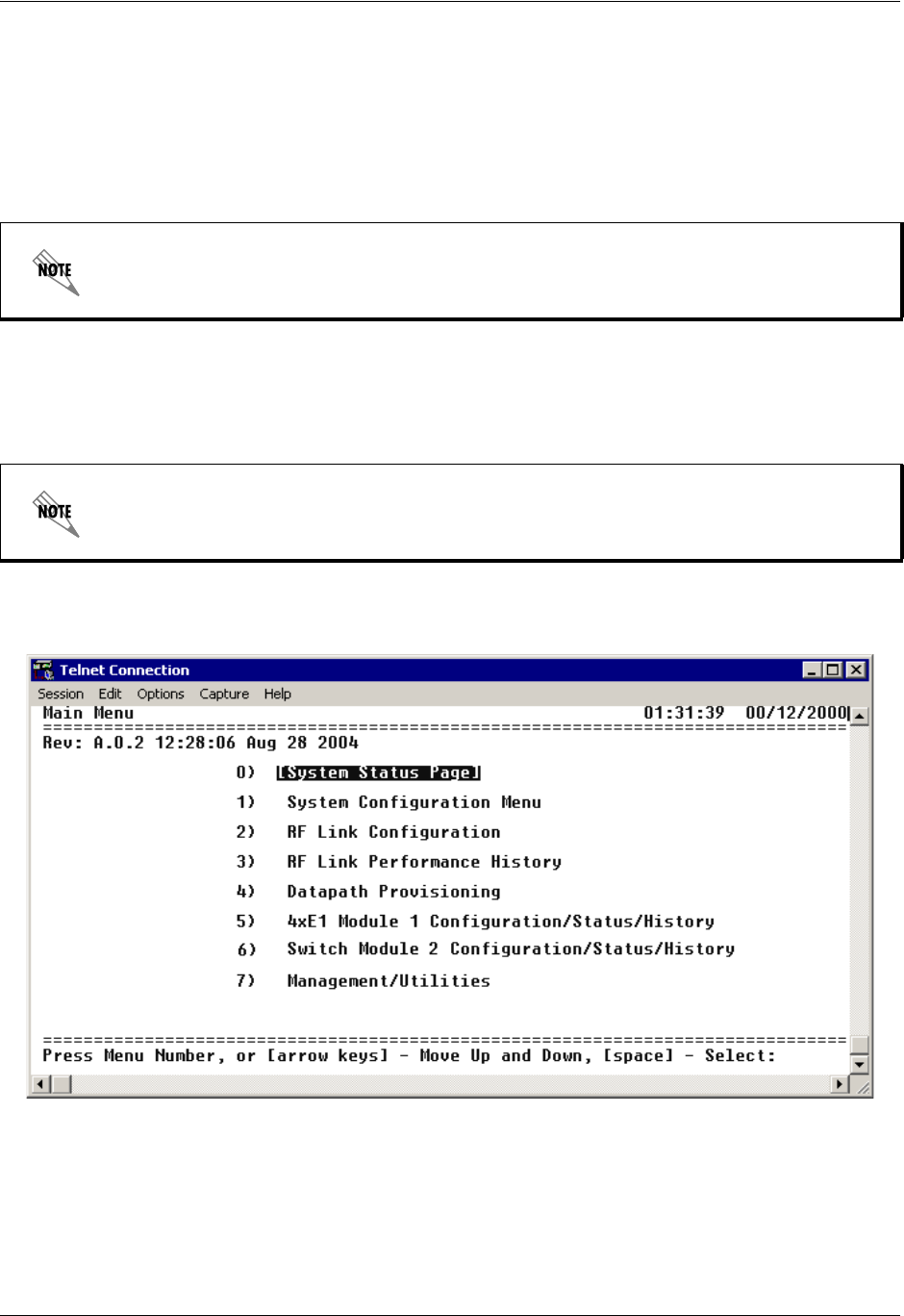
TRACER 6000 Series Split System Manual Section 5 User Interface Guide
612806320L1-1A 57
1. NAVIGATING THE TERMINAL MENU
The TRACER menu system can be accessed with a VT100 compatible terminal that is connected to the
CRAFT PORT (located on the front of the TRACER 6200 IDU) and set to 9600 bits per second (default),
8 data bits, 1 stop bit, and no parity. Flow control on the serial interface should be configured to NONE for
proper operation. Once a terminal is connected, press <Enter> until the login screen appears. The default
password for the TRACER is password.
Terminal Menu Window
The TRACER 6200 uses a series of menu pages and a single Main Menu page to access its many features.
The Main Menu page (see Figure 1) provides a link to all available configuration/status pages.
Figure 1. Main Menu Screen
All TRACER passwords are case-sensitive.
After connecting a VT100 terminal to the TRACER 6200, press <Ctrl + l> or <Ctrl + r> to
redraw the current screen.

Section 5 User Interface Guide TRACER 6000 Series Split System Manual
58 612806320L1-1A
Navigating using the Keyboard Keys
You can use various keystrokes to move through the terminal menu, manage a terminal menu session, and
configure the system.
Moving Through the Menus
2. MENU AND SYSTEM CONTROL
Password Protection
The TRACER 6200 provides password protection of the menu interface (via Terminal or Telnet access).
To do this... Press this key...
Activate the Login screen (upon initial connection) Enter (twice)
Refresh the screen <Ctrl + l>
<Ctrl + r>
Exit the menu system and return to the login screen <Ctrl + z>
Close the Telnet session (or toggle the modem signalling to hang up an
attached modem) <Ctrl + z> (twice)
Move up to select items Up Arrow
p (Previous)
Move down to select items Down Arrow
n (Next)
Edit a selected menu item Enter
Spacebar
Scroll through configuration parameters for a menu item Spacebar
Left/Right Arrows
p or n (Prev/Next)
Cancel an edit Escape
Return to Main Menu page m
Back out to previous menu page b
Left Arrow
Go to System Status menu page s
All TRACER systems are shipped with a default password of password. (Passwords are
case-sensitive.)
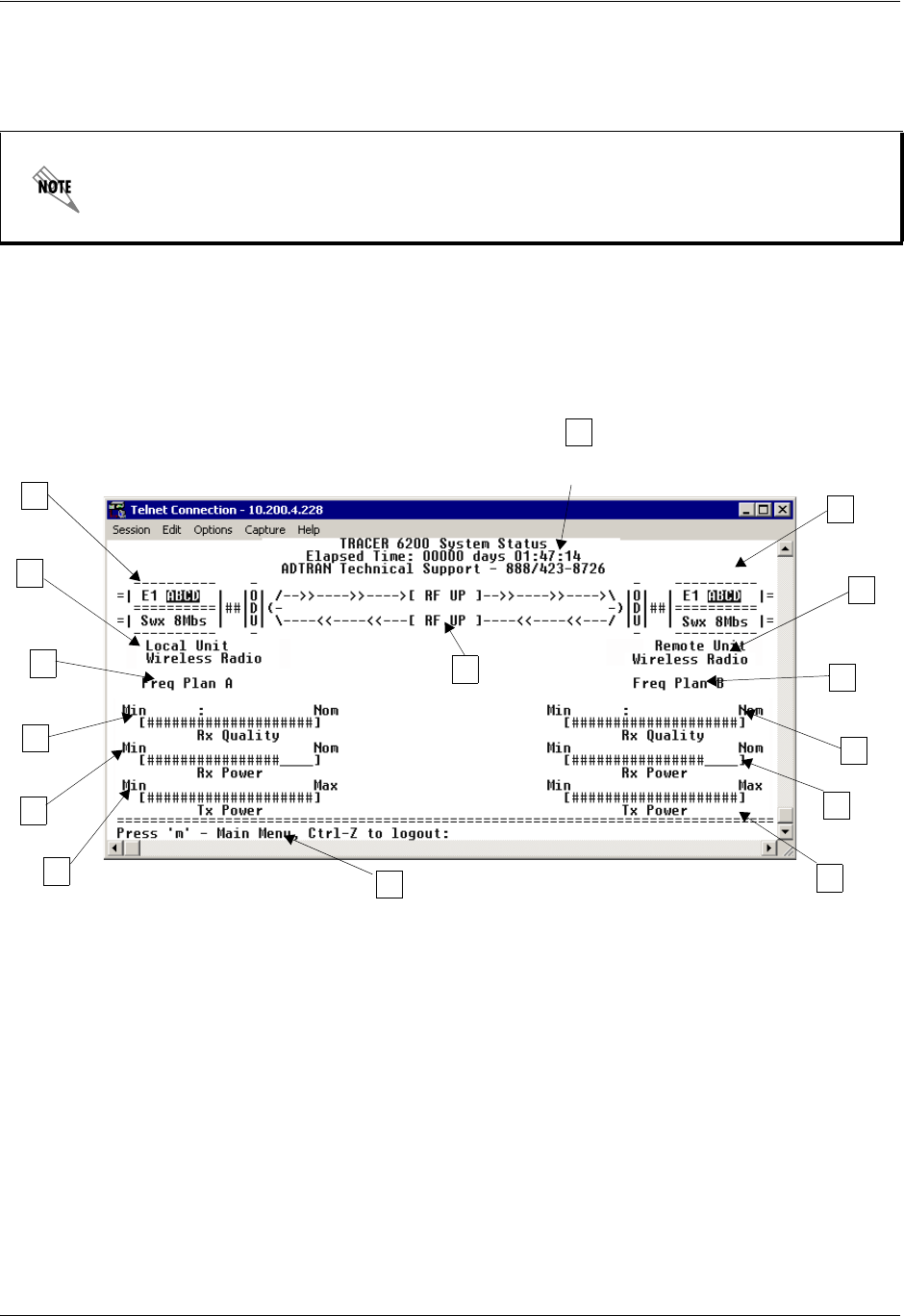
TRACER 6000 Series Split System Manual Section 5 User Interface Guide
612806320L1-1A 59
3. MENU DESCRIPTIONS
The remainder of this section describes the TRACER menus and submenus.
> SYSTEM STATUS
Figure 2 shows the TRACER System Status menu page. The status of major system components for both
sides of the RF link is displayed, but no configuration can be performed from this view.
Figure 2. TRACER System Status
A. Elapsed Time
The top of the TRACER System Status menu page displays the elapsed time the TRACER system has
been operational since the last power reset.
The menu structure of the TRACER system is depicted below as follows:
> MENU PAGE
> MENU PAGE > MENU SELECTION
> MENU PAGE > MENU SELECTION > SUB-MENU
A
Elapsed
Time
E
Local
F
Frequency
H
Rx Power
CRF Status
Module
D
Remote
F
H
Rx Power
I
Tx Power
I
Tx Power JNavigation Reminder
Tracer
STATUS
Plan Frequency
Plan
TRACER
Status
Rx Quality
G
Rx Quality
B
G
Status
Module
B
Status

Section 5 User Interface Guide TRACER 6000 Series Split System Manual
60 612806320L1-1A
B. Module Status
A visual status of the current installed modules. The modules are listed in the order they are installed
(Module 1 on top and Module 2 on the bottom).
C. RF Status
A graphical indicator of the RF links is located beneath the Elapsed Time display. The status of the
received radio link is indicated as RF UP or RF DOWN for each direction. This RF status display
corresponds to the RF DWN LED on the front of the unit.
D. Remote System Status
The right portion of the TRACER System Status menu page reports the status of the remote TRACER
(the system across the wireless link from the active terminal). If the RF link is down in either direction,
DATA NOT AVAILABLE is displayed in place of the remote system status information.
E. Local System Status
The left portion of the System Status menu page reports the status of the local TRACER (the system
where the active terminal is attached).
F. Frequency Plan
Displays the frequency plan (A or B) for the TRACER unit. For an operational TRACER system, you
should have one A and one B frequency plan.
G. Rx Quality
Displays an indicator of receive signal quality that is not necessarily related to receive signal level (for
both the local and remote units) using a series of symbols (#). The more symbols (#) displayed, the
better the signal quality. This indicator is related to signal-to-noise ratio and features a colon (:) marker
to indicate 10-6 bit error rate. This indicator is useful as a diagnostic tool to help identify interference,
4XT1 MODULE
A visual status of current errors/alarms on the T1 interfaces (for both the local and remote
systems) is provided on the TRACER System Status menu page. The four available T1
interfaces on the module (A through D) are only displayed if the interface is mapped in the
DATAPATH PROVISIONING; a – is displayed for inactive, unmapped interfaces. The interface
displayed in reverse highlight indicates an active error or alarm condition on the specified
interface (A through D). Individual T1 status pages (accessible from the Main menu) provide
detailed T1 information.
4XE1 MODULE
A visual status of current errors/alarms on the E1 interfaces (for both the local and remote
systems) is provided on the System Status menu page. The four available E1 interfaces on
the module (A through D) are only displayed if the interface is mapped in the DATAPATH
PROVISIONING; a – is displayed for inactive, unmapped interfaces. The interface displayed in
reverse highlight indicates an active error or alarm condition on the specified interface (A
through D). Individual E1 status pages (accessible from the Main menu) provide detailed E1
information.
QUAD ETHERNET SWITCH MODULE
A visual status of current errors/alarms on the Ethernet interfaces (for both the local and
remote systems) is provided on the System Status menu page. The configured data rate (on
the Datapath Provisioning page) is displayed. Individual status notations for the available
Ethernet interfaces are available through the Quad Ethernet Switch Module Status page.
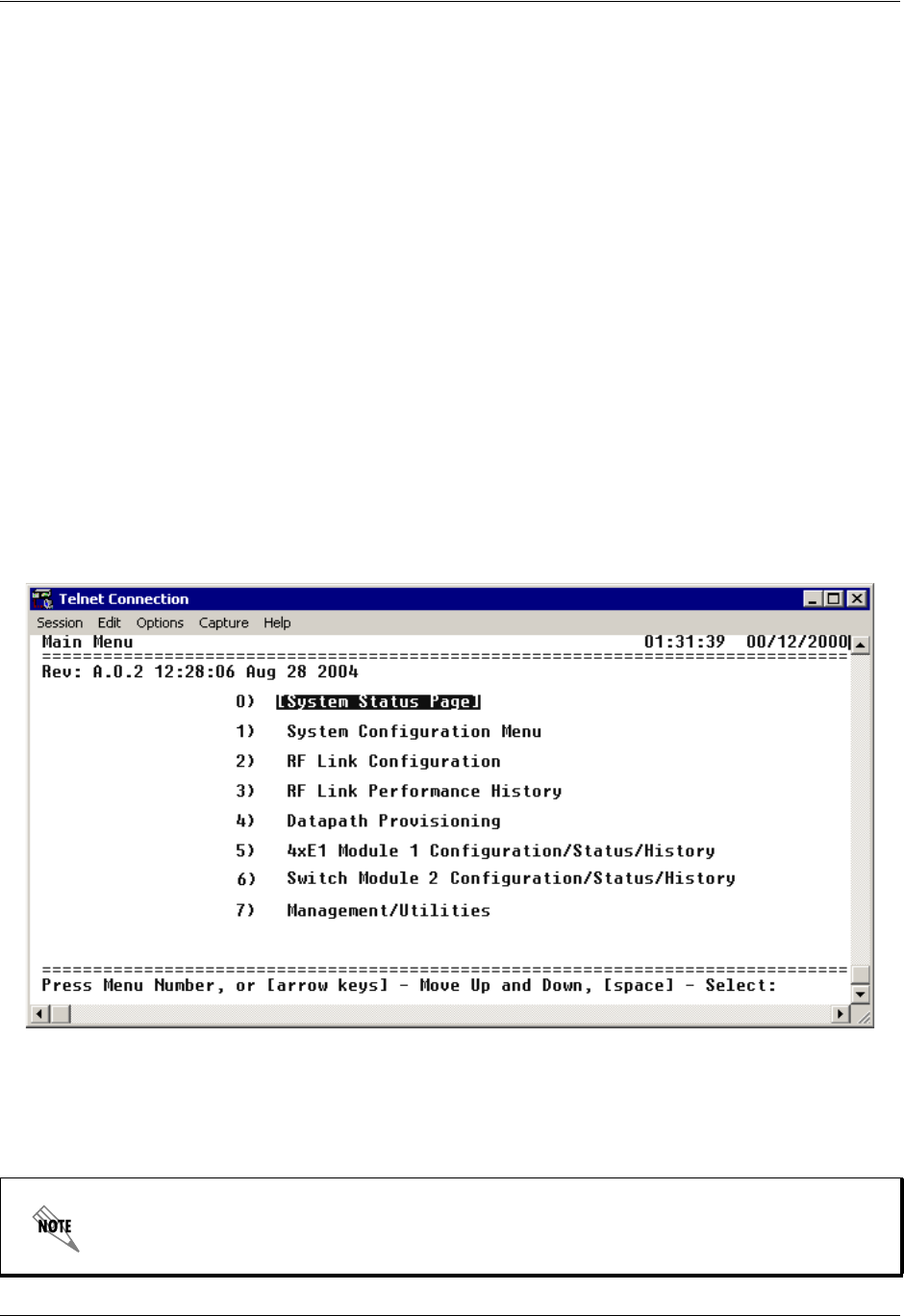
TRACER 6000 Series Split System Manual Section 5 User Interface Guide
612806320L1-1A 61
as the system may have high receive signal level and poor signal quality in situations where
interference is an issue.
H. Rx Power
Displays the approximate receiver levels (for both the local and remote units) using a series of symbols
(#). The more symbols (#) displayed, the stronger the signal. If the link is down in either direction and
remote end data is unavailable, DATA NOT AVAILABLE is displayed in place of the symbols (#).
I. Tx Power
Displays the approximate transmitter levels (for both the local and remote units) using a series of
symbols (#). The more symbols (#) displayed, the stronger the signal. If the link is down in either
direction and remote end data is unavailable, DATA NOT AVAILABLE is displayed in place of the
symbols (#).
J. Navigation Reminders
Displays system navigation reminders. For more details on system navigation, refer to Navigating the
Terminal Menu on page 57.
> MAIN MENU
The TRACER Main menu page provides access to all other configuration/status pages. Figure 3 shows the
TRACER Main menu page.
Figure 3. TRACER Main Menu
From the keyboard, use the up and down arrow keys to scroll through the available pages, or enter the
number or letter of the selected page (to highlight the menu page) and press <Enter>.
Press <m> from any menu in the TRACER menu structure to access the
TRACER Main Menu page.
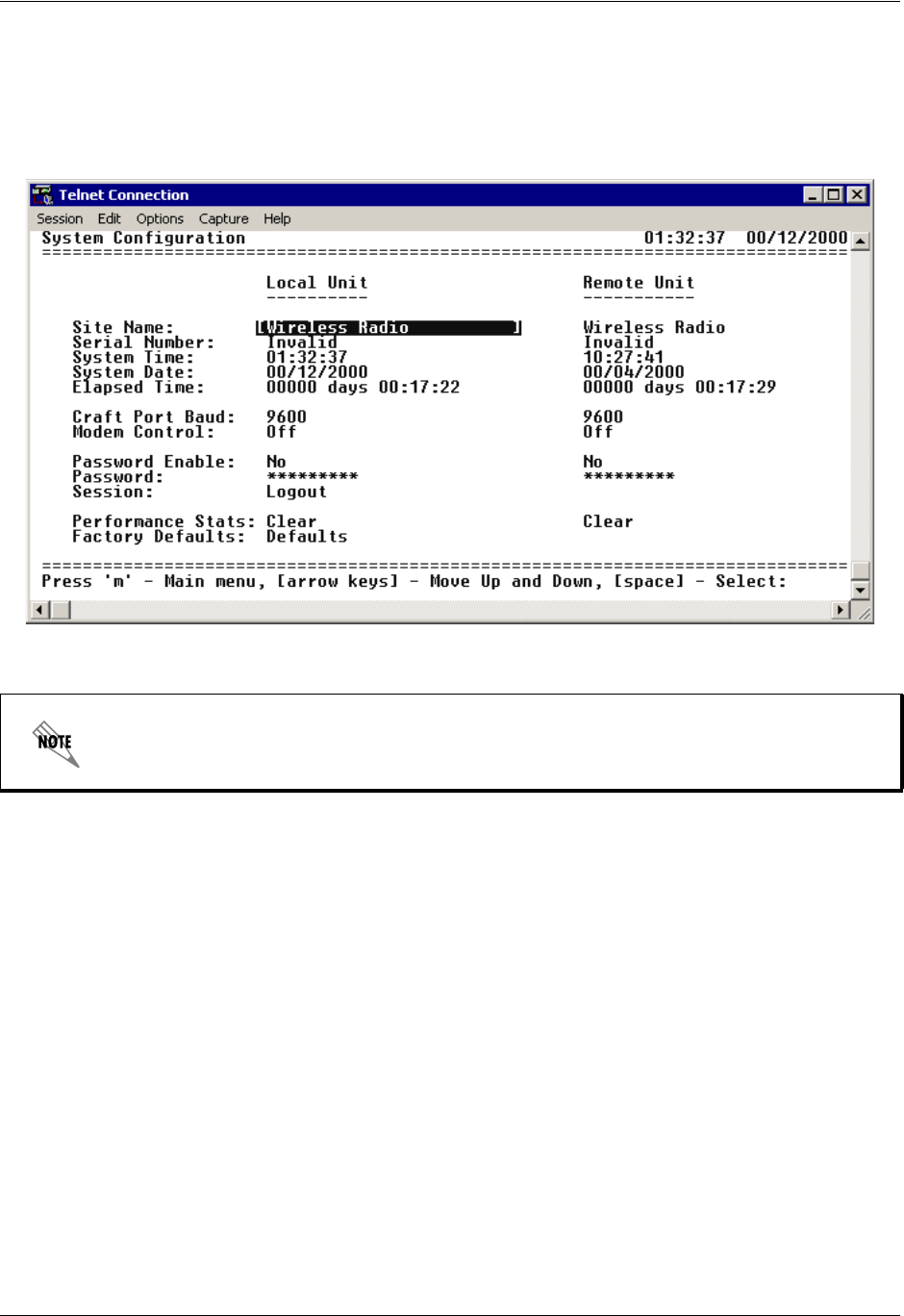
Section 5 User Interface Guide TRACER 6000 Series Split System Manual
62 612806320L1-1A
> SYSTEM CONFIGURATION
Figure 4 shows the TRACER System Configuration menu page. System configuration parameters for both
the local and remote TRACER units are available through this menu page.
Figure 4. TRACER System Configuration
> SYSTEM CONFIGURATION > SITE NAME
Provides a user-defined alphanumeric description (up to 25 characters) for the TRACER system.
> SYSTEM CONFIGURATION > SERIAL NUMBER
Displays the serial number for the unit. The serial number of the TRACER will automatically display in
this field.
> SYSTEM CONFIGURATION > SYSTEM TIME
Displays the current time, including seconds. To edit this field, place the cursor on the field and press
<Enter>. Then, enter the time in a 24-hour format (such as 23:00:00 for 11:00 pm). Press <Enter> when
you are finished to accept the change.
Press <1> from any menu in the TRACER menu structure to access the System
Configuration menu page.
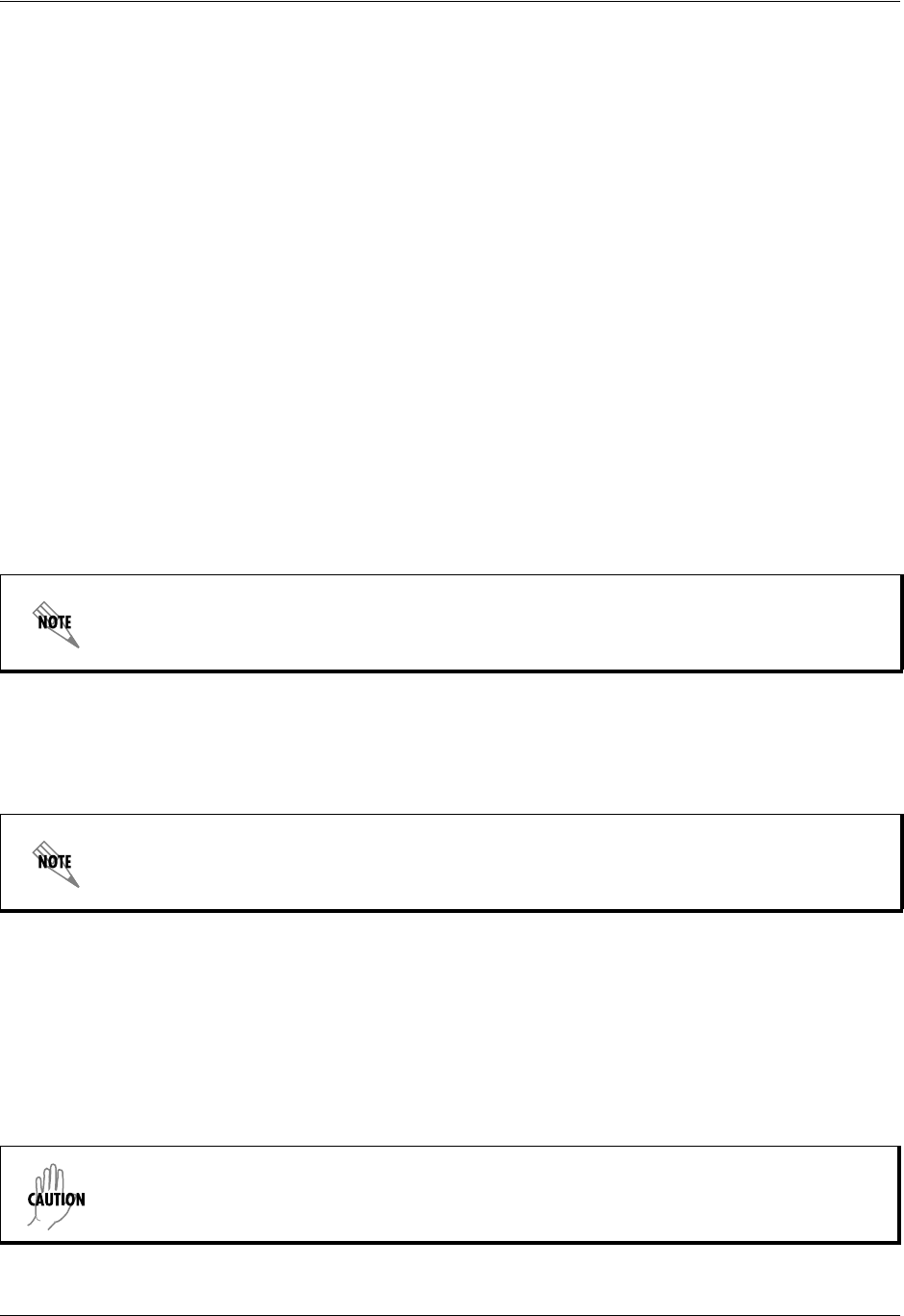
TRACER 6000 Series Split System Manual Section 5 User Interface Guide
612806320L1-1A 63
> SYSTEM CONFIGURATION > SYSTEM DATE
Displays the current date. To edit this field, place the cursor on the field and press <Enter>. Then, enter
the date in mm-dd-yyyy format (for example, 10-30-1998). Press <Enter> when you are finished to accept
the change.
> SYSTEM CONFIGURATION > ELAPSED TIME
Displays the length of time the TRACER system has been running. Each time you reset the system, this
value resets to 0 days, 0 hours, 0 min and 0 secs.
> SYSTEM CONFIGURATION > CRAFT PORT BAUD
Specifies the baud rate of the port. Select either 9600 (default), 19200, 38400, 57600, or 115200 bps. If
you are using the CRAFT port for modem access, ensure that the CRAFT port rate matches the modem
baud rate.
> SYSTEM CONFIGURATION > INACTIVITY LOGOUT
This option defines the amount of time in minutes the user may stay connected without any activity on the
CRAFT port before the user is automatically logged out of the system. Select one of the following: 5 MIN,
10 MIN (default), 15 MIN, 30 MIN, 45 MIN, 60 MIN, or OFF.
> SYSTEM CONFIGURATION > PASSWORD
Sets the password for password protection of the TRACER terminal interface. Enter up to eight
alphanumeric characters. The system password is case sensitive.
> SYSTEM CONFIGURATION > PERFORMANCE STATS (CLEAR)
Resets all system error counters for the TRACER.
> SYSTEM CONFIGURATION > FACTORY DEFAULT
Resets the system to the factory default settings. The configured IP ADDRESS, SUBNET MASK, and DEFAULT
GATEWAY are not defaulted during a factory default.
Changes to the INACTIVITY LOGOUT setting do not apply to the current session. All changes
take affect at the next login to the system menus.
The default password for the TRACER is password.
The TOTAL ACTIVE CHANNELS parameter (on the Datapath Provisioning menu page) is
reset to the factory default value (8). Performing a factory default on any system with less
than eight active channels will result in an RF link loss.

Section 5 User Interface Guide TRACER 6000 Series Split System Manual
64 612806320L1-1A
> RF LINK CONFIGURATION
Figure 5 shows the TRACER RF Link Configuration menu page, which contains the transmit and receive
power settings and band plan configuration for both the local and remote units. Triple-DES encryption is
also configured from this menu.
Figure 5. RF Link Configuration
> RF LINK CONFIGURATION > RX POWER
Displays the approximate receiver levels (for both the local and remote units) using a series of symbols (#).
The more symbols (#) displayed, the stronger the signal. If the link is down in either direction and remote
end data is unavailable, DATA NOT AVAILABLE displays in place of the symbols (#). This parameter is
display only.
> RF LINK CONFIGURATION > TX POWER
Allows the transmitter levels (for both the local and remote units) to be adjusted. The current transmitter
level is displayed using a series of symbols (#). The more symbols (#) displayed, the stronger the signal.
If the link is down and remote end data is unavailable, DATA NOT AVAILABLE displays in place of the
symbols (#). Pressing (+) on this field sets the TX POWER to full strength; pressing (-) reduces the TX
POWER to the minimum.
Reducing the transmitter power of the remote TRACER could cause the RF link to drop,
requiring a technician to increase the transmit power by using the menu system at the
remote site.

TRACER 6000 Series Split System Manual Section 5 User Interface Guide
612806320L1-1A 65
> RF LINK CONFIGURATION > RF BAND PLAN
Sets the band plan for the TRACER. Each channel is divided into three band plans (1, 2, or 3). Both local
and remote TRACER must be configured with the same band plan (1, 2, or 3) but different channel plans
(A or B). For example, the transmitter at one end of the link will transmit in band plan 1 of channel A (the
lower portion of the spectrum) and receive in band plan 1 of channel B (the upper portion). Consequently,
the receiver at the other end should receive in band plan 1 of channel A (the lower portion) and transmit in
band plan 1 of channel B (the upper portion). (Refer to Figure 6 for the division.) The TRACER comes
factory programmed with RF band plan set to Band 1.
Figure 6. 5.8 GHz Bandwidth Division
> RF LINK CONFIGURATION > LINK ENCRYPTION
The TRACER 6200 provides triple-DES (3DES) encryption of the data passed over the RF Link. When
LINK ENCRYPTION is set to ENABLED, the system sequentially applies the three keys entered in the SUBKEY 0,
1, and 2 fields to each 64-bit block of data transmitted over the RF link. The remote system uses the same
keys to decrypt each block. (The keys entered in the local and remote systems must be identical.)
> RF LINK CONFIGURATION > SUBKEY (0-2)
The TRACER 6200 provides 3DES encryption of the data passed over the RF Link. When LINK
ENCRYPTION is set to ENABLED, the TRACER sequentially applies the three keys entered in the SUBKEY 0,
1, and 2 fields to each 64-bit block of data transmitted over the RF link. The remote system uses the same
keys to decrypt each block. (The keys entered in the local and remote systems must be identical.) Valid
entries are numbers 0 through 9 and letters a through f.
When changing RF band plans on installed links, change the remote end first. If the local
end is changed first, remote configuration capability is lost. In the event the local end is
changed first and the link is dropped, reset the local end to the previous setting to restore
the link.
Channel A
57445725 5787 585747 5751MHz
Band plan 3Band plan 2Band plan 1
Channel B
5824 5827 5831
Band plan 3Band plan 2Band plan 1

Section 5 User Interface Guide TRACER 6000 Series Split System Manual
66 612806320L1-1A
> RF LINK PERFORMANCE HISTORY (MAIN SCREEN)
Figure 7 shows the TRACER RF Link Performance History main screen, which contains the transmit and
receive power settings and band plan configuration for both the local and remote units.
Figure 7. RF Link Performance History (Main Screen)
> RF LINK/ODU ERROR HISTORY
Figure 8 shows the TRACER RF Link/ODU Error History menu page, which displays the error statistics
available from the system for the RF link and the communications link between the IDU and ODU.
Detailed error statistics are displayed in 15-minute and 24-hour increments.
Figure 8. RF Link/ODU Error History
The (ODU) represents the number of seconds that the IDU was unable to communicate with the ODU over
the communications link. The number of seconds without IDU/ODU communication that occur in a
24-hour or 15-minute increment is displayed as a numerical value. ODU errors can indicate a problem with
7
Days 24
Hours
(8 Hours
displayed
at a Time)
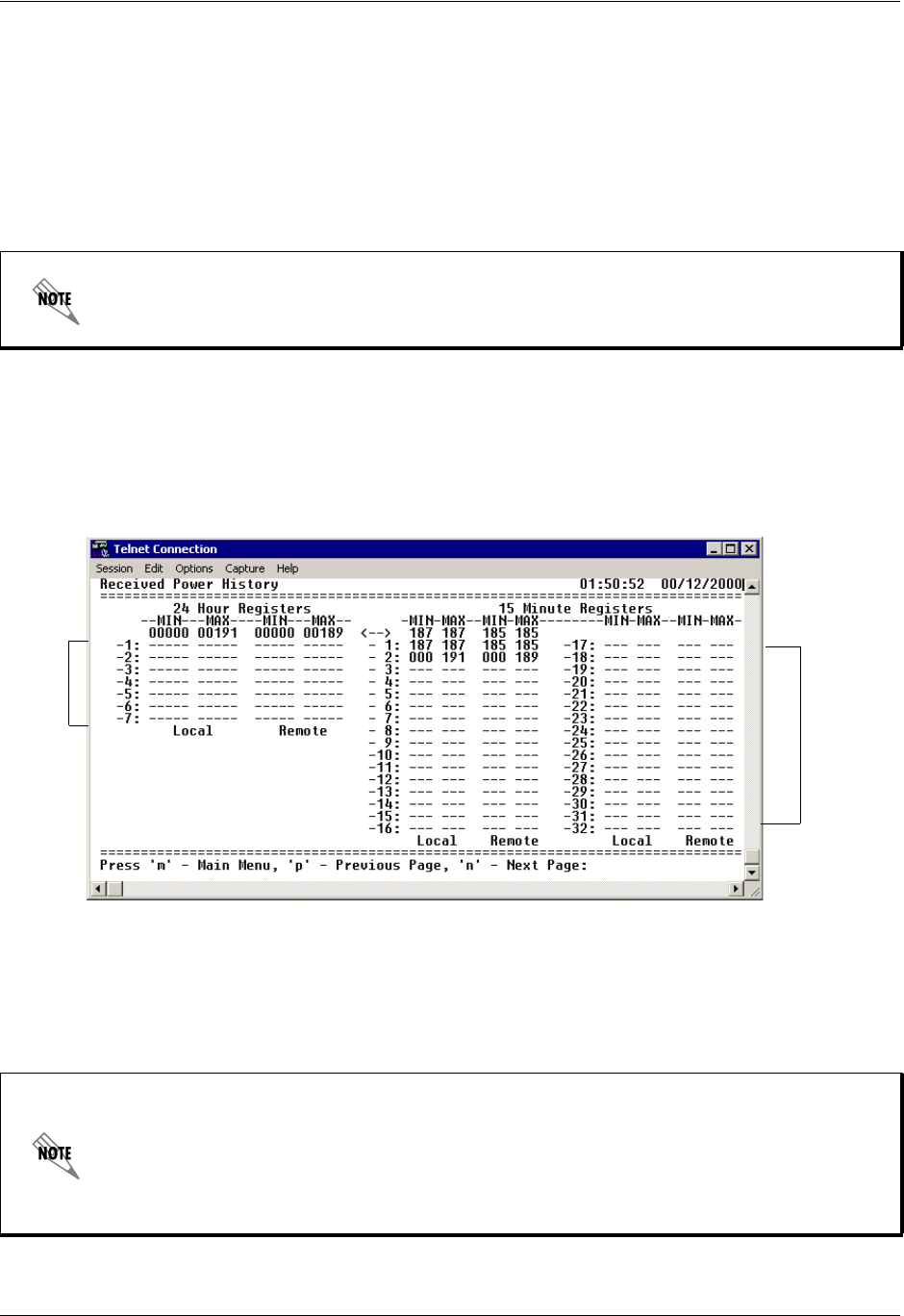
TRACER 6000 Series Split System Manual Section 5 User Interface Guide
612806320L1-1A 67
the IF cabling between the IDU and ODU. Link errors (LNK) represent the number of seconds of lost
communication (with the remote end) across the wireless link. LNK errors indicate a problem with the RF
link. Refer to the Troubleshooting Guide section of this manual for more details on troubleshooting the
causes of errors.
The ODU and link error counts for the most recent 24 hours are recorded in 15-minute increments and
displayed on the right side of the page. The left side of the page displays the 24-hour totals for the most
recent 7 days.
> RF LINK MAX/MIN RECEIVED POWER HISTORY
Figure 9 shows the TRACER RF Link Max/Min Received Power History page, which displays the
available received power statistics from the system. Minimum and maximum received signal levels for the
RF link (from both the local and remote TRACER units) in 15-minute and 24-hour increments are found
on this screen.
Figure 9. RF Link Max/Min Received Power History
The received power level (MIN and MAX) represents the minimum and maximum values of received signal
levels in a 24-hour or 15-minute increments, and is displayed as a numerical value from 0 to 100, with 0
corresponding to 0 V of RSSI and 100 corresponding to 5 V RSSI.
Press <n> to view the next 8-hour segment of 15-minute totals and <p> to view the
previous 8-hour segment.
The minimum receive power level is recorded to aid in troubleshooting problem RF links.
Radio links with high MIN numbers and intermittent performance are probably
experiencing interference, while links with low MIN numbers have improperly engineered
paths or excess system losses. A system with MIN numbers varying widely could indicate
fading, reflections, or an intermittent installation problem such as loose connectors,
damaged coax or lightning arrestors, or water contaminated feedlines.
7
Days 24
Hours
(8 Hours
displayed
at a Time
)
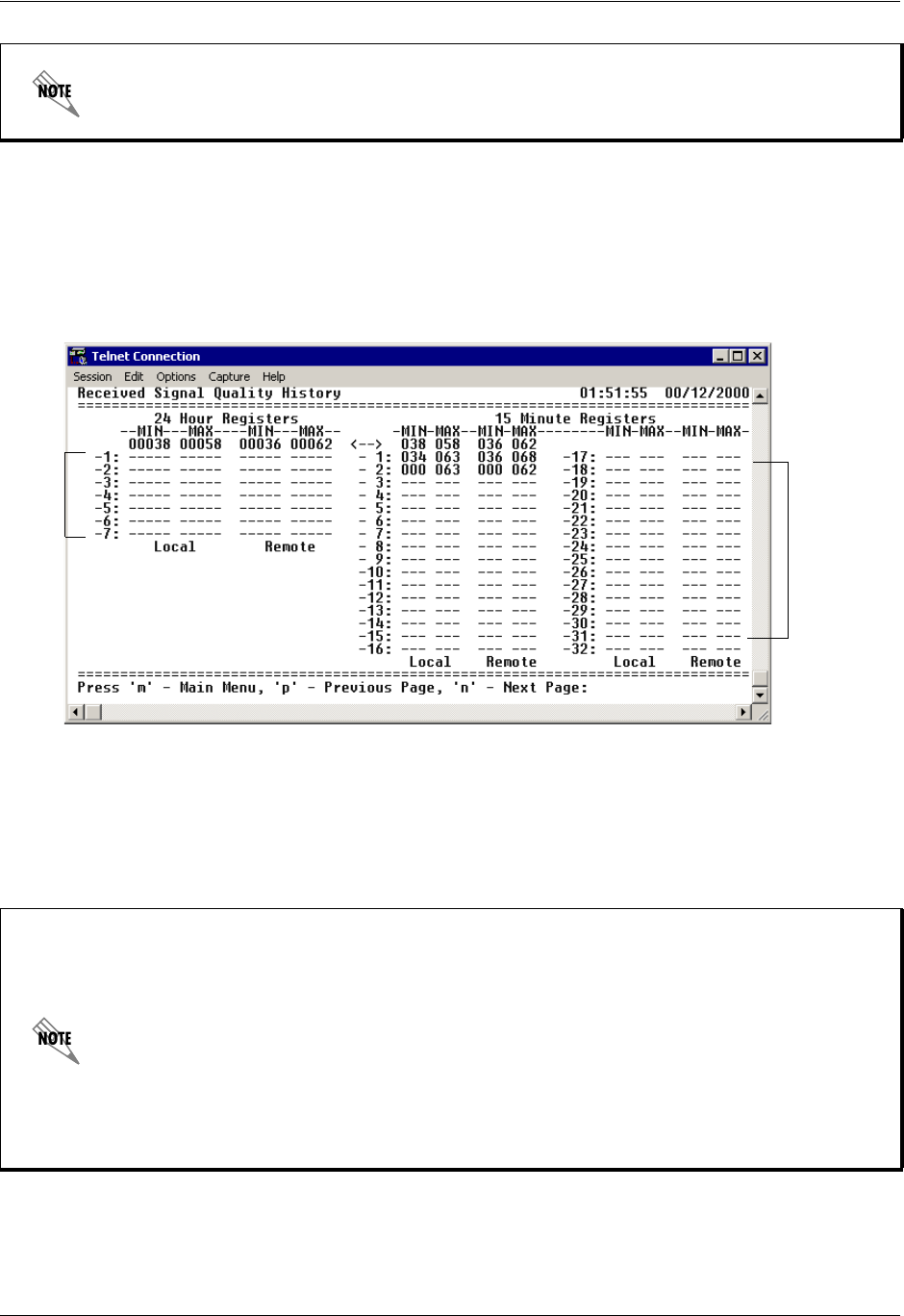
Section 5 User Interface Guide TRACER 6000 Series Split System Manual
68 612806320L1-1A
> RF LINK MIN/MAX RECEIVED SIGNAL QUALITY HISTORY
Figure 10 shows the TRACER RF Link Min/Max Received Signal Quality History menu page, which
displays the available received signal quality statistics from the system. Minimum and maximum received
signal quality levels for the RF link (from both the local and remote TRACER units) in 15-minute and
24-hour increments are found on this screen.
Figure 10. RF Link Min/Max Received Signal Quality History
The received power quality level (MIN and MAX) represents the minimum and maximum values of
received signal quality levels in a 24-hour or 15-minute increments, and is displayed as a numerical value
from 0 to 100, with 0 corresponding to poor signal quality and 100 corresponding to exceptional signal
quality.
Press <n> to view the next 8-hour segment of 15-minute totals and <p> to view the
previous 8-hour segment.
Radio links with consistently high MIN and MAX numbers should not experience
interference. Radio links with a large difference between MIN and MAX numbers could be
experiencing fading, reflections, or intermittent interference or installation problems such
as loose connectors, damaged coax cable, water contaminated feedlines, or damaged
lightning arrestors. Radio links with consistently low MIN and MAX numbers may be
experiencing interference, low receive levels, or installation problems. If this is the case,
examine the RF link MIN/MAX received power history. High received power numbers with
low received signal quality numbers indicate interference, while low received power
numbers with low received signal quality numbers indicate low receive levels or
installation problems.
7
Days 24
Hours
(8 Hours
displayed
at a Time)
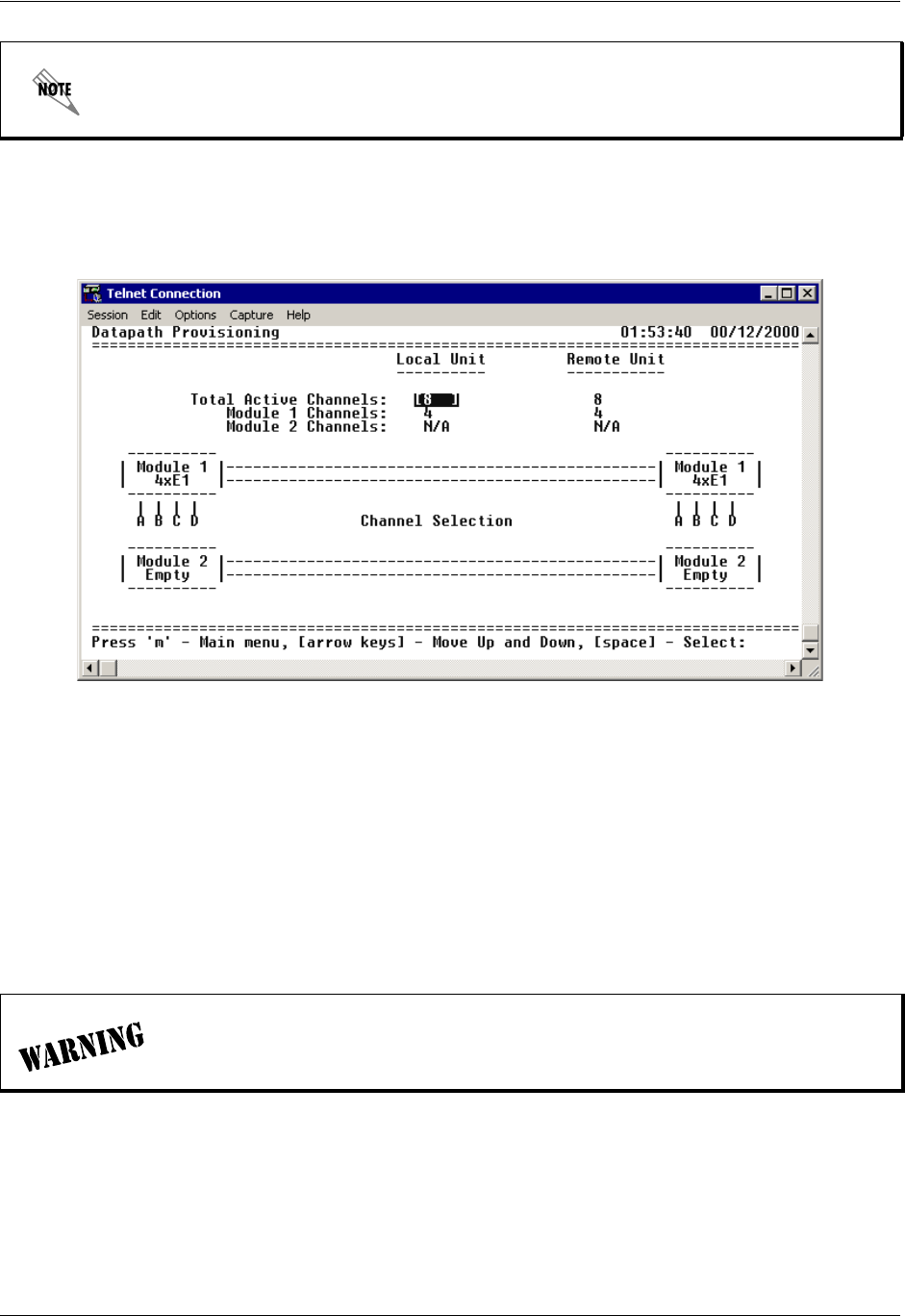
TRACER 6000 Series Split System Manual Section 5 User Interface Guide
612806320L1-1A 69
> DATAPATH PROVISIONING
Figure 11 shows the Datapath Provisioning menu page, which displays the active network interfaces for
the installed modules (from both the local and remote TRACER units).
Figure 11. Datapath Provisioning
> DATAPATH PROVISIONING > TOTAL ACTIVE CHANNELS
Defines the total number of channels active on the installed modules. Specify 2, 4, or 8 total active
channels. After defining the total number of active channels, specify the actual active channels using the
CHANNEL SELECTION menu.
> DATAPATH PROVISIONING > MODULE 1/2 CHANNELS
(Read Only) Displays the total number of active channels on the installed module.
> DATAPATH PROVISIONING > CHANNEL SELECTION
Defines the active channels (A, B, C, D) on each installed T1 module or the bandwidth dedicated to the
Quad Ethernet Switch module (in 2 Mbps steps). To activate a channel, press <Enter> and use the
spacebar or arrow keys to cycle through the available channel combinations until the desired combination
Press <n> to view the next 8-hour segment of 15-minute totals and <p> to view the
previous 8-hour segment.
The number of active channels and the channel configuration on both the local and
remote systems must match for the RF link to function properly. A discrepancy
between the systems can result in unpredictable operation.
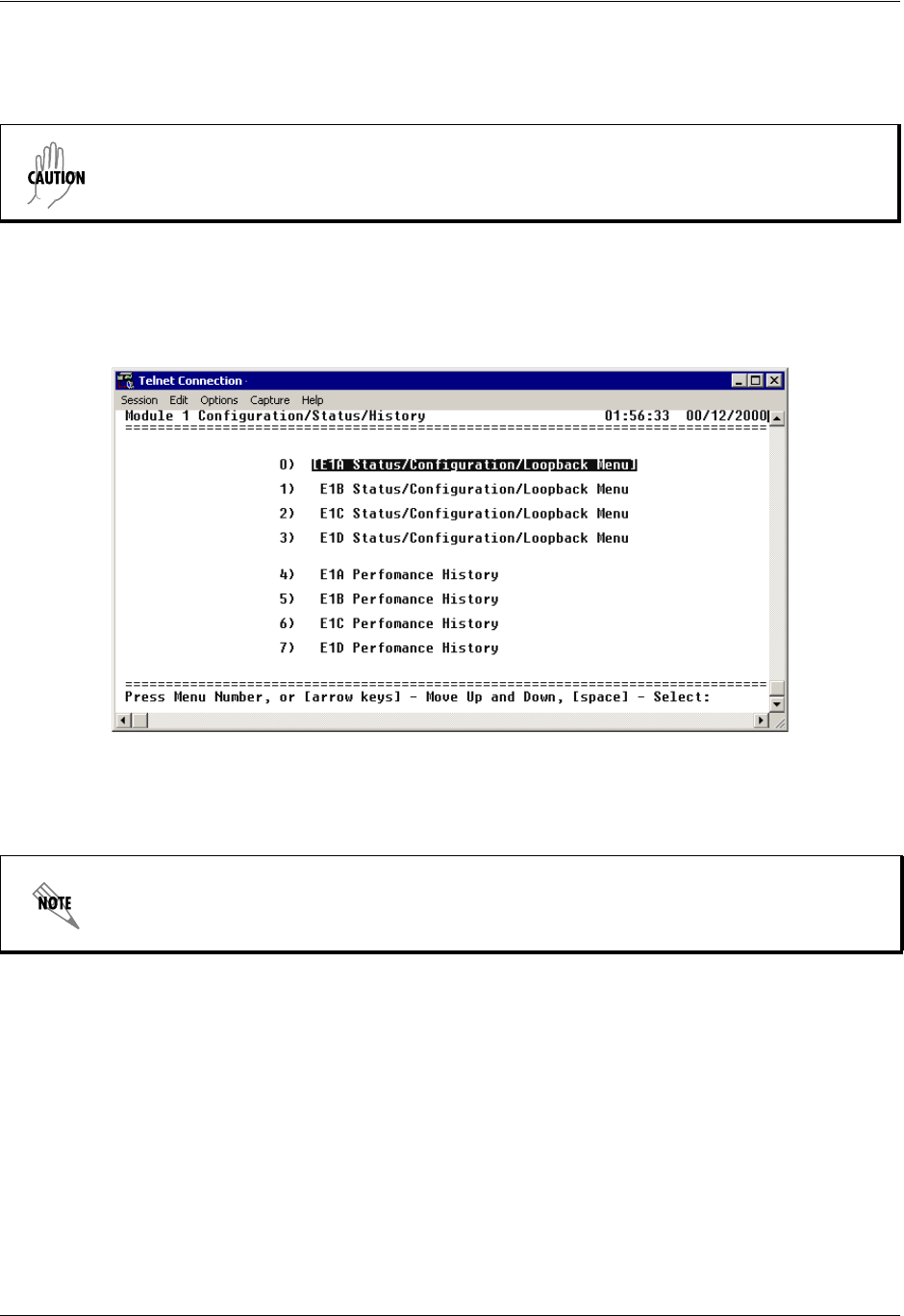
Section 5 User Interface Guide TRACER 6000 Series Split System Manual
70 612806320L1-1A
displays. Press <Enter> again to make the channel combination change. If the specified channel selection
is not valid, the TRACER automatically corrects the configuration and populates the field with a valid
selection.
> 4XE1 MODULE CONFIGURATION/STATUS/HISTORY (MAIN SCREEN)
Figure 12 shows the TRACER E1 module Configuration main screen, which contains access to the status,
configuration, testing, and performance history parameters for the selected E1 module.
Figure 12. E1 Module Configuration/Status/History (Main Screen)
> E1X STATUS/CONFIGURATION/LOOPBACK
Figure 13 on page 71 shows the E1x Status/Configuration/Loopback menu page, which displays a
real-time graphical representation for the E1x link using data from both the local and remote TRACER
units. E1x operational configuration parameters and testing functions are configured from this menu.
The number of active channels and the channel configuration on both the local and remote
systems must match for the RF link to function properly. A discrepancy between the systems
can result in unpredictable operation.
The following menus for the E1x Status/Configuration/Loopback apply to all four
available E1 interfaces (A through D).
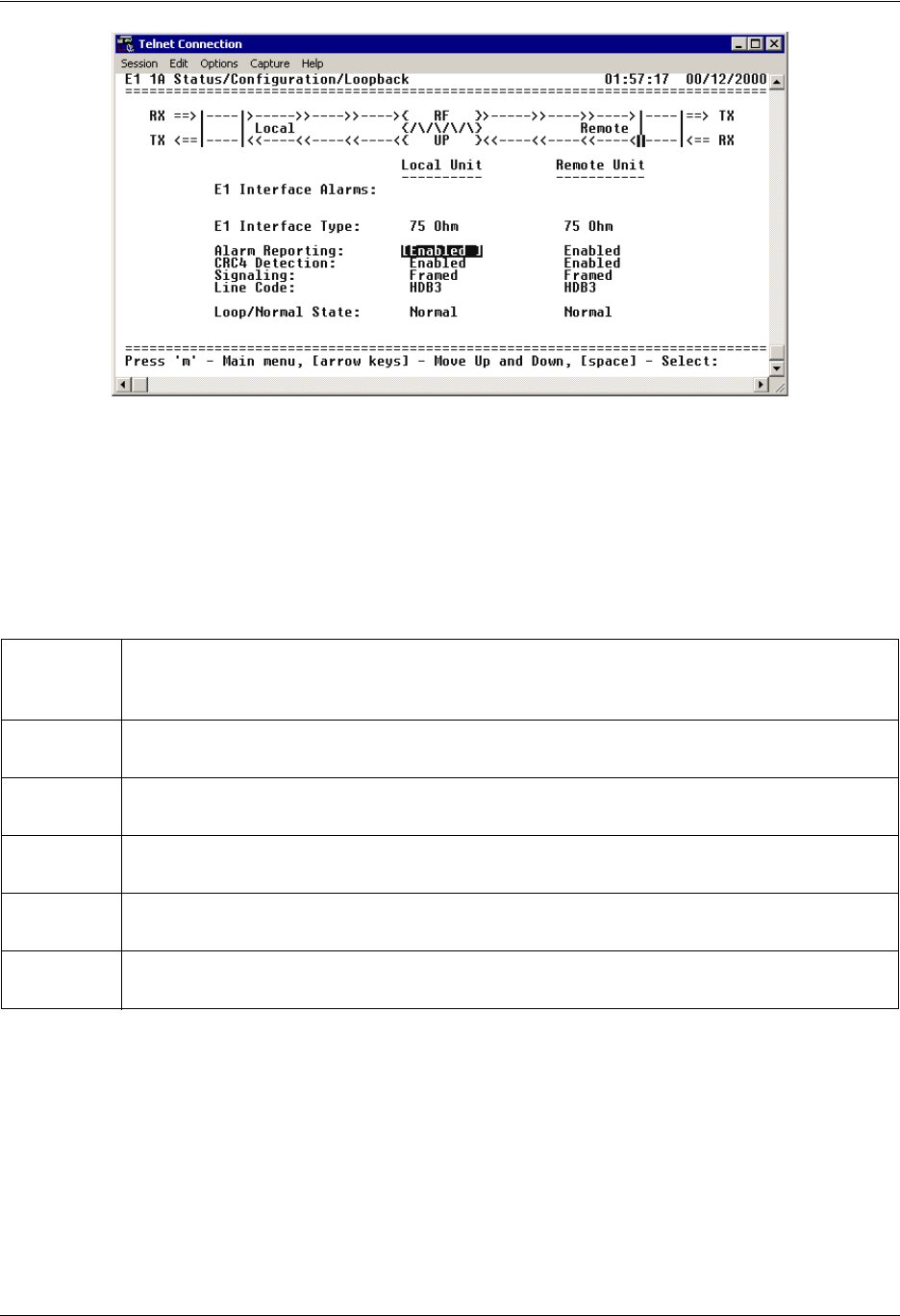
TRACER 6000 Series Split System Manual Section 5 User Interface Guide
612806320L1-1A 71
Figure 13. E1x Status/Configuration/Loopback
> E1X STATUS/CONFIGURATION/LOOPBACK > E1X INTERFACE ALARMS
Displays any active alarms on the E1 link (reported from both the local and remote TRACER units).
These alarms include AIS, CRC, LCV, LOS, OOF, and RMT. Table 1 briefly describes these alarms. See
Section 8, Troubleshooting Guide on page 95, for more information on these alarms.
> E1X STATUS/CONFIGURATION/LOOPBACK > INTERFACE TYPE
(Read Only) Displays the current interface type of the E1 module.
> E1X STATUS/CONFIGURATION/LOOPBACK > ALARM REPORTING
Determines whether the TRACER unit will report active alarms. If set to DISABLED, no alarms will be
displayed on this menu page. The ALARM REPORTING parameter is independently configured for the local
and remote TRACER units. When set to DISABLED, the TRACER does not report active alarms via SNMP,
the CRAFT port, alarm contacts, menu screens, or LEDs on the front panel. By default, alarm reporting is
set to ENABLED.
Table 1. E1 Interface Alarms
AIS (Alarm Indication Signal) Activates when an incoming remote alarm is received from a
connected E1 device. An AIS signal is an unframed all one signal that replaces the normal
traffic signal.
CRC (Loss of CRC-4 Framing) The receiver is unable to synchronize to the CRC-4 frame
pattern of the received signal.
LCV (Line Code Violations) Activates when the incoming E1 stream presents line coding
violations.
LOS (Loss of Signal) Activates when no E1 signal is present from the connected E1 equipment.
LOS is activated after receiving 192 consecutive zeros.
OOF (Out of Frame) The receiver is unable to synchronize to the FAS framing pattern of the
received signal.
RMT (Received Remote Alarm) Activates when an incoming remote alarm is received from the
E1 device, indicating that a failure has occurred in the received direction.
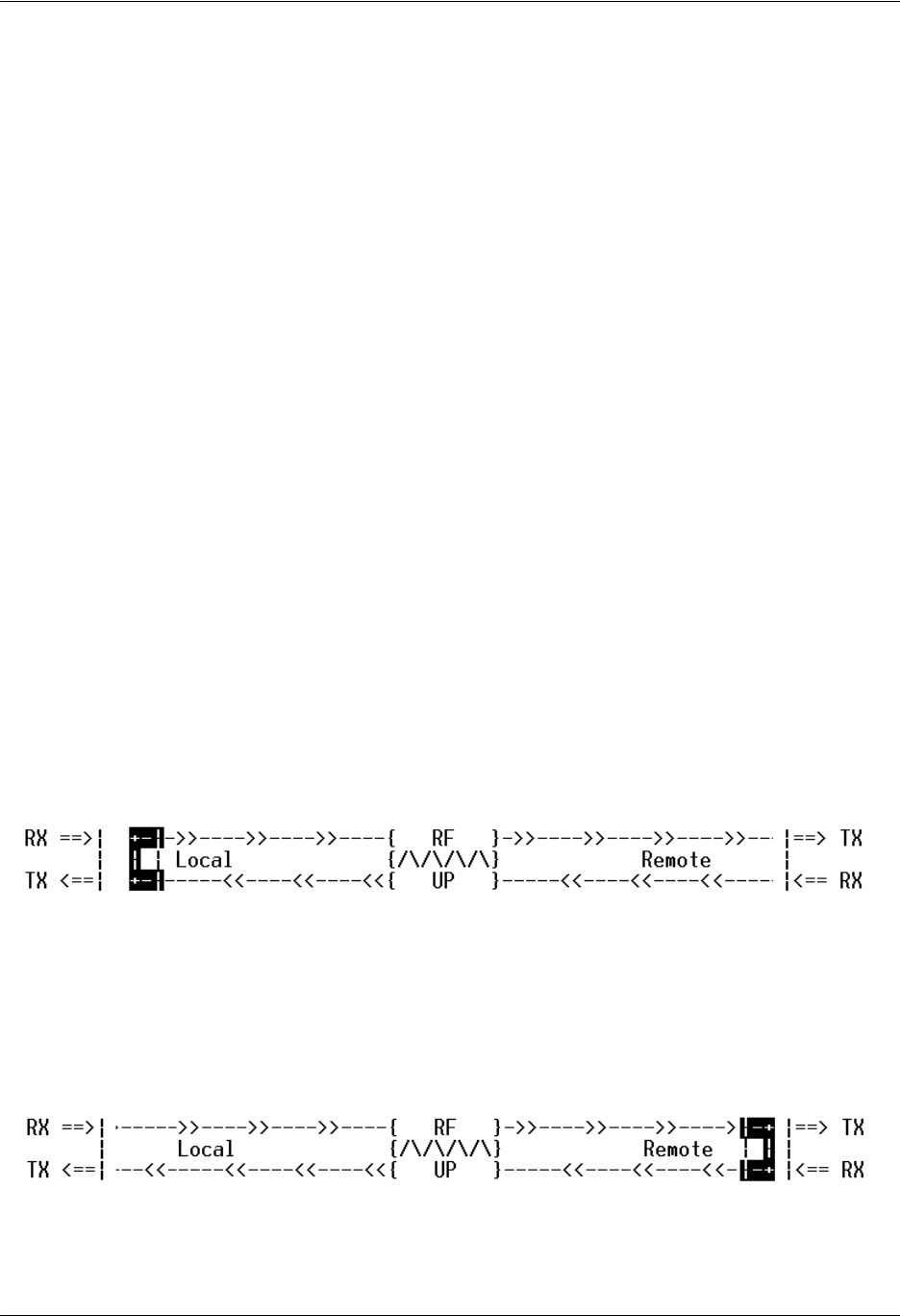
Section 5 User Interface Guide TRACER 6000 Series Split System Manual
72 612806320L1-1A
> E1X STATUS/CONFIGURATION/LOOPBACK > CRC4 DETECTION
When ENABLED, the receiver detects the CRC-4 checksum bits in the outgoing E1 data stream and checks
the received signal for errors.
> E1X STATUS/CONFIGURATION/LOOPBACK > SIGNALING
Configures the framing format for the E1 link. The TRACER transports E1 data across the link (as long as
the E1 signal is properly timed). Configure the framing format (using the SIGNALING menu) to enable the
TRACER to monitor incoming framing error events and indicate problems with the attached metallic
service. The TRACER supports MULTIFRAMED (also known as CAS), UNFRAMED (all data stream with no
framing sequence bits), and FRAMED (also known as CCS). The default value is MULTIFRAMED.
> E1X STATUS/CONFIGURATION/LOOPBACK > LINE CODE
Sets the line coding for the E1 link. The TRACER supports high-density bipolar 3 substitution (HDB3) and
alternate mark inversion (AMI) line coding. HDB3 coding does not allow more than three consecutive
zeros in a transmitted bit stream and is the standard coding method on public networks.
> E1X STATUS/CONFIGURATION/LOOPBACK > LOOP/NORMAL STATE
Controls the loop status of the E1 link. Activates/deactivates loopback conditions for testing purposes.
> E1X STATUS/CONFIGURATION/LOOPBACK > LOOP/NORMAL STATE > NORMAL
Defines the E1 link as normal data transport mode; there are no active loopbacks.
> E1X STATUS/CONFIGURATION/LOOPBACK > LOOP/NORMAL STATE > LINK [LOCAL]
Activates a loopback at the local TRACER E1 framer towards the remote end of the wireless link (see
Figure 14). Use the local LINK loopback to loop the data transmitted from the remote end of the link back
across the radio link to the remote end of the link. This loopback tests the integrity of the radio link and all
the associated digital and RF hardware.
Figure 14. E1 Local Link Loopback
> E1X STATUS/CONFIGURATION/LOOPBACK > LOOP/NORMAL STATE > LINK [REMOTE]
Activates a loopback at the remote TRACER E1 framer towards the local end of the wireless link (see
Figure 15). Use the remote LINK loopback to loop the data transmitted from the local end of the link across
the radio link to the local end of the link. This loopback tests the integrity of the radio link and all the
associated digital and RF hardware.
Figure 15. E1 Remote Link Loopback
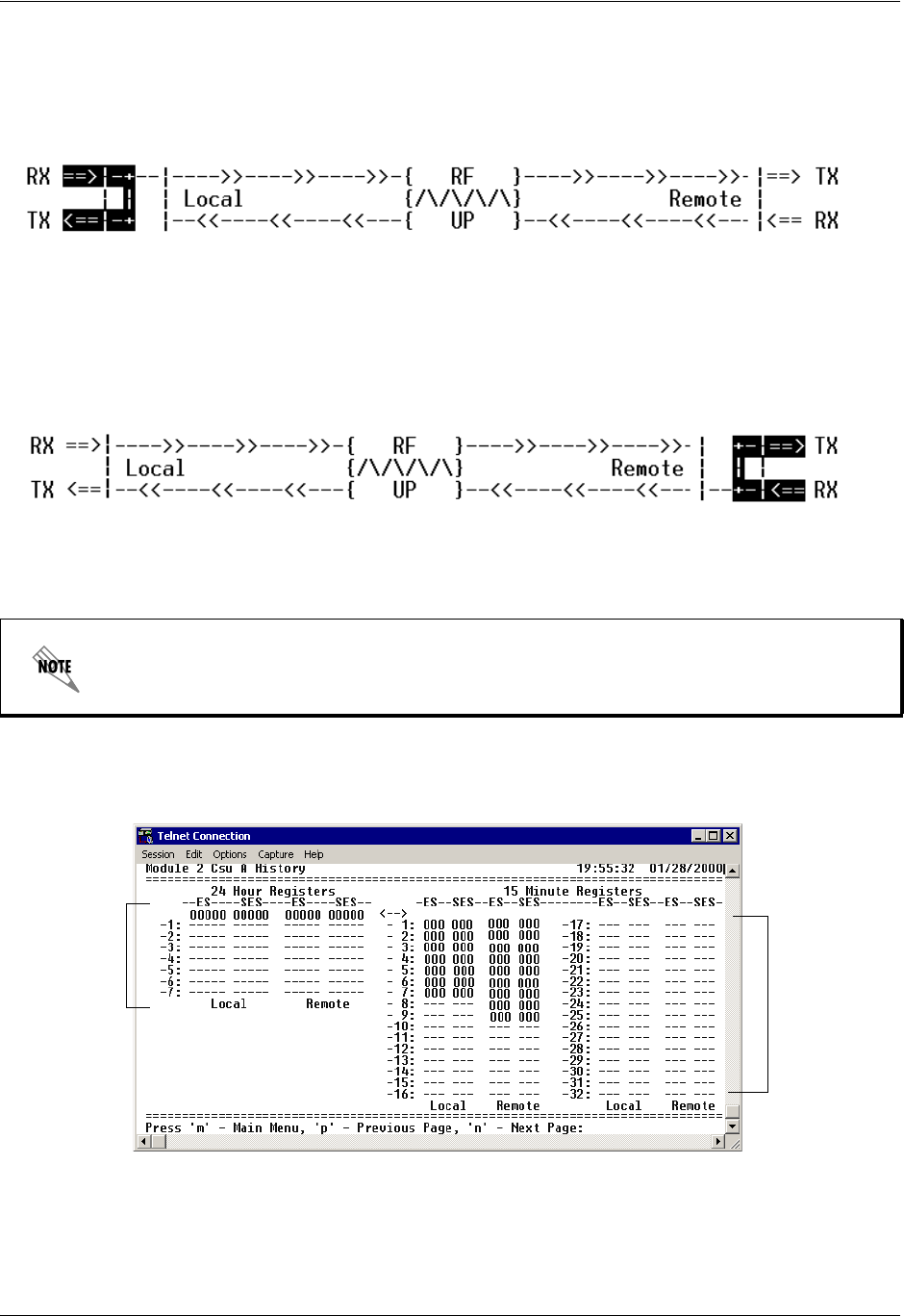
TRACER 6000 Series Split System Manual Section 5 User Interface Guide
612806320L1-1A 73
> E1X STATUS/CONFIGURATION/LOOPBACK > LOOP/NORMAL STATE > LINE [LOCAL]
Activates a loopback at the local TRACER E1 framer towards the locally connected E1 equipment (see
Figure 16). Use the local LINE loopback to test data path integrity from the local TRACER unit to the
connected E1 equipment.
Figure 16. E1 Local Line Loopback
> E1X STATUS/CONFIGURATION/LOOPBACK > LOOP/NORMAL STATE > LINE [REMOTE]
Activates a loopback at the remote TRACER E1 framer towards the connected E1 equipment at the remote
end of the link (see Figure 17). Use the remote LINE loopback to test data path integrity from the remote
TRACER unit to the E1 equipment connected at the remote end of the link.
Figure 17. E1 Remote Line Loopback
> E1X PERFORMANCE HISTORY
Figure 18 shows the E1x Performance History menu page, which displays detailed error statistics for the
E1 link (from both the local and remote TRACER units) in 15-minute and 24-hour increments.
Figure 18. E1x Link Performance History
The following menus for the E1x Performance History apply to all four available E1
interfaces (A through D).
7
Days
24
Hours
(8 Hours
displayed
at a time)

Section 5 User Interface Guide TRACER 6000 Series Split System Manual
74 612806320L1-1A
E1 performance data is presented as Errored Seconds (ES) and Severely Errored Seconds (SES) on the E1
interface. The following events qualify as an ES: LOS, OOF, LCV, or CRC error. An SES is caused by a
loss of signal or an out-of-frame event.
The error count for the most recent 24 hours are recorded in 15-minute increments and displayed on the
right side of the page. The left side of the page displays the 24-hour totals for the most recent 7 days.
> T1 MODULE CONFIGURATION/STATUS/HISTORY (MAIN SCREEN)
Figure 19 shows the TRACER 4xT1 module Configuration main screen, which contains access to the
status, configuration, testing, and performance history parameters for the selected T1 module.
Figure 19. T1 Module Configuration/Status/History (Main Screen)
> T1X STATUS/CONFIGURATION/LOOPBACK
Figure 20 on page 75 shows the T1x Status/Configuration/Loopback menu page, which displays a
real-time graphical representation for the T1x link using data from both the local and remote TRACER
units. T1x operational configuration parameters and testing functions are configured from this menu.
Press <n> to view the next 8-hour segment of 15-minute totals and <p> to view the
previous 8-hour segment.
The following menus for the T1x Status/Configuration/Loopback apply to all four
available T1 interfaces (A through D).

TRACER 6000 Series Split System Manual Section 5 User Interface Guide
612806320L1-1A 75
Figure 20. T1x Status/Configuration/Loopback
>T1X STATUS/CONFIGURATION/LOOPBACK > T1X INTERFACE ALARMS
Displays any active alarms on the T1 link (reported from both the local and remote TRACER units). These
alarms include Red, Blue/AIS, Yellow, LOS, and bipolar violations (BPV). Table 1 briefly describes these
alarms. See Section 8, Troubleshooting Guide on page 119, for more information on these alarms.
> T1X STATUS/CONFIGURATION/LOOPBACK > ALARM REPORTING
Determines whether the TRACER unit will report active alarms. If set to DISABLED, no alarms will be
displayed on this menu page. The ALARM REPORTING parameter is independently configured for the local
and remote TRACER units. When set to DISABLED, the TRACER does not report active alarms via SNMP
or the CRAFT port, and the status LEDs are off. By default, alarm reporting is set to ENABLED.
>T1X STATUS/CONFIGURATION/LOOPBACK > T1X LINE BUILD OUT
Configures the T1 for the appropriate line build out, based on the distance to the T1 equipment. By default,
the line build out for the TRACER is 0 dB/133 FT.
Table 2. T1 Interface Alarms
RED Activates when no T1 signal is present from the connected T1 equipment. LOS is
activated after receiving 192 consecutive zeros.
BLUE/AIS (Alarm Indication Signal) Activates when an incoming remote alarm is received from a
connected T1 device. An AIS signal is an unframed all one signal that replaces the normal
traffic signal.
YEL (Yellow Alarm) Activates when an incoming remote alarm is received from the T1 device
indicating that a failure has occurred in the received direction.
LOS (Loss of Sync) Occurs when the TRACER system cannot synchronize to the incoming T1
data stream.
BPV (Bipolar Violations) Activates when the incoming T1 stream presents BPVs. BPV occur
when two one bits are received back-to-back with the same polarity.
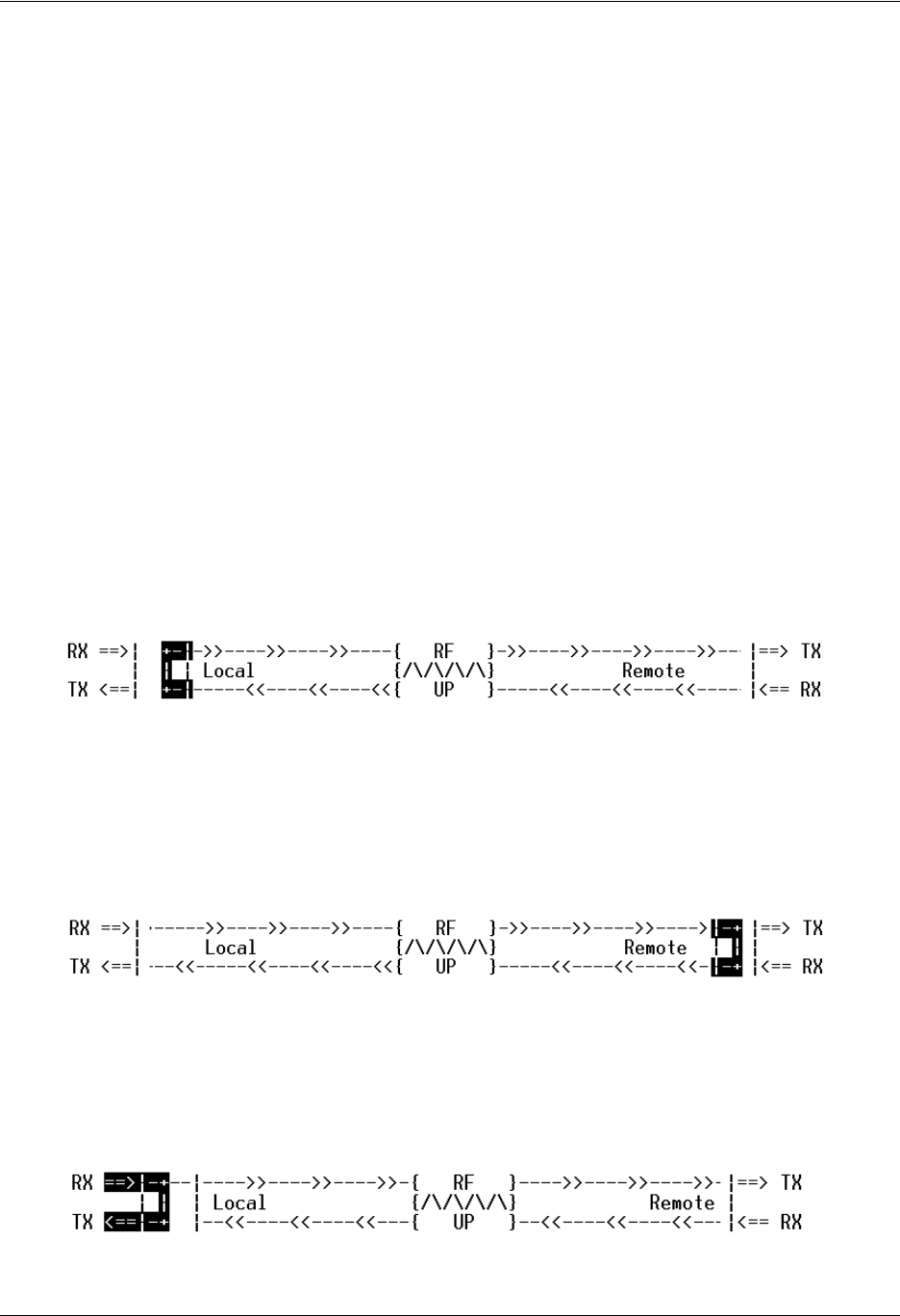
Section 5 User Interface Guide TRACER 6000 Series Split System Manual
76 612806320L1-1A
> T1X STATUS/CONFIGURATION/LOOPBACK > SIGNALING
Configures the framing format for the T1 link for both the local and remote TRACER units. The TRACER
transports T1 data across the link (as long as the T1 signal is properly timed). Configure the framing format
(using the SIGNALING menu) to enable the TRACER to monitor incoming framing error events and indicate
problems with the attached metallic service. The TRACER supports both extended superframe (ESF) and
superframe (D4) framing formats. By default, the signaling method is set to ESF.
> T1X STATUS/CONFIGURATION/LOOPBACK > LINE CODE
Sets the line coding for the T1 link. The TRACER supports bipolar eight-zero substitution (B8ZS) and
alternate mark inversion (AMI) line coding. By default, the line code is set to B8ZS.
> T1X STATUS/CONFIGURATION/LOOPBACK > LOOP/NORMAL STATE
Controls the loop status of the T1 link. Activates/deactivates loopback conditions for testing purposes.
> T1X STATUS/CONFIGURATION/LOOPBACK > LOOP/NORMAL STATE > NORMAL
Defines the T1 link as normal data transport mode; there are no active loopbacks.
> T1X STATUS/CONFIGURATION/LOOPBACK > LOOP/NORMAL STATE > LINK [LOCAL]
Activates a loopback at the local TRACER T1 framer towards the remote end of the wireless link (see
Figure 14). Use the local LINK loopback to loop the data transmitted from the remote end of the link back
across the radio link to the remote end of the link. This loopback tests the integrity of the radio link and all
the associated digital and RF hardware.
Figure 21. T1 Local Link Loopback
> T1X STATUS/CONFIGURATION/LOOPBACK > LOOP/NORMAL STATE > LINK [REMOTE]
Activates a loopback at the remote TRACER T1 framer towards the local end of the wireless link (see
Figure 15). Use the remote LINK loopback to loop the data transmitted from the local end of the link across
the radio link to the local end of the link. This loopback tests the integrity of the radio link and all the
associated digital and RF hardware.
Figure 22. T1 Remote Link Loopback
> T1X STATUS/CONFIGURATION/LOOPBACK > LOOP/NORMAL STATE > LINE [LOCAL]
Activates a loopback at the local TRACER T1 framer towards the connected T1 equipment (see Figure 23).
Use the local LINE loopback to test data path integrity from the local TRACER unit to the connected T1
equipment.
Figure 23. T1 Local Line Loopback
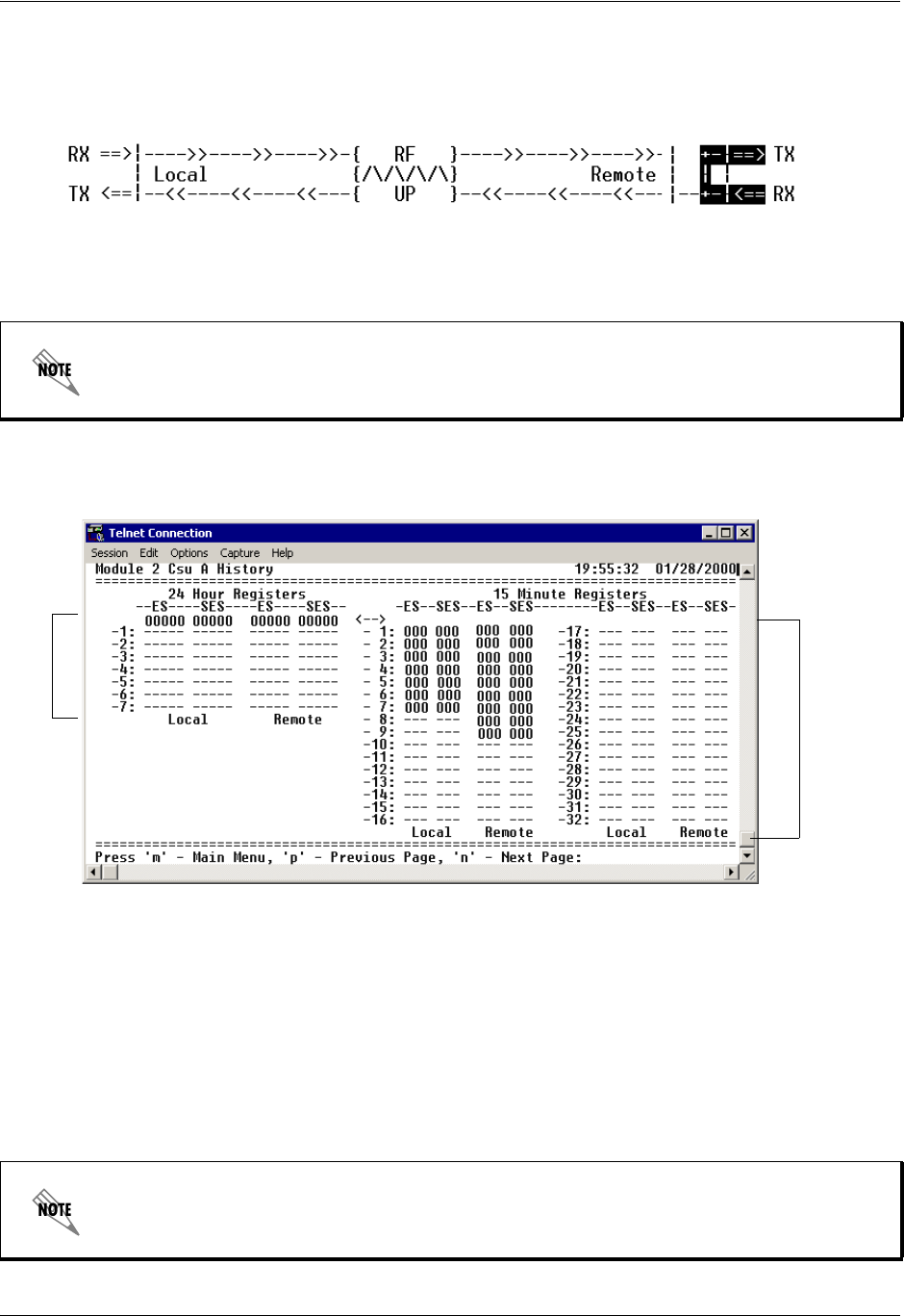
TRACER 6000 Series Split System Manual Section 5 User Interface Guide
612806320L1-1A 77
> T1X STATUS/CONFIGURATION/LOOPBACK > LOOP/NORMAL STATE > LINE [REMOTE]
Activates a loopback at the remote TRACER T1 framer towards the connected T1 equipment at the remote
end of the link (see Figure 17). Use the remote LINE loopback to test data path integrity from the remote
TRACER unit to the T1 equipment connected at the remote end of the link.
Figure 24. T1 Remote Line Loopback
> T1X PERFORMANCE HISTORY
Figure 25 shows the T1x Performance History menu page, which displays detailed error statistics for the
T1 link (from both the local and remote TRACER units) in 15-minute and 24-hour increments.
Figure 25. T1x Link Performance History
T1 performance data is presented as Errored Seconds (ES) and Severely Errored Seconds (SES) on the T1
interface. The following events qualify as an ES: AIS, LOS or LOF alarm second, a single BPV, excessive
zero event, or a single parity bit. An SES is caused by an AIS, LOS or LOF alarm second, excessive BPVs,
or framed parity-bit errors causing a line bit error rate (BER) of 10-6.
The error counts for the most recent 24 hours are recorded in 15-minute increments and displayed on the
right side of the page. The left side of the page displays the 24-hour totals for the most recent 7 days.
The following menus for the T1x Performance History apply to all four available T1
interfaces (A through D).
Press <n> to view the next 8-hour segment of 15-minute totals and <p> to view the
previous 8-hour segment.
24
Hours
7
Days
(8 Hours
displayed
at a Time)
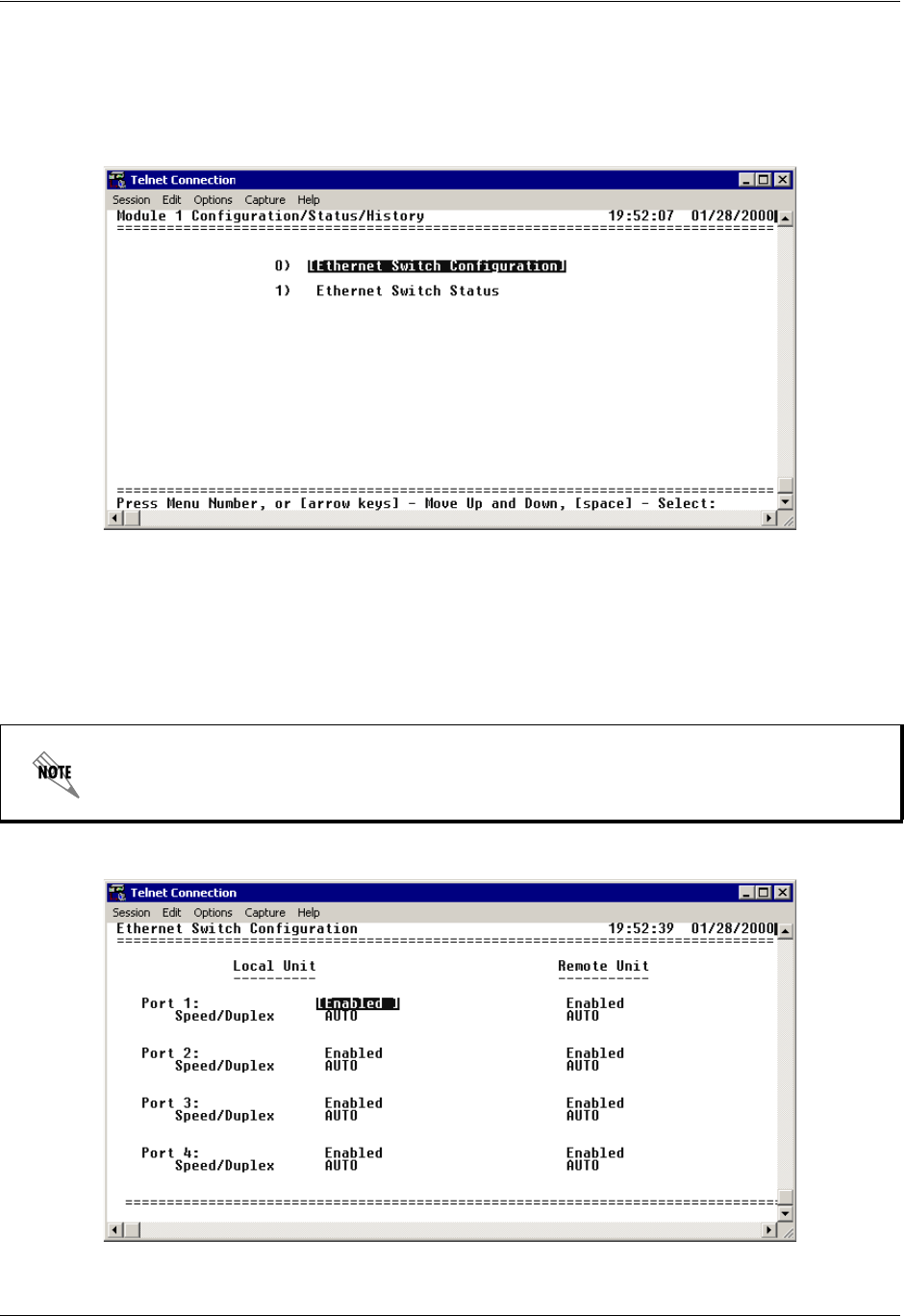
Section 5 User Interface Guide TRACER 6000 Series Split System Manual
78 612806320L1-1A
> ETHERNET SWITCH MODULE CONFIGURATION/STATUS/HISTORY (MAIN SCREEN)
Figure 26 shows the Ethernet Switch Module Configuration/Status/History main screen, which contains
access to the status, configuration, testing, and performance history parameters for the selected Ethernet
Switch module.
Figure 26. Ethernet Switch Module Configuration/Status/History (Main Screen)
> ETHERNET SWITCH CONFIGURATION
Figure 27 shows the Ethernet Switch Module Configuration screen, which contains access to the port
configuration options for the available Ethernet interfaces on the selected module.
Figure 27. Ethernet Switch Module Configuration
The following menus for the ETHERNET SWITCH CONFIGURATION apply to all four available
Ethernet interfaces (1 through 4).
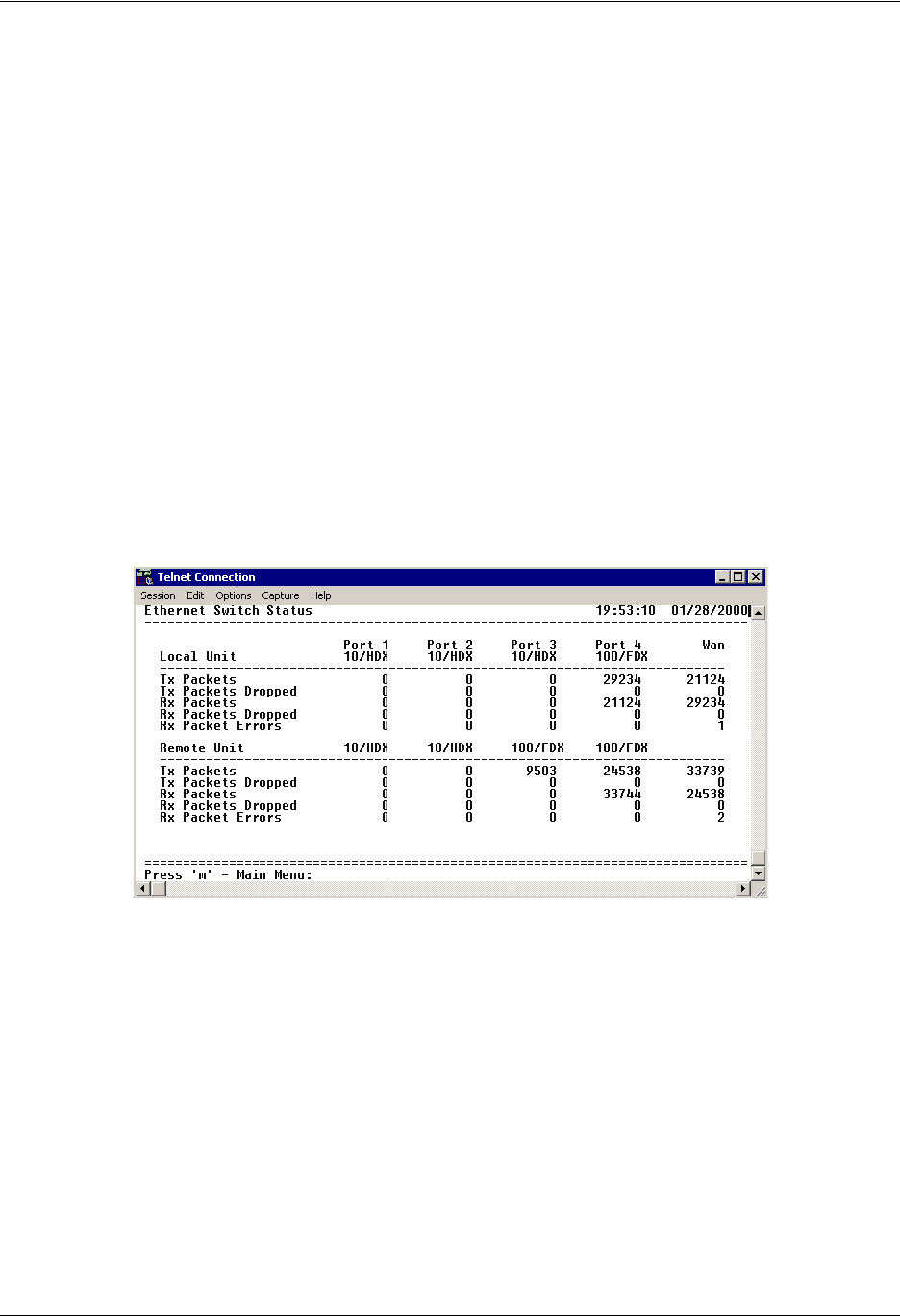
TRACER 6000 Series Split System Manual Section 5 User Interface Guide
612806320L1-1A 79
>ETHERNET SWITCH CONFIGURATION > PORT X
The Quad Ethernet Switch Module provides the capability to individually disable interfaces on the module.
Selecting DISABLE from the PORT X menu disables the port, stopping all data passing through the interface.
>ETHERNET SWITCH CONFIGURATION > SPEED/DUPLEX
Defines the speed and duplex for the selected Ethernet interface. Available options are: 100/FDX (100 Mbps
with full-duplex operation), 100/HDX (100 Mbps with half-duplex operation), 10/FDX (10 Mbps with
full-duplex operation), and 10/HDX (10 Mbps with half-duplex operation), and AUTO (automatically detects
speed and duplex of the connection). The speed and duplex settings of the TRACER Ethernet port and the
attached Ethernet equipment should be identical; if the TRACER is set to auto-negotiation, the attached
equipment should also be set for auto-negotiation.When the SPEED/DUPLEX is manually set, 802.3u
auto-negotiation is disabled; the Ethernet equipment connected to the manual port must be manually set to
the same speed/duplex settings. When set to AUTO, the actual negotiated speed and duplex of the system can
be displayed on the Ethernet Switch Status page.
> ETHERNET SWITCH STATUS
Figure 28 shows the Ethernet Switch Module Status screen, which displays the current speed and duplex
operation for each switch interface (on both the local and remote TRACER systems) as well as transmit and
receive data statistics for the Ethernet interface (from both the local and remote TRACER systems) and RF
link.
Figure 28. Ethernet Switch Module Status
>ETHERNET SWITCH STATUS > TX PACKETS
Displays a counter of all data packets transmitted out the local and remote TRACER Ethernet interfaces. Use
this data as an indicator of how many packets are being transmitted between the four Ethernet interfaces
versus over the wireless link (WAN stats). The WAN statistics (Ethernet packets transmitted over the RF
link) provide a quick way to determine Ethernet packet loss over the wireless link; the RX PACKETS on the
local system should match the TX PACKETS on the remote side (and vice versa).
>ETHERNET SWITCH STATUS > TX PACKETS DROPPED
Displays a counter of all transmit data packets that were unable to be transmitted out the individual Ethernet
interfaces (for both the local and remote TRACER units). Use this data as an indicator of congestion on the
Ethernet network segments. Dropped packets on the WAN interface can indicate that the provisioned
bandwidth for the switch module is insufficient.

Section 5 User Interface Guide TRACER 6000 Series Split System Manual
80 612806320L1-1A
>ETHERNET SWITCH STATUS > RX PACKETS
Displays a counter of all data packets received on the local and remote TRACER Ethernet interfaces and
WAN (RF link). Use this data as an indicator for how many packets are being received on the four Ethernet
interfaces versus being received over the wireless link.
>ETHERNET SWITCH STATUS > RX PACKETS DROPPED
Displays a counter of all received data packets that were unable to be processed due to congestion inside
the TRACER switch (for both the local and remote TRACER units). Use this data as an indicator of
congestion inside the TRACER switch.
>ETHERNET SWITCH STATUS > RX PACKET ERRORS
Displays a counter of all received data packets that are greater than or equal to 64 bytes in length and have
either an FCS error or an alignment error (for both the local and remote TRACER units). RX PACKET
ERRORS on the WAN interface (RF link) could indicate link degradation (due to interference, fading, etc.).
> MANAGEMENT/UTILITIES (MAIN SCREEN)
Figure 29 shows the TRACER Management/Utilities main screen, which contains access to the SNMP
configuration, firmware upgrade options, and a ping utility for Ethernet testing.
Figure 29. Management/Utilities (Main Screen)
If the RF link goes down, some packet errors may display. Once the TRACER system
recognizes the link is down (an active RF Low alarm), packet errors will NOT increment.
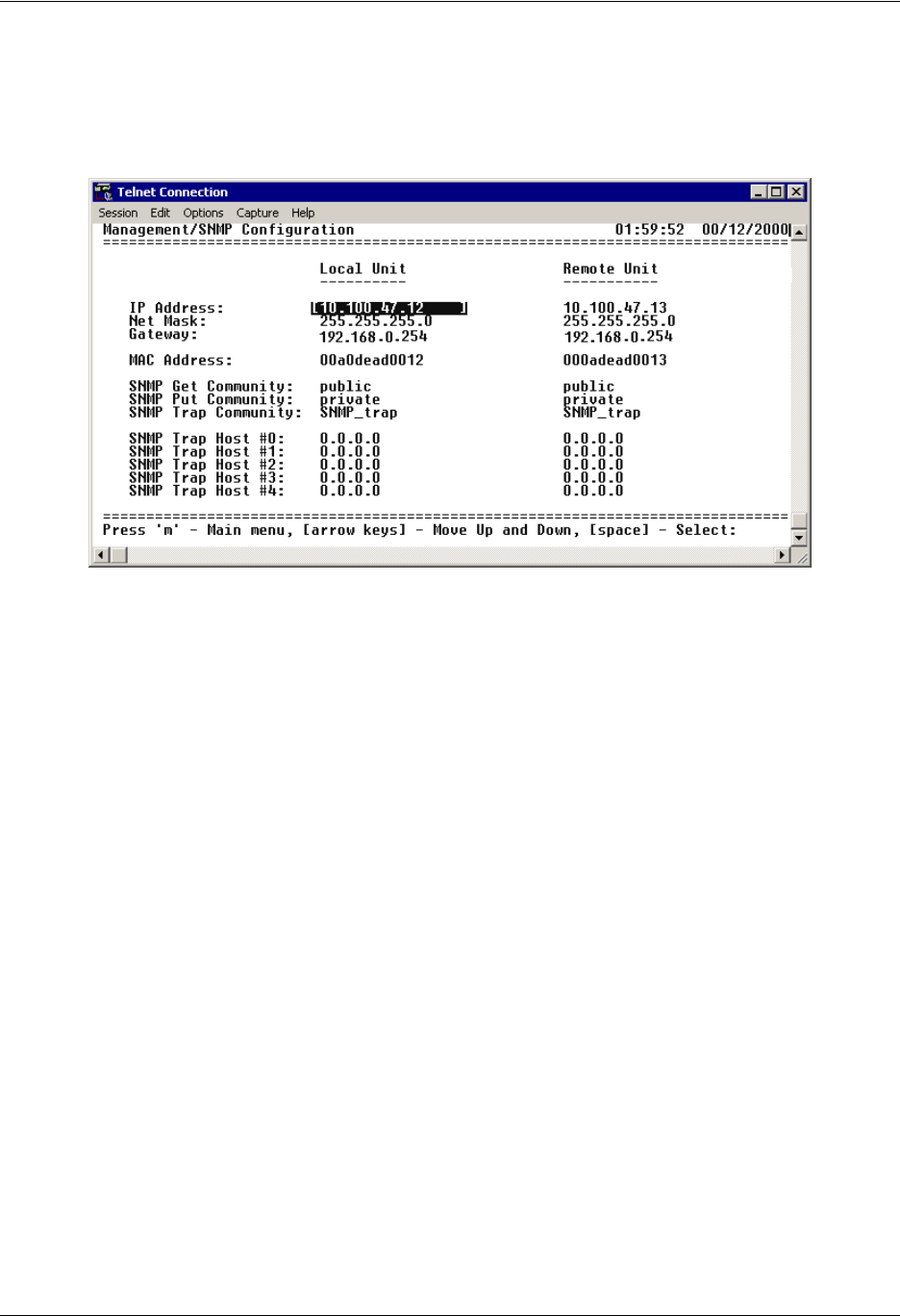
TRACER 6000 Series Split System Manual Section 5 User Interface Guide
612806320L1-1A 81
> MANAGEMENT/SNMP PORT CONFIGURATION
Figure 30 shows the Management/SNMP Port Configuration menu page, which contains the configuration
parameters for the 10/100BaseT/TX MGMT Ethernet interface and SNMP configuration parameters (from
both the local and remote TRACER units).
Figure 30. Management/SNMP Port Configuration
> MANAGEMENT/SNMP PORT CONFIGURATION > IP ADDRESS
Lists the address assigned to the 10/100BaseT/TX MGMT Ethernet port. This address is in dotted decimal
notation (four decimal numbers, each in the range of 0 to 255, separated by periods). This value is set to
192.168.0.10 by default. Obtain the correct IP address from your LAN administrator.
> MANAGEMENT/SNMP PORT CONFIGURATION > NET MASK
Defines which part of a destination IP address contains the network number. This address is in dotted
decimal notation (four decimal numbers, each in the range of 0 to 255, separated by periods). This value
is set to 255.255.255.0 by default. This part of the destination IP address is used along with the
TRACER IP address to determine which nodes must be reached through the default IP gateway.
> MANAGEMENT/SNMP PORT CONFIGURATION > DEFAULT GATEWAY
Defines or changes the default gateway. You will need a default gateway if the LAN contains multiple
segments. This address is in dotted decimal notation (four decimal numbers, each in the range of 0 to 255,
separated by periods). This value is set to 192.168.0.254 by default. Contact your LAN administrator for
the appropriate address.
> MANAGEMENT/SNMP PORT CONFIGURATION > MAC ADDRESS
(Read Only) Displays the system Ethernet Media Access Control (MAC) address.
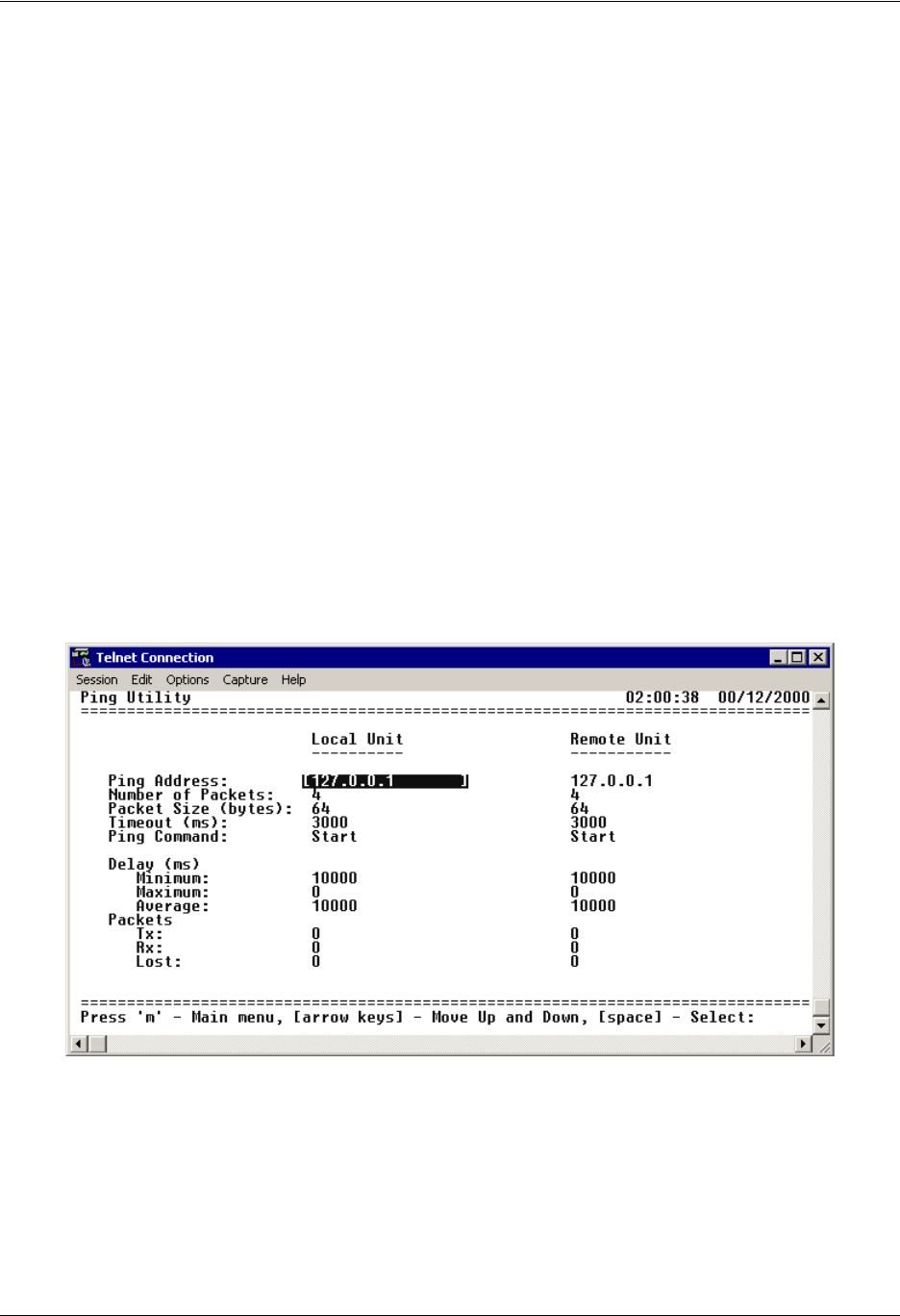
Section 5 User Interface Guide TRACER 6000 Series Split System Manual
82 612806320L1-1A
> MANAGEMENT/SNMP PORT CONFIGURATION > SNMP GET COMMUNITY
Defines the community name for Get access (to poll the TRACER for status information). This value must
match the Get name defined on the network management stations (NMS). Get access is read only access.
The default name is public.
> MANAGEMENT/SNMP PORT CONFIGURATION > SNMP PUT COMMUNITY
Defines the community name for Set access (to change TRACER configuration parameters through
SNMP). This value must match the Get or Set name defined on the NMS. The default name is private.
> MANAGEMENT/SNMP PORT CONFIGURATION > SNMP TRAP COMMUNITY
Defines the community name for trap destinations. This name must match the community name defined on
the NMS. The default name is SNMP_trap.
> MANAGEMENT/SNMP PORT CONFIGURATION > SNMP TRAP HOST #0 - #4
Identifies the IP address in dotted decimal notation of the NMS for the TRACER to send SNMP traps to.
Up to five trap destinations can be entered.
> PING UTILITY
Figure 31 shows the Ping Utility menu page, which contains the parameters for performing a ping test out
of the 10/100BaseT/TX MGMT Ethernet interface.
Figure 31. Ping Utility
> PING UTILITY > PING ADDRESS
Specifies the IP address to ping (in dotted decimal notation).

TRACER 6000 Series Split System Manual Section 5 User Interface Guide
612806320L1-1A 83
> PING UTILITY > NUMBER OF PACKETS
Specifies the number of ping packets to send to the IP address specified in the PING ADDRESS field. The
default value is 4, and the maximum value is 99.
> PING UTILITY > PACKET SIZE (BYTES)
Specifies the size (in bytes) of the data portion of the ping request. The default value is 64 bytes, and the
maximum size is 1472 bytes.
> PING UTILITY > TIMEOUT (MS)
Specifies the time (in milliseconds) to wait for a ping reply before timing out. The default timeout is
3 seconds (3000 milliseconds), and the maximum value is 10 seconds (10000 milliseconds).
> PING UTILITY > PING COMMAND
Use this field to manually start (START) or stop (ABORT) a ping request, reset the ping statistics (RESET
STATS), or return the ping configuration parameters to their default values (DEFAULT VALUES).
> PING UTILITY > DELAY
(Read Only) Displays the round trip time (in milliseconds) of the ping request/reply of the current set of
pings and provides the following information:
>PING UTILITY > PACKETS
(Read Only) Displays the packet statistics for the ping request/reply of the current set of pings and provides
the following information:
> FIRMWARE UPGRADE UTILITY
Figure 32 on page 84 shows the Firmware Upgrade Utility menu page, which contains the parameters for
performing a firmware upgrade for the local and remote systems.
MINIMUM The minimum round trip time of the ping request/reply for the
current set of pings.
MAXIMUM The maximum round trip time of the ping request/reply for the
current set of pings.
AVERAGE The average round trip time of the ping request/reply for the
current set of pings.
TXThe number of ping requests transmitted.
RXThe number of ping replies received.
LOST The number of ping requests that did not receive replies.
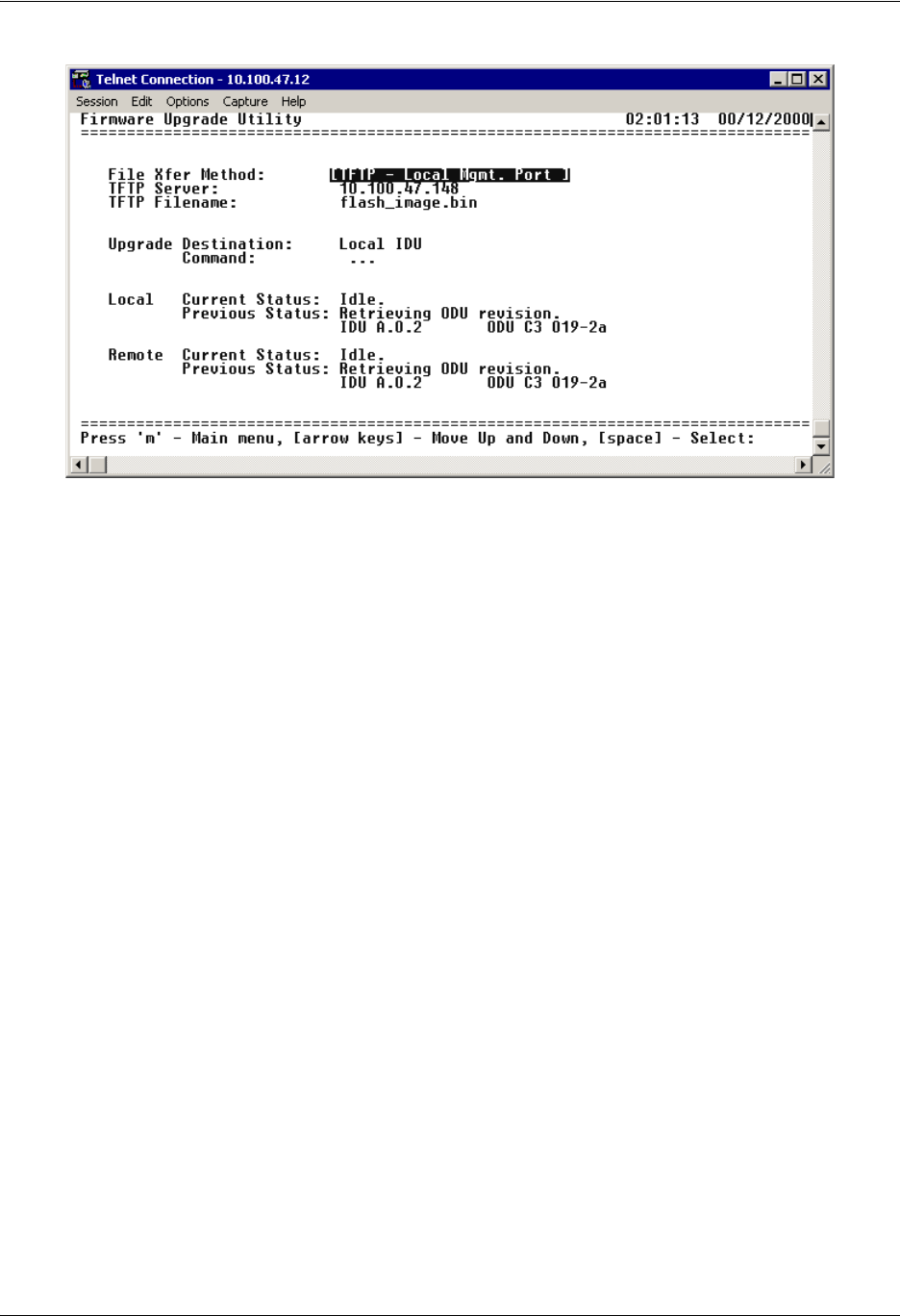
Section 5 User Interface Guide TRACER 6000 Series Split System Manual
84 612806320L1-1A
Figure 32. Firmware Upgrade Utility
> FIRMWARE UPGRADE UTILITY > FILE XFER METHOD
Lists the available transfer methods for updating the TRACER system. The following selections are
available:
> FIRMWARE UPGRADE UTILITY > TFTP SERVER
(Available for TFTP transfers only.) Configures the IP address of the TFTP server on which the update file
resides. The TRACER uses this field to locate the network TFTP server and request the file transfer.
> FIRMWARE UPGRADE UTILITY > TFTP FILENAME
(Available for TFTP transfers only.) Specifies the name of the update file to retrieve from the TFTP server.
Enter the full filename for the file. Some TFTP servers require the full path name for any file not located in
the default directory. Refer to the TFTP software documentation for more details.
TFTP LOCAL MGMT PORT Upgrade the firmware using a trivial file transfer protocol (TFTP)
server that is located on the same Ethernet network as the local
system. TFTP transfers files by specifying an appropriate server
address and filename.
TFTP REMOTE MGMT PORT Upgrade the firmware using a TFTP server that is located on the same
Ethernet network as the remote system. TFTP transfers files by
specifying an appropriate server address and filename.
XMODEM Upgrade the firmware using XMODEM software on a terminal or PC
that is connected to the CRAFT interface of the local system.

TRACER 6000 Series Split System Manual Section 5 User Interface Guide
612806320L1-1A 85
> FIRMWARE UPGRADE UTILITY > UPGRADE DESTINATION
Specify the unit to upgrade. The following options are available:
> FIRMWARE UPGRADE UTILITY > COMMAND
Use this command to start (START) or stop (ABORT) a firmware upgrade. For XMODEM updates, cancel
the process via the terminal emulation software (consult your documentation for instructions on how to do
this). For TFTP updates, you can cancel the process by selecting ABORT from this field.
> FIRMWARE UPGRADE UTILITY > LOCAL CURRENT STATUS
(Available for TFTP updates only.) Indicates progress or problems encountered during the current upgrade
of the local unit. The field displays IDLE if no update is in progress or when the update is successfully
completed. At the end of a successful update, the contents of this field are copied into the Local Previous
Status. For a detailed listing of these messages, please refer to DLP-5, Updating the Firmware Using
TFTP.
> FIRMWARE UPGRADE UTILITY > LOCAL PREVIOUS STATUS
(Available for TFTP updates only.) Displays the status of the previous update of the local unit. Following a
successful update, this field reads UPGRADE FINISHED SUCCESSFULLY. If an update was unsuccessful, the
appropriate error message displays. Refer to DLP-5, Updating the Firmware Using TFTP, for more details
on available error messages.
> FIRMWARE UPGRADE UTILITY > REMOTE CURRENT STATUS
(Available for TFTP updates only.) Indicates progress or problems encountered during the current upgrade
of the remote unit. The field displays IDLE if no update is in progress or when the update is successfully
completed. At the end of a successful update, the contents of this field are copied into the Local Previous
Status. For a detailed listing of these messages, please refer to DLP-5, Updating the Firmware Using
TFTP.
LOCAL IDU Upgrade the local IDU.
LOCAL ODU Upgrade the local ODU. When upgrading the local ODU, the upgrade
file is first loaded into the IDU and then transferred to the ODU.
REMOTE IDU Upgrade the remote IDU. When upgrading the remote IDU, the
upgrade file is first loaded into the local IDU and then transferred
through the ODU over the wireless link to the remote IDU. The actual
upgrade process is not started on the remote IDU until the entire
upgrade file has been received.
REMOTE ODU Upgrade the remote ODU. When upgrading the remote ODU, the
upgrade file is first loaded into the local IDU and then transferred
through the local ODU over the wireless link to the remote IDU. The
remote IDU then proceeds the update process of the ODU. The actual
upgrade process is not started on the remote side until the entire
upgrade file has been received.
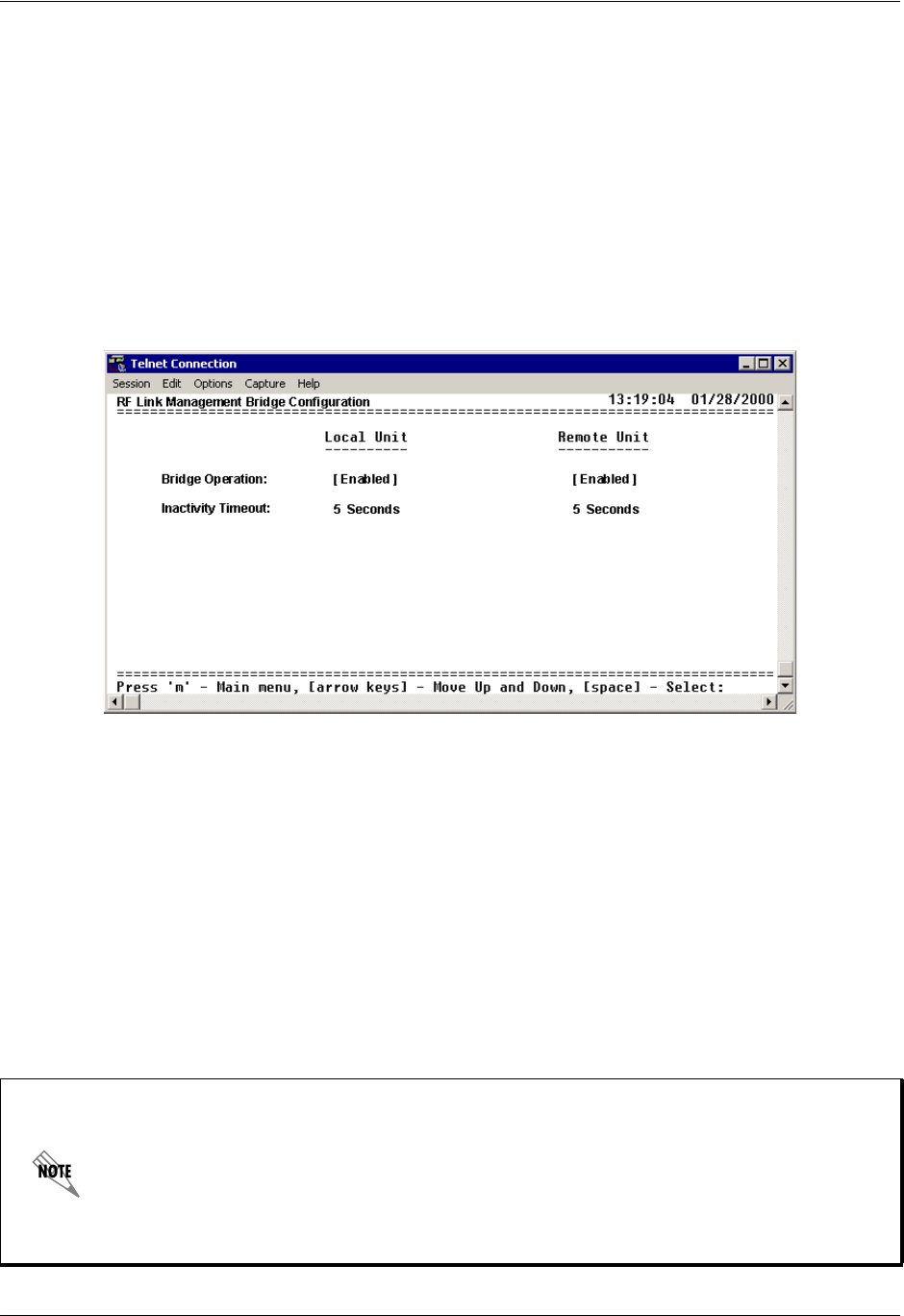
Section 5 User Interface Guide TRACER 6000 Series Split System Manual
86 612806320L1-1A
> FIRMWARE UPGRADE UTILITY > REMOTE PREVIOUS STATUS
(Available for TFTP updates only.) Displays the status of the previous update of the remote unit. Following
a successful update, this field reads UPGRADE FINISHED SUCCESSFULLY. If an update was unsuccessful, the
appropriate error message displays. Refer to DLP-5, Updating the Firmware Using TFTP, for more details
on available error messages.
> RF LINK MANAGEMENT BRIDGE CONFIGURATION
Figure 33 shows the RF Link Bridge Configuration menu page, which contains the parameters for enabling
and configuring the TRACER management bridge for passing information from the management port
across the RF link to the remote end.
Figure 33. RF Link Management Bridge Configuration
>RF LINK MANAGEMENT BRIDGE CONFIGURATION > BRIDGE OPERATION
The TRACER has the capability to pass management information received on the local management port
(MGMT) across the RF link to the remote end. This feature allows units to operate in a daisy-chain fashion
providing the user with configuration, management, and monitoring function for all TRACER systems in
the chain as well as any other Ethernet-capable device located on the same network segment as the
TRACER systems. The TRACER takes Ethernet traffic received on the local management port and
determines (using a MAC bridge functionality) whether the traffic is intended for the local TRACER
system or a system located over the RF link. If the BRIDGE OPERATION is ENABLED, and Ethernet traffic is
received on the MGMT interface for a remote TRACER system, the TRACER bridges the data over the
RF link. The RF Link Management Bridge feature is ENABLED by default.
The RF Link Management Bridge feature should only be used to pass TRACER
management information from one TRACER to another over the RF link. It is important to
employ an IP addressing scheme that allows for independent networks at the local and all
remote sites in the daisy-chain because the TRACER will bridge all Ethernet traffic bound
for a remote network over the RF link. Excessive bridge traffic can impede proper
management operation; it is recommended that bridge traffic be limited to configuration,
management, and monitoring functions.

TRACER 6000 Series Split System Manual Section 5 User Interface Guide
612806320L1-1A 87
>RF LINK MANAGEMENT BRIDGE CONFIGURATION > INACTIVITY TIMEOUT
Defines the amount of time that an Ethernet address is maintained in the bridge table. A shorter time
produces a more dynamic bridge table, allowing addresses to change network segments without causing
extra forwarded traffic. A longer time reduces the amount of unnecessarily forwarded traffic (due to
unknown Ethernet addresses), but causes the bridge table to respond more slowly to a MAC address
switching network segments. Valid choices are: 5 SEC (default), 15 SEC, 30 SEC, 1 MIN, and 5 MIN.

Section 5 User Interface Guide TRACER 6000 Series Split System Manual
88 612806320L1-1A

612806320L1-1A 89
DETAIL LEVEL PROCEDURES
Provides detailed instructions on performing common system tasks such as connecting to the system and
upgrading firmware.
CONTENTS
DLP-1 Connecting a VT100 Terminal or PC to the CRAFT Port. . . . . . . . . . . . . . . . . . . . . . . . . . . . 91
DLP-2 Logging into the TRACER System. . . . . . . . . . . . . . . . . . . . . . . . . . . . . . . . . . . . . . . . . . . . . 93
DLP-3 Setting IP Parameters for the TRACER System . . . . . . . . . . . . . . . . . . . . . . . . . . . . . . . . . . 95
DLP-4 Verifying Communications Over an IP LAN . . . . . . . . . . . . . . . . . . . . . . . . . . . . . . . . . . . . . . 99
DLP-5 Updating the Firmware Using TFTP. . . . . . . . . . . . . . . . . . . . . . . . . . . . . . . . . . . . . . . . . . . 101
DLP-6 Updating the Firmware Using XMODEM . . . . . . . . . . . . . . . . . . . . . . . . . . . . . . . . . . . . . . . 105

Section 6 Detail Level Procedures TRACER 6000 Series Split System Manual
90 612806320L1-1A
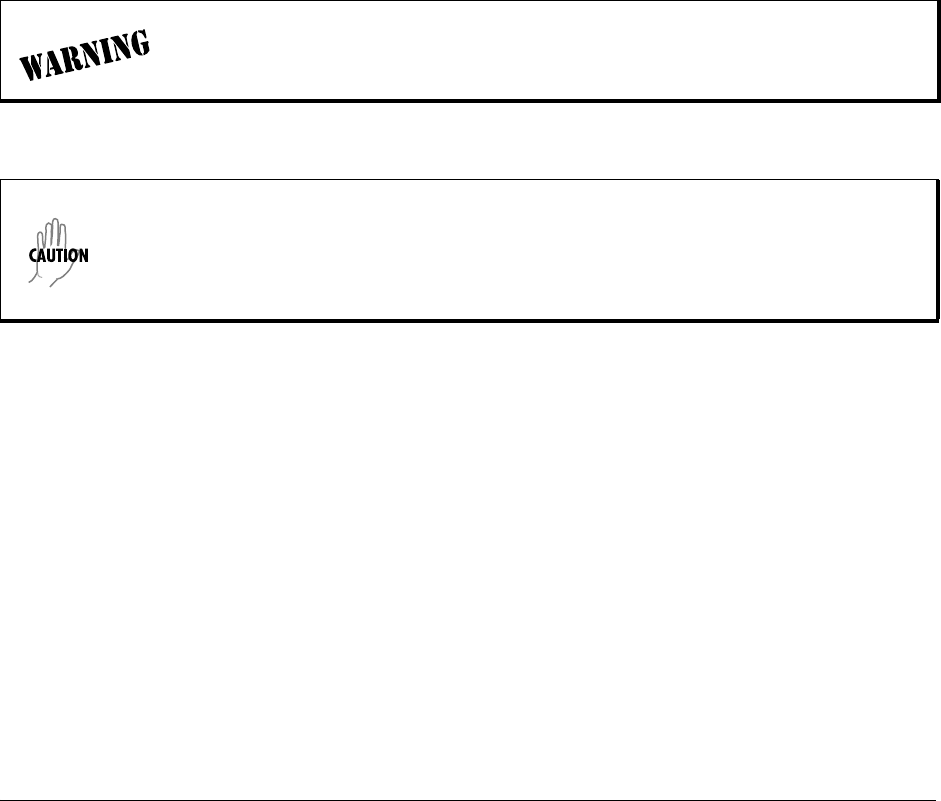
612806320L1-1A Copyright © 2005 ADTRAN, Inc. 91
DLP-1 Connecting a VT100 Terminal or PC to the CRAFT Port
Introduction
TRACER management and provisioning are facilitated by a series of intuitive menus that are accessible on
a computer screen. Connecting either a VT100 terminal or a PC with terminal emulation software to the
CRAFT interface (DB-9) on the front of the unit allows access to the menus and management features of
the TRACER. This section specifies how to connect the VT100 terminal or PC to the TRACER.
Prerequisite Procedures
The TRACER must be powered up for terminal communication to function.
Tools and Materials Required
• A VT100 compatible terminal or PC with terminal emulation software
• An appropriate cable to connect the TRACER to a terminal
To prevent electrical shock, do not install equipment in a wet location or during a
lightning storm.
Electronic equipment can be damaged by static electrical discharge. Before handling it,
put on an antistatic discharge wrist strap to prevent damage to electronic components.
Place equipment in antistatic packing material when transporting or storing. When
working on equipment, always place it on an approved antistatic mat that is electrically
grounded.

Section 6 DLP-1 TRACER 6000 Series Split System Manual
92 Copyright © 2005 ADTRAN, Inc. 612806320L1-1A
1. Connecting a VT100 terminal to the TRACER 6200:
2. Connecting a PC emulating a VT100 terminal to the TRACER 6200:
Most PCs or laptops can run communications software that emulates a VT100 terminal. Examples
include Windows programs such as Terminal® or Hyperterminal®. However, there are many other
adequate, commercially available software packages which will allow your PC or laptop to emulate a
VT100 terminal.
You are now ready to log in to the system, as described in DLP-2, Logging into the TRACER System.
Perform one of the following steps:
• Set the parameters of the VT100 terminal or PC to:
– 9600 baud rate
– 8 data bits
– No parity
– 1 stop bit
– No flow control
• If the terminal has a parallel setting, disable this setting and use the serial port.
Using the CRAFT Port
• Plug the DB-9 male end of the data cable into the TRACER 6200 CRAFT port on the front
of the unit. Make the connection to the VT100 terminal as appropriate for your equipment.
• Set the parameters of the communications software to:
– 9600 baud rate
– 8 data bits
– No parity
– 1 stop bit
– No flow control
• Set the PC for direct connect on the appropriate com port (instead of dial up connection).
Using the CRAFT Port
• Plug the DB-9 male end of the data cable into the TRACER 6200 CRAFT port on the front
of the unit. Make connection to the PC or laptop as appropriate for your equipment.
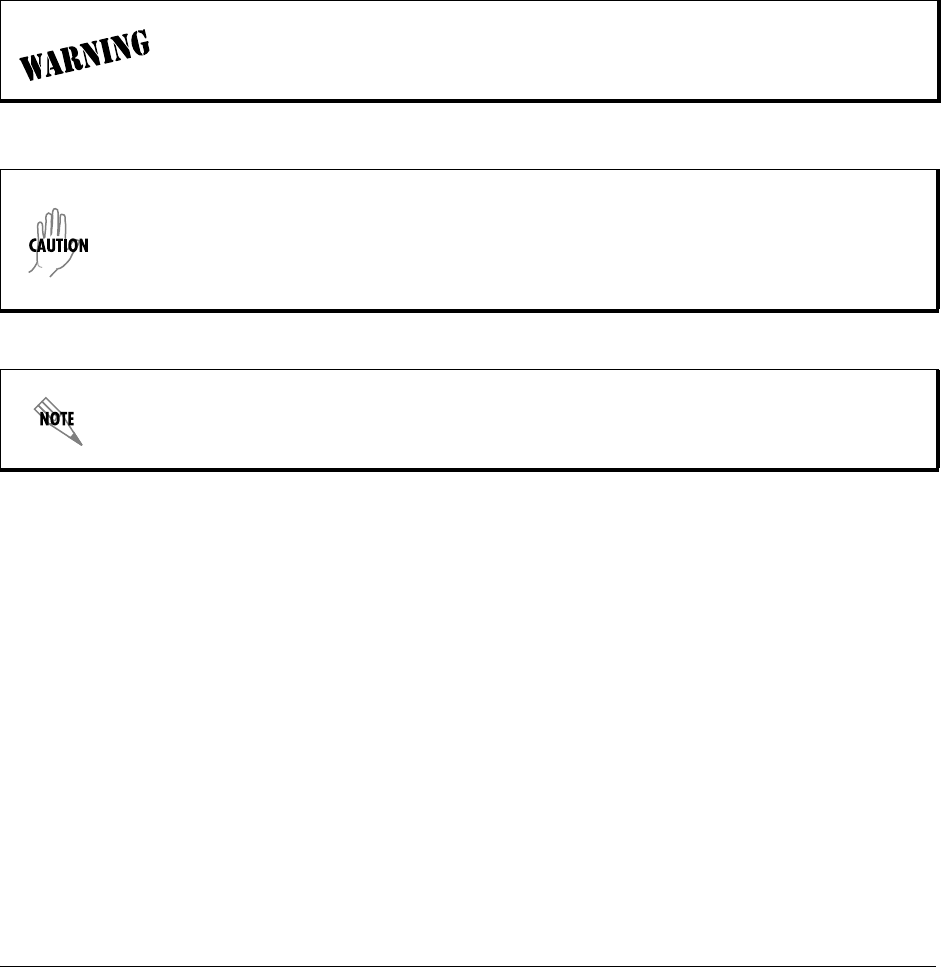
612806320L1-1A Copyright © 2005 ADTRAN, Inc. 93
DLP-2 Logging into the TRACER System
Introduction
Once you are connected to the TRACER (via the TRACER 6200), you must log in to the system to gain
access to the management and provisioning functions. This DLP assumes you are connected to the
TRACER 6200 and provides specific steps for logging into the system.
Prerequisite Procedures
Complete DLP-1, Connecting a VT100 Terminal or PC to the CRAFT Port on page 91.
To prevent electrical shock, do not install equipment in a wet location or during a
lightning storm.
Electronic equipment can be damaged by static electrical discharge. Before handling it,
put on an antistatic discharge wrist strap to prevent damage to electronic components.
Place equipment in antistatic packing material when transporting or storing. When
working on equipment, always place it on an approved antistatic mat that is electrically
grounded.
After the IP parameters have been provisioned (see DLP-3, Setting IP Parameters for the
TRACER System on page 95), you can also log in via Telnet.
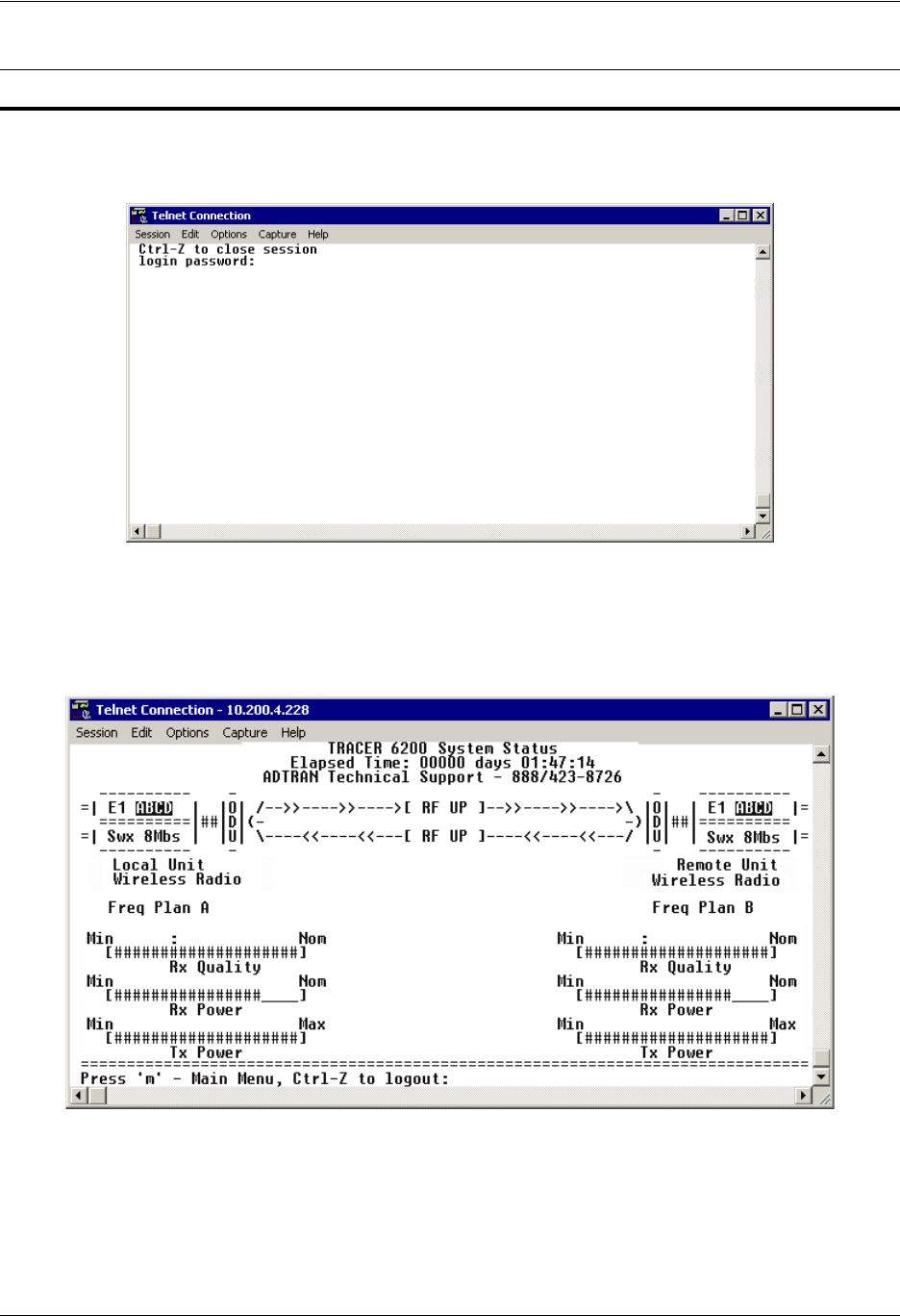
Section 6 DLP-2 TRACER 6000 Series Split System Manual
94 Copyright © 2005 ADTRAN, Inc. 612806320L1-1A
1. After connecting to the system, press <Enter> twice to display the LOGIN screen shown here. The
flashing cursor at the LOGIN field indicates that a password must be entered.
2. Enter the password for the TRACER at the LOGIN field. The manufacturer’s default password for the
TRACER system is password in lowercase letters.
3. Upon entering the correct password, the TRACER SYSTEM STATUS page is displayed as shown below.
4. You are now logged in to the TRACER menu system.
Perform the steps below in the order listed.

612806320L1-1A Copyright © 2005 ADTRAN, Inc. 95
DLP-3 Setting IP Parameters for the TRACER System
Introduction
If the TRACER 6200 is connected to an IP network for Telnet, TFTP, or SNMP management, several IP
parameters must be set for the unit to communicate with the network. These parameters are described in
this DLP along with the procedures for setting them.
Prerequisite Procedures
This procedure assumes that the TRACER 6200 unit is connected to an IP network and is powered up.
Please see your Network Administrator for the proper assignment of the following
parameters: IP ADDRESS, SUBNET MASK, and DEFAULT GATEWAY.
To prevent electrical shock, do not install equipment in a wet location or during a
lightning storm.
Electronic equipment can be damaged by static electrical discharge. Before handling it,
put on an antistatic discharge wrist strap to prevent damage to electronic components.
Place equipment in antistatic packing material when transporting or storing. When
working on equipment, always place it on an approved antistatic mat that is electrically
grounded.
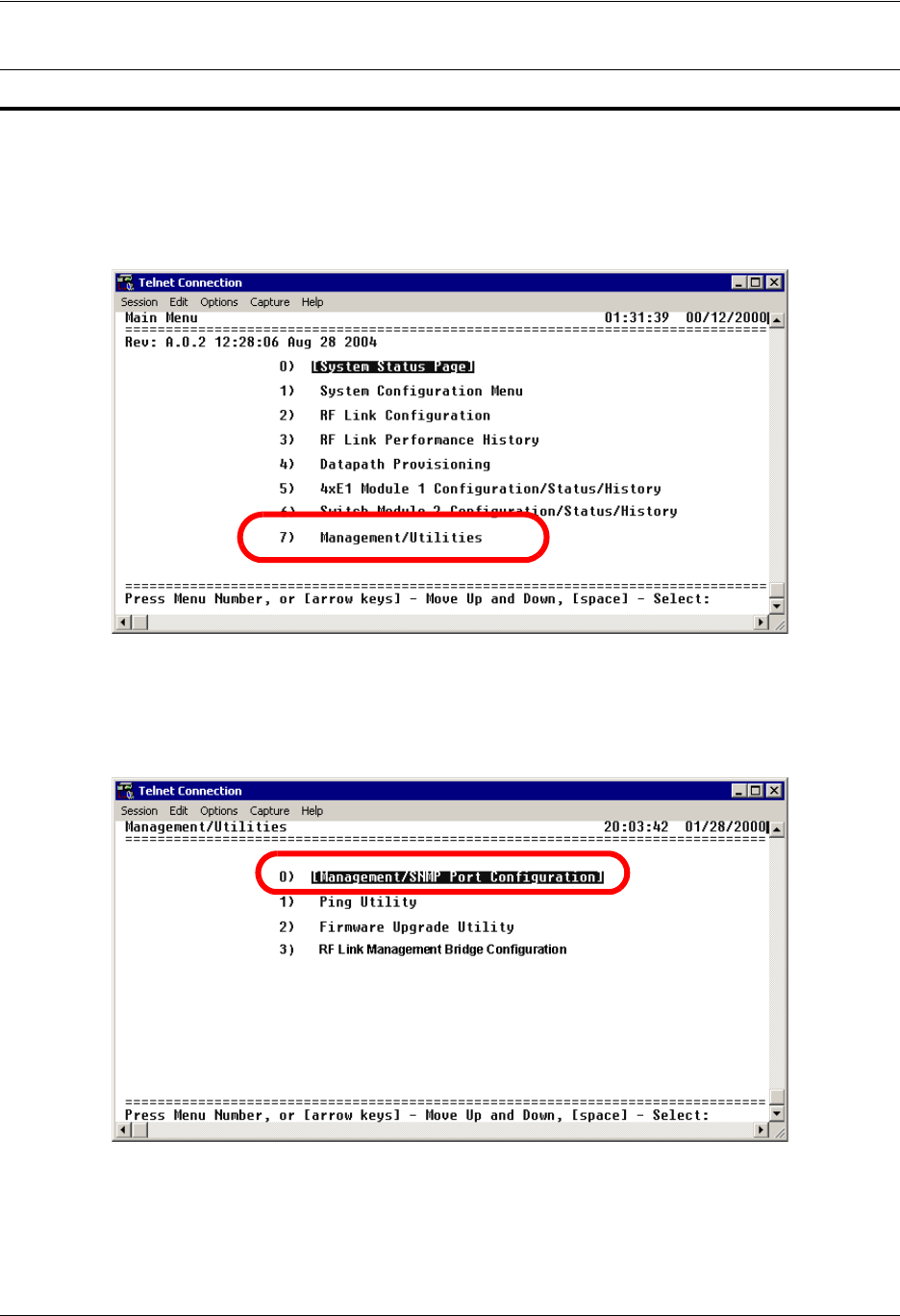
Section 6 DLP-3 TRACER 6000 Series Split System Manual
96 Copyright © 2005 ADTRAN, Inc. 612806320L1-1A
1. Log in to the system with maximum rights (details are in DLP-2, Logging into the TRACER System on
page 93).
2. Press M to activate the Main menu page. From the Main menu page, press 7 to select
MANAGEMENT/UTILITIES.
3. From the MANAGEMENT/UTILITIES page, select the MANAGEMENT/SNMP PORT CONFIGURATION option
and press <Enter>.
Perform the steps below in the order listed.

TRACER 6000 Series Split System Manual Section 6 DLP-3
612806320L1-1A Copyright © 2005 ADTRAN, Inc. 97
4. From the Management/SNMP Configuration menu page, select the IP ADDRESS field and press
<Enter>. Type the IP address provided by your network manager and press <Enter> to accept the
change. Repeat the process for the SUBNET MASK and DEFAULT GATEWAY options.
The TRACER is now available for Telnet access. Complete the steps outlined in DLP-4, Verifying
Communications Over an IP LAN on page 99.

Section 6 DLP-3 TRACER 6000 Series Split System Manual
98 Copyright © 2005 ADTRAN, Inc. 612806320L1-1A

612806320L1-1A Copyright © 2005 ADTRAN, Inc. 99
DLP-4 Verifying Communications Over an IP LAN
Introduction
When the 10/100BaseT/TX MGMT port is connected to a local area network (LAN), test steps must be
performed on the TRACER 6200 to ensure that the unit is communicating properly over the network. This
procedure outlines those steps.
Prerequisite Procedures
Before beginning this procedure, the unit should be physically connected to the LAN and the provisioning
tasks detailed in DLP-3, Setting IP Parameters for the TRACER System on page 95, should be complete.
Tools and Materials Required
• Access to a PC or other computer connected to the LAN
To prevent electrical shock, do not install equipment in a wet location or during a
lightning storm.
Electronic equipment can be damaged by static electrical discharge. Before handling it,
put on an antistatic discharge wrist strap to prevent damage to electronic components.
Place equipment in antistatic packing material when transporting or storing. When
working on equipment, always place it on an approved antistatic mat that is electrically
grounded.
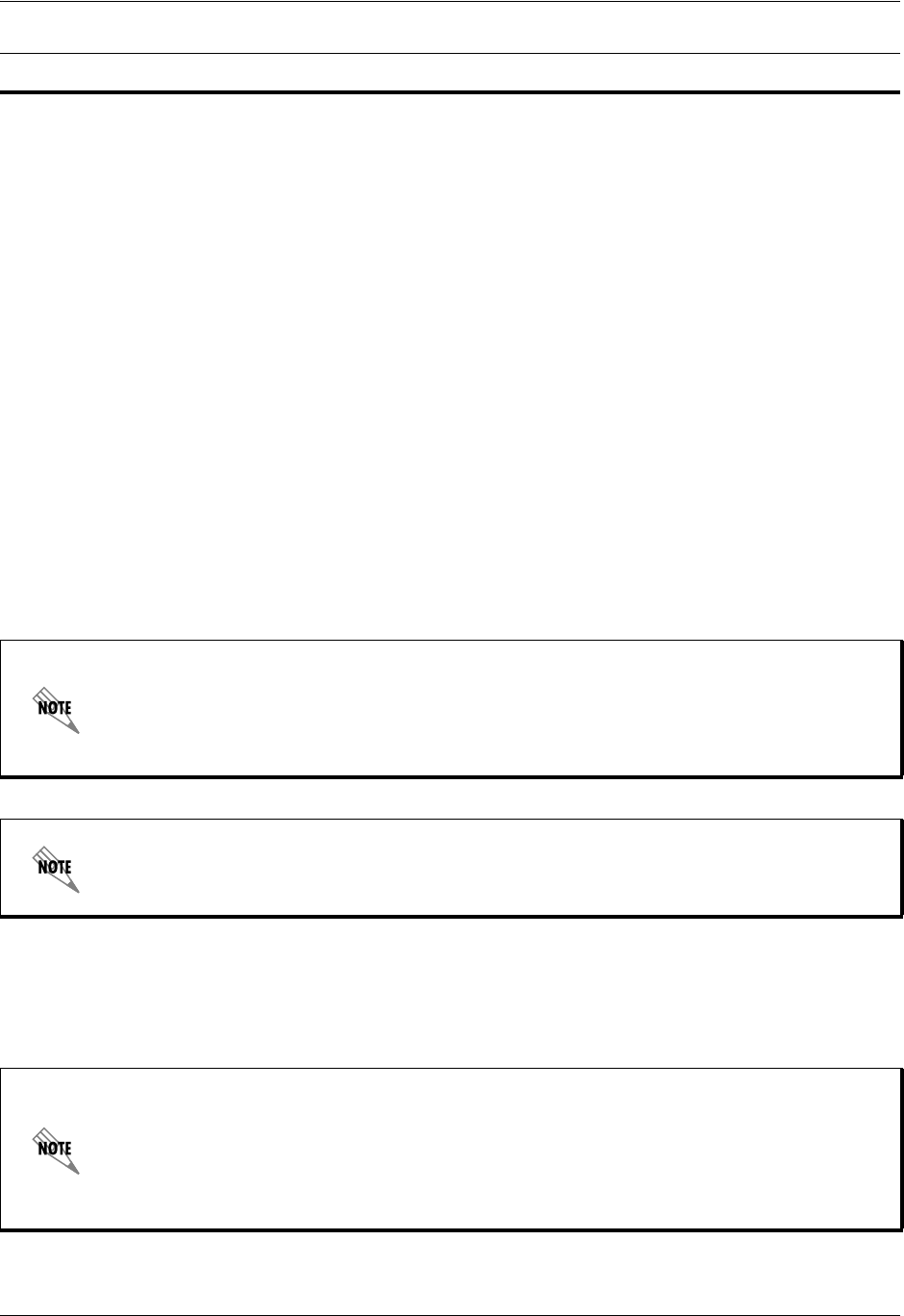
Section 6 DLP-4 TRACER 6000 Series Split System Manual
100 Copyright © 2005 ADTRAN, Inc. 612806320L1-1A
1. Verify the TRACER IP address.
If you do not already have the IP Address for the TRACER, obtain it from the network administrator or
manually check for the address on the MANAGEMENT/SNMP CONFIGURATION page. (Access the
MANAGEMENT/SNMP CONFIGURATION page by pressing 7 and then 1 from the Main menu page.)
2. Ping the TRACER unit from a remote computer on the network.
Using a remote computer system connected to the LAN, perform an ICMP ping on the IP address of
the TRACER. Verify that the unit responds properly. If the TRACER fails to respond, try the following:
• Verify that the proper IP address, subnet mask, and default gateway are provisioned in the unit (see
DLP-3, Setting IP Parameters for the TRACER System on page 95, for details).
• Verify that the TRACER is properly cabled into the LAN and that the Ethernet cable is properly
seated in the RJ-45 jack on the rear of the unit.
• If the TRACER is connected to a hub or other network device that provides a carrier sense light for
each port, verify that the carrier sense light for the port to which the TRACER is connected is lit. If
this light is not lit, check the cabling between the hub and the shelf. The connection may also be
verified using the activity LED located on the rear of the unit (part of the 10/100BaseT/TX MGMT
RJ-45 connector).
• Verify the IP address, subnet mask, and default gateway on the remote computer system.
• If none of these steps are successful, contact the LAN Administrator for assistance.
3. Telnet to the TRACER.
From the same computer used in the previous step, Telnet to the TRACER and verify that the Telnet
session is properly opened. Once the Telnet session is established, press <Ctrl+z> to logout of the
session and return to the Login screen. Pressing <Ctrl + z> again closes the Telnet session.
Perform the following steps in the order listed.
Refer to the computer system’s documentation if you are unsure how to perform a ping
command. Most computers running a networked version of Microsoft Windows™ or UNIX
allow a ping to be performed by typing ping <IP Address> at a command line prompt.
Typically, the ping program will respond by indicating that the remote IP Address has
responded in a certain amount of time or that no response was received.
Some versions of ping will continue running until you explicitly tell them to stop. If the
program does not terminate on its own, type <Ctrl+c> to stop the program.
Refer to the documentation of the computer system if you are unsure how to initiate a
Telnet session. Most computers running a networked version of Microsoft Windows® or
UNIX initiate a Telnet session by typing telnet <IP Address> at a command line prompt.
The Windows XP HyperTerminal program also provides a Telnet client. Telnet is a utility
common on many local area networks that allows remote access to another computer or
piece of equipment.

612806320L1-1A Copyright © 2005 ADTRAN, Inc. 101
DLP-5 Updating the Firmware Using TFTP
Introduction
The TRACER 6000 Series split system supports firmware updates using TFTP or XMODEM. Use the
TRACER 6200 10/100BaseT/TX MGMT Ethernet port and TFTP from a network server or XMODEM (if
your Telnet client supports file transfers), or use XMODEM and the CRAFT interface. This DLP provides
the steps for a successful firmware upgrade using the 10/100 BaseT/TX MGMT Ethernet port and a TFTP
server. (See DLP-6, Updating the Firmware Using XMODEM on page 105, for instructions on using
XMODEM.)
Tools and Materials Required
• A PC with Telnet client software
• A TFTP server accessible on the network
To prevent electrical shock, do not install equipment in a wet location or during a
lightning storm.
Electronic equipment can be damaged by static electrical discharge. Before handling it,
put on an antistatic discharge wrist strap to prevent damage to electronic components.
Place equipment in antistatic packing material when transporting or storing. When
working on equipment, always place it on an approved antistatic mat that is electrically
grounded.

Section 6 DLP-5 TRACER 6000 Series Split System Manual
102 Copyright © 2005 ADTRAN, Inc. 612806320L1-1A
1. Connect to the TRACER using the 10/100BaseT/TX MGMT interface.
If you are not already connected to the unit’s 10/100BaseT/TX MGMT port using Telnet client
software, use the procedure in DLP-3, Setting IP Parameters for the TRACER System on page 95, to
connect to the unit.
2. Press M to go to the Main menu page.
3. Select the MANAGEMENT/UTILITIES menu and press <Enter>.
4. Select the FIRMWARE UPGRADE UTILITY menu and press <Enter>.
5. Go to the FILE XFER METHOD menu and select TFTP. The TRACER can use a TFTP server connected
to the same Ethernet network as the local unit or a TFTP server connected to the same Ethernet
network as the remote unit. Make the appropriate selection for your setup (choices are TFTP-LOCAL
MGMT PORT or TFTP-REMOTE MGMT PORT).
6. Go to the TFTP SERVER field and enter the IP address of the network TFTP server.
7. Go to the TFTP FILENAME field and enter the filename of the firmware. TRACER firmware files have a
.bin extension. When specifying the filename, include the full path if the firmware file is not located in
the TFTP default location. For example, to use a firmware file in the c:\firmware folder on your local
machine, enter c:\firmware\myfirmware.bin into the TFTP FILENAME field.
8. Select the UPGRADE DESTINATION. Using TFTP provides the capability to upgrade both sections of the
local and remote units. Valid choices are LOCAL IDU, LOCAL ODU, REMOTE IDU, and REMOTE ODU.
View CURRENT UPDATE STATUS to verify the progress of the current firmware update or to identify any
errors encountered during the download.
During the TFTP upload, the following status messages display in CURRENT UPDATE STATUS to
indicate the progress of the upload:
Perform the following steps in the order listed.
IDLE No active firmware upgrade.
IDU RESET Indicates the firmware file transfer to the IDU is complete and the
system is rebooting to load the new firmware.
UPGRADE ABORTED Indicates the firmware upgrade was manually aborted by selecting
ABORT from the COMMAND field.
CONTACTING TFTP SERVER Indicates communication with the TFTP network server is trying to be
established with the specified server address in the TFTP SERVER IP
ADDRESS field.
REQUESTING TFTP OF
FILENAME
Indicates the TRACER is requesting TFTP access to the given update
filename and path. Please verify appropriate user rights are selected for
the specified path.
TFTP TRANSFER IN
PROGRESS
Indicates communication with the TFTP network server has been
established and the update file is being transferred between the
TRACER and the TFTP network server.
UPGRADE IMAGE IS VALID Indicates that the system image was verified as a valid image for
the specified update. Before the firmware upgrade begins, the
TRACER verifies that the image is valid. If it is not valid for the system,
UPGRADE IMAGE IS INVALID displays.

TRACER 6000 Series Split System Manual Section 6 DLP-5
612806320L1-1A Copyright © 2005 ADTRAN, Inc. 103
UPGRADE IMAGE IS INVALID Indicates that the system image was not verified as a valid image for
the specified update. Before the firmware upgrade begins, the
TRACER verifies that the image is valid. If it is not valid for the system,
UPGRADE IMAGE IS INVALID displays.
WAITING FOR SC TRANSFER
TO BEGIN
Indicates that the local system is waiting to transfer the firmware
upgrade information to the remote system over the service channel.
Service channel communications over the RF link allow a user
connected to a local system to upgrade the firmware of a remote
system. Before the remote system begins the firmware upgrade
process, a complete copy of the new firmware image must be received
and stored in the remote system. This is done automatically when the
remote system is chosen from the UPGRADE DESTINATION field.
RECEIVING SC TRANSFER Indicates that the system is receiving the firmware upgrade information
from the remote system over the service channel. Service channel
communications over the RF link allow a user connected to a local
system to upgrade the firmware of a remote system. Before the remote
system begins the firmware upgrade process, a complete copy of the
new firmware image must be received and stored in the remote system.
This is done automatically when the remote system is chosen from the
UPGRADE DESTINATION field.
READY TO BEGIN SENDING SC
TRANSFER
Indicates that the local system is ready to transfer the firmware upgrade
information to the remote system over the service channel. Service
channel communications over the RF link allow a user connected to a
local system to upgrade the firmware of a remote system. Before the
remote system begins the firmware upgrade process, a complete copy
of the new firmware image must be received and stored in the remote
system. This is done automatically when the remote system is chosen
from the UPGRADE DESTINATION field.
SENDING SC TRANSFER Indicates that the local system is sending the firmware upgrade
information to the remote system over the service channel. Service
channel communications over the RF link allow a user connected to a
local system to upgrade the firmware of a remote system. Before the
remote system begins the firmware upgrade process, a complete copy
of the new firmware image must be received and stored in the remote
system. This is done automatically when the remote system is chosen
from the UPGRADE DESTINATION field.
VERIFYING FLASH IMAGE Indicates that the system flash image is being verified as a valid image
for the specified update. Before the new firmware is loaded into the local
flash, the TRACER verifies that the flash image is valid for the new
firmware. If it is not valid for the system the firmware upgrade fails.
ERASING FLASH Indicates that the system flash is being erased so the new firmware
image can be loaded into the local flash. Before the new firmware is
loaded into the local flash, the TRACER verifies that the flash image is
valid for the new firmware. If it is not valid for the system the firmware
upgrade fails.
PROGRAMMING FLASH Indicates that the new firmware image is being loaded into the local
flash. Before the new firmware is loaded into the local flash, the
TRACER verifies that the flash image is valid for the new firmware. If it is
not valid for the system the firmware upgrade fails.

Section 6 DLP-5 TRACER 6000 Series Split System Manual
104 Copyright © 2005 ADTRAN, Inc. 612806320L1-1A
9. When the update has successfully completed, IDLE displays in the CURRENT UPDATE STATUS field and
UPGRADE FINISHED SUCCESSFULLY displays in the PREVIOUS UPDATE STATUS field.
The TRACER will restart immediately and resume operation. During reset and initialization, the RF link
between the units will not be operational.
RETRIEVING ODU REVISION Indicates that the system is communicating with the ODU to obtain the
current firmware revision of the system. (This only occurs when the local
or remote ODU is selected from the UPGRADE DESTINATION field.)
REQUIRED COMMUNICATIONS
LINK IS DOWN
Indicates that a remote system firmware upgrade cannot be completed
due to a problem with either the RF link or the service channel. Before a
firmware upgrade begins the system verifies that communication
between all required parts is operational. If this check fails, the firmware
upgrade fails.
UPGRADE FAILED Indicates that the firmware upgrade was unsuccessful.
UPGRADE FINISHED
SUCCESSFULLY
Indicates that the firmware upgrade completed successfully and the new
firmware should be loaded and running.

612806320L1-1A Copyright © 2005 ADTRAN, Inc. 105
DLP-6 Updating the Firmware Using XMODEM
Introduction
The TRACER 6000 Series split system supports firmware updates of the local and remote systems using
TFTP or XMODEM. Use the TRACER 6200 10/100BaseT/TX MGMT port and TFTP from a network
server or XMODEM (if your Telnet client supports file transfers), or use XMODEM and the CRAFT
interface. This procedure outlines the steps for a successful firmware upgrade using the CRAFT interface
and XMODEM software. The same XMODEM steps apply for file transfers through your Telnet client
(refer to your Telnet client documentation for more details on file transfer specifics). (See DLP-5,
Updating the Firmware Using TFTP on page 101, for instructions on using TFTP.)
Tools and Materials Required
• VT100 terminal or PC with VT100 terminal emulation software
• XMODEM software
To prevent electrical shock, do not install equipment in a wet location or during a
lightning storm
Electronic equipment can be damaged by static electrical discharge. Before handling it,
put on an antistatic discharge wrist strap to prevent damage to electronic components.
Place equipment in antistatic packing material when transporting or storing. When
working on equipment, always place it on an approved antistatic mat that is electrically
grounded.

Section 6 DLP-6 TRACER 6000 Series Split System Manual
106 Copyright © 2005 ADTRAN, Inc. 612806320L1-1A
1. Connect to the TRACER using the front panel DB-9 CRAFT interface.
If you are not already connected to the unit’s CRAFT interface (either with a VT100 compatible
terminal or with a PC running VT100 emulation software), follow the procedure in DLP-1, Connecting a
VT100 Terminal or PC to the CRAFT Port on page 91. Connecting to the CRAFT interface limits the
upgrade procedure to XMODEM only.
2. Log in to the unit (see DLP-2, Logging into the TRACER System on page 93 for details).
3. Press M to go to the Main menu page.
4. Select the MANAGEMENT/UTILITIES menu and press <Enter>.
5. Select the FIRMWARE UPGRADE UTILITY menu and press <Enter>.
6. Go to the FILE XFER METHOD menu and select XMODEM.
7. Select the UPGRADE DESTINATION. (Valid selections for XMODEM are LOCAL IDU and LOCAL ODU).
8. View CURRENT UPDATE STATUS to verify the progress of the current firmware update or to identify any
errors encountered during the download.
9. Select START from the COMMAND menu to start the update.
When the TRACER is ready to receive the XMODEM upload, the menu screen will clear and display
XMODEM waiting for start....<Ctrl-X> twice to Cancel. If this does not appear, please review the
steps above for possible configuration errors.
10. From the terminal emulation software, begin the XMODEM upload by using the appropriate command
sequence. This may take several minutes.
If necessary, refer to the terminal emulation software documentation for help. Also, when specifying
the filename, ensure that the file transferred is the one provided by ADTRAN. Otherwise, the update
will not complete successfully.
Because XMODEM data is being transferred inband through the menu interface, the VT100 menus of
the TRACER will be inoperable from the CRAFT interface. You can cancel the update at any time
within the terminal emulation software. (Please consult the documentation provided by the terminal
emulation software to determine how to do this).
11. When the update has successfully completed, IDLE displays in the CURRENT UPDATE STATUS field and
UPGRADE FINISHED SUCCESSFULLY displays in the PREVIOUS UPDATE STATUS field.
The TRACER will restart immediately and resume operation. During reset and initialization, the RF link
between the units will not be operational.
Alternatively, if the unit is part of a management cluster connected to the local network, you may use a
PC connected to the network to Telnet into the unit. By using the 10/100BaseT/TX MGMT port, the
TRACER may be quickly upgraded using TFTP, provided there is a TFTP server on the local network.
(See DLP-5, Updating the Firmware Using TFTP on page 101 for more details.)
Perform the following steps in the order listed.

612806320L1-1A Copyright © 2005 ADTRAN, Inc. 107
MIBS
Provides a listing of SNMP Management Information Bases (MIBs) supported by the TRACER 6000 split
system. This section also lists traps supported for each MIB.
CONTENTS
MIBs Supported by the TRACER 6000 split system . . . . . . . . . . . . . . . . . . . . . . . . . . . . . . . . . . 108
MIB Compilation Order . . . . . . . . . . . . . . . . . . . . . . . . . . . . . . . . . . . . . . . . . . . . . . . . . . . . . . . . . 108
Traps Supported by the TRACER 6000 split system . . . . . . . . . . . . . . . . . . . . . . . . . . . . . . . . . 109
MIB Variables Supported by the TRACER 6000 split system . . . . . . . . . . . . . . . . . . . . . . . . . . . 111
TABLES
Table 1. MIBs Supported by the TRACER 6000 split system . . . . . . . . . . . . . . . . . . . . . . . . . . . 108
Table 2. MIB Compilation Order . . . . . . . . . . . . . . . . . . . . . . . . . . . . . . . . . . . . . . . . . . . . . . . . .108
Table 3. Traps Supported by the TRACER 6000 split system . . . . . . . . . . . . . . . . . . . . . . . . . . 109
Table 4. MIB Variables for ad.mi2 . . . . . . . . . . . . . . . . . . . . . . . . . . . . . . . . . . . . . . . . . . . . . . . .111
Table 5. MIB Variables for ads1.mib . . . . . . . . . . . . . . . . . . . . . . . . . . . . . . . . . . . . . . . . . . . . . . 112
Table 6. MIB Variables for TRACER.mib . . . . . . . . . . . . . . . . . . . . . . . . . . . . . . . . . . . . . . . . . . 113
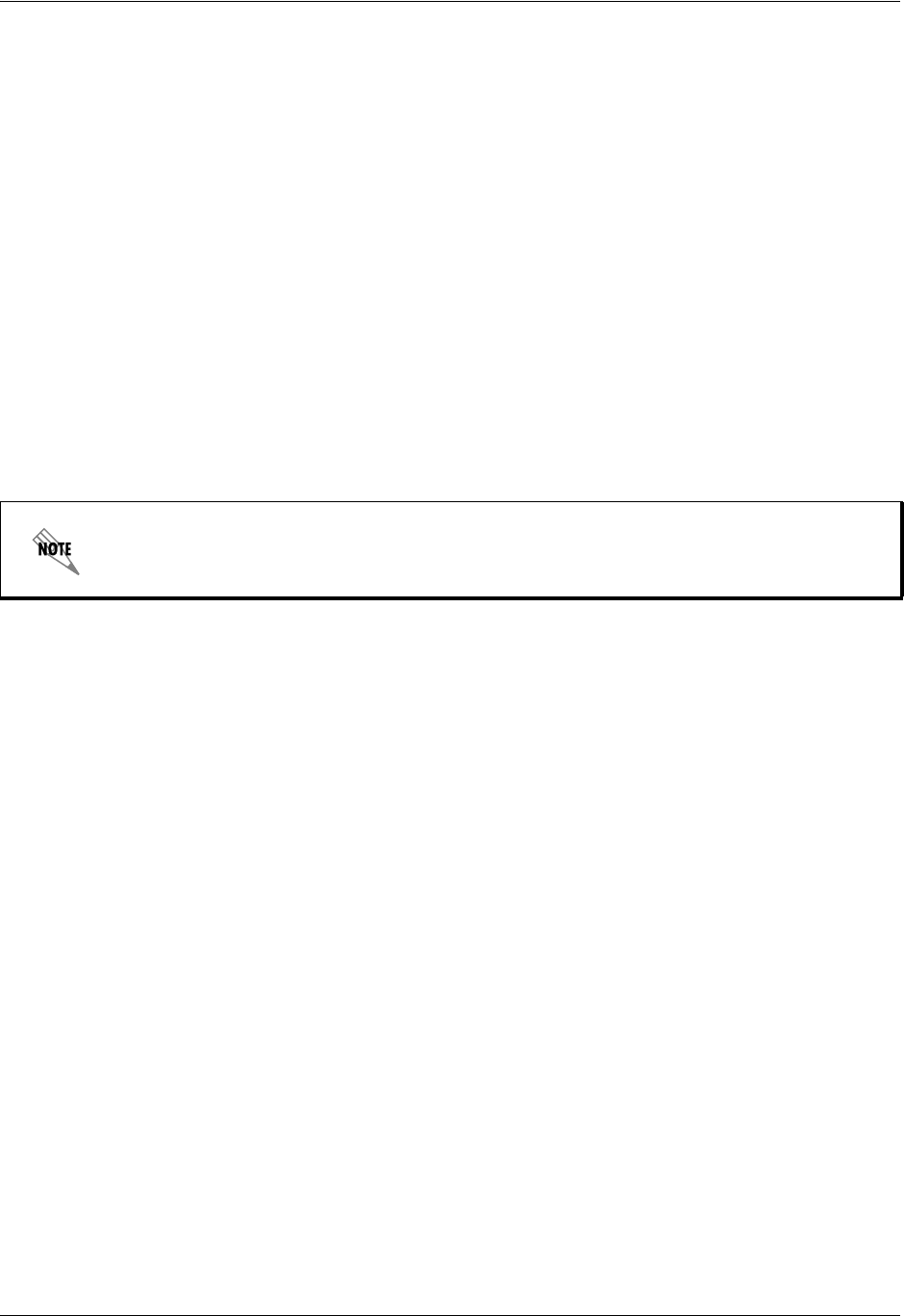
Section 7 MIBs TRACER 6000 Series Split System Manual
108 Copyright © 2005 ADTRAN, Inc. 612806320L1-1A
1. MIBS SUPPORTED BY THE TRACER 6000 SPLIT SYSTEM
Table 1 lists the MIBs supported by the TRACER 6000 split system.
2. MIB COMPILATION ORDER
MIBs are compiled in the order shown in Table 2.
Table 1. MIBs Supported by the TRACER 6000 split system
rfc2495.mib Standard – DS1 and E1 interface types
rfc2863.mib IF MIB – updated MIB II
rfc3418.mib SNMPv2 MIB
rfc3595.mib PerfHist-TC-MIB needed for RFC2495
rfc3635.mib EtherLike MIB
adtran.mib ADTRAN product MIB needed to locate the ADTRAN specific
MIBs on the MIB node tree
ianaif.mib IF MIB needed for RFC2495
ads1.mib ADTRAN DS1 MIB
tracer.mib TRACER modular MIB
SNMPv2-SMI, SNMPv2-TC, and SNMPv2-CONF are not compiled, but the paths to these
files are required by your MIB compiler during setup.
Table 2. MIB Compilation Order
rfc3418.mib
ianaif.mib
rfc2863.mib
rfc3593.mib
rfc3635.mib
rfc2495.mib
adtran.mib
ads1.mib
tracer.mib

TRACER 6000 Series Split System Manual Section 7 MIBs
612806320L1-1A Copyright © 2005 ADTRAN, Inc. 109
3. TRAPS SUPPORTED BY THE TRACER 6000 SPLIT SYSTEM
The TRACER 6000 split system supports the traps described in Table 3.
Table 3. Traps Supported by the TRACER 6000 split system
MIB Trap This trap indicates that....
TRACER.mib adTRACERColdStart the unit has powered up.
adTRACERYellow a change in the YELLOW alarm state has occurred and
the YELLOW alarm is now active.
adTRACERAIS a change in the Alarm Indication Signal (AIS) has
occurred and the AIS alarm is active.
adTRACERRedAlarm a change in the RED alarm state has occurred and the
RED alarm is now active.
adTRACERLOS a change in the Loss of Signal (LOS) state has occurred
and the LOS alarm is active.
adTRACERBPV a change in the BiPolar Violation (BPV) state has
occurred and the BPV alarm is active.
adTRACERRA a change in the Frame RA (Remote Alarm) state has
occurred and the RA alarm is active.
adTRACEROOF a change in the Out Of Frame (OOF) state has occurred
and the OOF alarm is active.
adTRACERCV a change in the Code Violation (CV) state has occurred
and the CV alarm is active.
adTRACERCRC a change in the Cyclic Redundancy Check (CRC) state
has occurred and the CRC alarm is active.
adTRACERmfLOF a change in the Loss of Multiframe (LOMF) state has
occurred and the LOMF alarm is active.
adTRACERmfLOS a change in the Multiframe Loss of Signal (LOS) state
has occurred and the Multiframe LOS alarm is active.
adTRACERmfAIS a change in the Multiframe Alarm Indication Signal (AIS)
state has occurred and the Multiframe AIS alarm is
active.
adTRACERmfRA a change in the Multiframe Remote Alarm (RA) has
occurred and the Multiframe RA alarm is active.
adTRACERlineLoopback a change in the line loopback state has occurred and the
line loopback is active.
adTRACERlinkLoopback a change in the link loopback state has occurred and the
link loopback is active.
adTRACERYellowOff a change in the YELLOW alarm state has occurred and
the YELLOW alarm is now inactive.
adTRACERAISoff a change in the Alarm Indication Signal (AIS) has
occurred and the AIS alarm is inactive.
adTRACERRedAlarmOff a change in the RED alarm state has occurred and the
RED alarm is now inactive.
adTRACERLOSoff a change in the Loss of Signal (LOS) state has occurred
and the LOS alarm is inactive.

Section 7 MIBs TRACER 6000 Series Split System Manual
110 Copyright © 2005 ADTRAN, Inc. 612806320L1-1A
TRACER.mib adTRACERBPVoff a change in the BiPolar Violation (BPV) state has
occurred and the BPV alarm is inactive.
adTRACERRAoff a change in the Frame RA (Remote Alarm) state has
occurred and the RA alarm is inactive.
adTRACEROOFoff a change in the Out Of Frame (OOF) state has occurred
and the OOF alarm is inactive.
adTRACERCVoff a change in the Code Violation (CV) state has occurred
and the CV alarm is inactive.
adTRACERCRCoff a change in the Cyclic Redundancy Check (CRC) state
has occurred and the CRC alarm is inactive.
adTRACERmfLOFoff a change in the Loss of Multiframe (LOMF) state has
occurred and the LOMF alarm is inactive.
adTRACERmfLOSoff a change in the Multiframe Loss of Signal (LOS) state
has occurred and the Multiframe LOS alarm is inactive.
adTRACERmfAISoff a change in the Multiframe Alarm Indication Signal (AIS)
state has occurred and the Multiframe AIS alarm is
inactive.
adTRACERmfRAoff a change in the Multiframe Remote Alarm (RA) has
occurred and the Multiframe RA alarm is inactive.
adTRACERlineLoopbackOff a change in the line loopback state has occurred and the
line loopback is inactive.
adTRACERlinkLoopbackOff a change in the link loopback state has occurred and the
link loopback is inactive.
adTRACERLinkDown the RF link is down.
adTRACERLinkUp the RF link is up.
adTRACERRFCLinkDown the RFC link is down between the Indoor Unit (IDU) and
Outdoor Unit (ODU). This trap only applies to TRACER
split systems.
adTRACERRFCLinkUp the RFC link is up between the IDU and ODU. This trap
only applies to TRACER split systems.
adTRACERRxLow the receive level is within 10 dB of sensitivity and the RF
Low alarm is active.
adTRACERRxLevel a change in receive level has occurred and the receive
level is within normal range.
adTRACERcurrThrsESon the threshold for current Errored Seconds (ES) has been
exceeded.
adTRACERcurrThrsESoff the threshold for current ES has not been exceeded.
adTRACERcurrThrsSESon the threshold for current Severely Errored Seconds
(SES) has been exceeded.
adTRACERcurrThrsSESoff the threshold for current SES has not been exceeded.
Table 3. Traps Supported by the TRACER 6000 split system (Continued)
MIB Trap This trap indicates that....

TRACER 6000 Series Split System Manual Section 7 MIBs
612806320L1-1A Copyright © 2005 ADTRAN, Inc. 111
4. MIB VARIABLES SUPPORTED BY THE TRACER 6000 SPLIT SYSTEM
Table 4. MIB Variables for ad.mi2
ad
adProducts
adProductInfo
adProdName DisplayString RO
adProdPartNumber DisplayString RO
adProdCLEIcode DisplayString RO
adProdSerialNumber DisplayString RO
adProdRevision DisplayString RO
adProdSwVersion DisplayString RO
adProdPhysAddress PhysAddress RO
adProdProductID
adProdTransType DisplayString RO
adMgmt
adAdmin
adPerform
adShared
adIdentity
adIdentityShared
adAgentCapModule
adAgentCapProduct
adAgentCapShared
adConformance
adCompliances

Section 7 MIBs TRACER 6000 Series Split System Manual
112 Copyright © 2005 ADTRAN, Inc. 612806320L1-1A
Table 5. MIB Variables for ads1.mib
adDS1AlarmTable
adDS1AlarmEntry
adDS1AlarmIndex Integer RO
adDS1AlarmEnable Integer RW
adDS1LineEvent Integer RO
adDS1LineArm Integer RW
adDS1AlertTable
adDS1AlertEntry
adDS1AlertIndex Integer RO
adDS1AlertEnable Integer RW
adDS1CurrentAlert Integer RO
adDS1TotalAlert Integer RO
adDS1FarCurrentAlert Integer RO
adDS1FarTotalAlert Integer RO
adDS1CurrentArm Integer RW
adDS1TotalArm Integer RW
adDS1FarCurrentArm Integer RW
adDS1FarTotalArm Integer RW
adDS1CurrentThreshold
adDS1CurrentThrsES Integer RW
adDS1CurrentThrsSES Integer RW
adDS1CurrentThrsSEFS Integer RW
adDS1CurrentThrsUAS Integer RW
adDS1CurrentThrsCSS Integer RW
adDS1CurrentThrsPCVsf Integer RW
adDS1CurrentThrsPCVesf Integer RW
adDS1CurrentThrsLES Integer RW
adDS1CurrentThrsLCV Integer RW
adDS1TotalThreshold
adDS1TotalThrsES Integer RW
adDS1TotalThrsSES Integer RW
adDS1TotalThrsSEFS Integer RW
adDS1TotalThrsUAS Integer RW
adDS1TotalThrsCSS Integer RW
adDS1TotalThrsPCVsf Integer RW
adDS1TotalThrsPCVesf Integer RW
adDS1TotalThrsLES Integer RW
adDS1TotalThrsLCV Integer RW

TRACER 6000 Series Split System Manual Section 7 MIBs
612806320L1-1A Copyright © 2005 ADTRAN, Inc. 113
Table 6. MIB Variables for TRACER.mib
adTRACER6420mg
adTRACER6420status
adTRACERRFlinkState DisplayString RO
adTRACERRFClinkState* DisplayString RO
adTRACERrfLow DisplayString RO
adTRACERRXquality DisplayString RO
adTRACERRXLevel DisplayString RO
adTRACERFrequencyPlan DisplayString RO
adTRACERLEDStatus DisplayString RO
adTRACERSlot1 DisplayString RO
adTRACERSlot2 DisplayString RO
adTRACER6420cfg
adTRACERBaudRate Integer RW
adTRACERBandPlan Integer RW
adTRACERactiveChannels Integer RW
adTRACERchannelSelect
adTRACERdsx1ChannelSelectTable
adTRACERdsx1ChannelSelectEntry
AdTRACERdsx1ChannelSelectEntry
adTRACERdsx1ChannelSelectIdx Integer RO
adTRACERdsx1ChannelSelection Integer RW
adTRACERswitchChannelSelectTable
adTRACERswitchChannelSelectEntry
AdTRACERswitchChannelSelectEntry
adTRACERswitchChannelSelectIdx Integer RO
adTRACERswitchChannelSelection Integer RW
adTRACERTxPower DisplayString RW
adTRACERalarmTable
AdTRACERAlarmEntry
adTRACERalarmEntry
adTRACERalarmNumber Integer RO
adTRACERAlarmReporting Integer RW
adTRACERClearHistory Integer RW
adTRACERrfTrapEnable Integer RW
adTRACERswitchModuleCfg
adTRACERswitchPortCfgTable
adTRACERswitchPortCfgEntry
* Listed variable only applies to TRACER split systems.

Section 7 MIBs TRACER 6000 Series Split System Manual
114 Copyright © 2005 ADTRAN, Inc. 612806320L1-1A
AdTRACERswitchPortCfgEntry
adTRACERswitchPortIdx Integer RO
adTRACERswitchPortEnable Integer RO
adTRACERswitchPortSpeedDuplex Integer RW
adTRACERswitchModuleStatus
adTRACERswitchPortStatusTable
adTRACERswitchPortStatusEntry
AdTRACERswitchPortStatusEntry
adTRACERswitchPortStatusIdx Integer RO
adTRACERswitchPortTxPackets Integer RO
adTRACERswitchPortTxPacketsDrop Integer RO
adTRACERswitchPortRxPackets Integer RO
adTRACERswitchPortRxPacketsDrop Integer RO
adTRACERswitchPortRxPacketError Integer RO
adTRACERswitchWanStatusTable
adTRACERswitchWanStatusEntry
AdTRACERswitchWanStatusEntry
adTRACERswitchWanStatusIdx Integer RO
adTRACERswitchWanTxPackets Integer RO
adTRACERswitchWanTxPacketsDrop Integer RO
adTRACERswitchWanRxPackets Integer RO
adTRACERswitchWanRxPacketsDrop Integer RO
adTRACERswitchWanRxPacketError Integer RO
adTRACER6420ip
adTRACERIpAddress IpAddress RO
adTRACERSubnetMask IpAddress RO
adTRACERGatewayIp IpAddress RO
adTRACER6420trapIP
adTRACERTrapIpHost1 IpAddress RW
adTRACERTrapIpHost2 IpAddress RW
adTRACERTrapIpHost3 IpAddress RW
adTRACERTrapIpHost4 IpAddress RW
adTRACERTrapIpHost5 IpAddress RW
adTRACER6420current
adTRACERCurrentRFs Integer RO
adTRACERCurrent24hRFs Integer RO
adTRACERCurrentRFCs* Integer RO
adTRACERCurrent24hRFCs* Integer RO
Table 6. MIB Variables for TRACER.mib (Continued)
* Listed variable only applies to TRACER split systems.

TRACER 6000 Series Split System Manual Section 7 MIBs
612806320L1-1A Copyright © 2005 ADTRAN, Inc. 115
adTRACERCurrentRxLs Integer RO
adTRACERCurrentMaxRxLs Integer RO
adTRACERCurrent24hMaxRxLs Integer RO
adTRACERCurrentMinRxLs Integer RO
adTRACERCurrent24hMinRxLs Integer RO
adTRACERCurrentRxQs Integer RO
adTRACERCurrentMaxRxQs Integer RO
adTRACERCurrent24hMaxRxQs Integer RO
adTRACERCurrentMinRxQs Integer RO
adTRACERCurrent24hMinRxQs Integer RO
adTRACERIntervalTable
AdTRACERInteralEntry
adTRACERIntervalEntry
adTRACERIntervalNumber Integer RO
adTRACERIntevalRFs Integer RO
adTRACERIntervalRFCs* Integer RO
adTRACERIntervalMaxRxLs Integer RO
adTRACERIntervalMinRxLs Integer RO
adTRACERIntervalMaxRxQs Integer RO
adTRACERIntervalMinRxQs Integer RO
adTRACERIntervalValidData TruthValue RO
adTRACERtotalTable
AdTRACERtotalEntry
adTRACERtotalEntry
adTRACERtotalNumber Integer RO
adTRACERtotalRFs Integer RO
adTRACERtotalRFCs* Integer RO
adTRACERtotalMaxRxLs Integer RO
adTRACERtotalMinRxLs Integer RO
adTRACERtotalMaxRxQs Integer RO
adTRACERtotalMinRxQs Integer RO
adTRACERtotalValidData TruthValue RO
adTRACER6420remoteStatus
adTRACERremoteRFlinkState DisplayString RO
adTRACERremoteRFClinkState* DisplayString RO
adTRACERremoteRFLow DisplayString RO
adTRACERremoteRXquality DisplayString RO
Table 6. MIB Variables for TRACER.mib (Continued)
* Listed variable only applies to TRACER split systems.

Section 7 MIBs TRACER 6000 Series Split System Manual
116 Copyright © 2005 ADTRAN, Inc. 612806320L1-1A
adTRACERremoteRXLevel DisplayString RO
adTRACERremoteFrequencyPlan DisplayString RO
adTRACERremoteLEDStatus DisplayString RO
adTRACERremoteSlot1 DisplayString RO
adTRACERremoteSlot2 DisplayString RO
adTRACER6420remoteCfg
adTRACERremoteBaudRate Integer RW
adTRACERremoteBandPlan Integer RW
adTRACERremoteActiveChannels Integer RW
adTRACERremoteChannelSelect
adTRACERremoteDSX1ChannelSelectTable
AdTRACERremoteDSX1ChannelSelectEntry
adTRACERremoteDSX1ChannelSelectEntry
adTRACERremoteDSX1ChannelSelectIdx Integer RO
adTRACERremoteDSX1ChannelSelection Integer RW
adTRACERremoteSwitchChannelSelectTable
AdTRACERremoteSwitchChannelSelectEntry
adTRACERremoteSwitchChannelSelectEntry
adTRACERremoteSwitchChannelSelectIdx Integer RO
adTRACERremoteSwitchChannelSelection Integer RW
adTRACERremoteTxPower DisplayString RW
adTRACERremoteAlarmTable
AdTRACERremoteAlarmEntry
adTRACERremoteAlarmEntry
adTRACERremoteAlarmNumber Integer RO
adTRACERremoteAlarmReporting Integer RW
adTRACERremoteSetPassword DisplayString RO
adTRACERremoteClearHistory Integer RW
adTRACERremoterfTrapEnable Integer RW
adTRACERremoteswitchModuleCfg
adTRACERremoteswitchPortCfgTable
adTRACERremoteswitchPortCfgEntry
AdTRACERremoteswitchPortCfgEntry
adTRACERremoteswitchPortIdx Integer RO
adTRACERremoteswitchPortEnable Integer RO
adTRACERremoteswitchPortSpeedDuplex Integer RW
adTRACERremoteswitchModuleStatus
adTRACERremoteswitchPortStatusTable
Table 6. MIB Variables for TRACER.mib (Continued)

TRACER 6000 Series Split System Manual Section 7 MIBs
612806320L1-1A Copyright © 2005 ADTRAN, Inc. 117
adTRACERremoteswitchPortStatusEntry
AdTRACERremoteswitchPortStatusEntry
adTRACERremoteswitchPortStatusIdx Integer RO
adTRACERremoteswitchPortTxPackets Integer RO
adTRACERremoteswitchPortTxPacketsDrop Integer RO
adTRACERremoteswitchPortRxPackets Integer RO
adTRACERremoteswitchPortRxPacketsDrop Integer RO
adTRACERremoteswitchPortRxPacketError Integer RO
adTRACERremoteswitchWanStatusTable
adTRACERremoteswitchWanStatusEntry
AdTRACERremoteswitchWanStatusEntry
adTRACERremoteswitchWanStatusIdx Integer RO
adTRACERremoteswitchWanTxPackets Integer RO
adTRACERremoteswitchWanTxPacketsDrop Integer RO
adTRACERremoteswitchWanRxPackets Integer RO
adTRACERremoteswitchWanRxPacketsDrop Integer RO
adTRACERremoteswitchWanRxPacketError Integer RO
adTRACER6420remoteTrapIP
adTRACERremoteTrapIpHost1 IpAddress RW
adTRACERremoteTrapIpHost2 IpAddress RW
adTRACERremoteTrapIpHost3 IpAddress RW
adTRACERremoteTrapIpHost4 IpAddress RW
adTRACERremoteTrapIpHost5 IpAddress RW
adTRACERremotecurrent
adTRACERremoteCurrentRFs Integer RO
adTRACERremoteCurrent24hRFs Integer RO
adTRACERremoteCurrentRFCs* Integer RO
adTRACERremoteCurrent24hRFCs* Integer RO
adTRACERremoteCurrentRxLs Integer RO
adTRACERremoteCurrentMaxRxLs Integer RO
adTRACERremoteCurrent24hMaxRxLs Integer RO
adTRACERremoteCurrentMinRxLs Integer RO
adTRACERremoteCurrent24hMinRxLs Integer RO
adTRACERremoteCurrentRxQs Integer RO
adTRACERremoteCurrentMaxRxQs Integer RO
adTRACERremoteCurrent24hMaxRxQs Integer RO
adTRACERremoteCurrentMinRxQs Integer RO
Table 6. MIB Variables for TRACER.mib (Continued)
* Listed variable only applies to TRACER split systems.

Section 7 MIBs TRACER 6000 Series Split System Manual
118 Copyright © 2005 ADTRAN, Inc. 612806320L1-1A
adTRACERremoteCurrent24hMinRxQs Integer RO
adTRACERremoteIntervalTable
AdTRACERremoteInteralEntry
adTRACERremoteIntervalEntry
adTRACERremoteIntervalNumber Integer RO
adTRACERremoteIntevalRFs Integer RO
adTRACERremoteIntervalRFCs* Integer RO
adTRACERremoteIntervalMaxRxLs Integer RO
adTRACERremoteIntervalMinRxLs Integer RO
adTRACERremoteIntervalMaxRxQs Integer RO
adTRACERremoteIntervalMinRxQs Integer RO
adTRACERremoteIntervalValidData TruthValue RO
adTRACERremoteTotalTable
AdTRACERremoteTotalEntry
adTRACERremoteTotalEntry
adTRACERremoteTotalNumber Integer RO
adTRACERremoteTotalRFs Integer RO
adTRACERremoteTotalRFCs* Integer RO
adTRACERremoteTotalMaxRxLs Integer RO
adTRACERremoteTotalMinRxLs Integer RO
adTRACERremoteTotalMaxRxQs Integer RO
adTRACERremoteTotalMinRxQs Integer RO
adTRACERremoteTotalValidData TruthValue RO
Table 6. MIB Variables for TRACER.mib (Continued)
* Listed variable only applies to TRACER split systems.

612806320L1-1A Copyright © 2005 ADTRAN, Inc. 119
TROUBLESHOOTING GUIDE
Provides helpful information for troubleshooting common configuration problems for the TRACER 6000 Series.
CONTENTS
Overview . . . . . . . . . . . . . . . . . . . . . . . . . . . . . . . . . . . . . . . . . . . . . . . . . . . . . . . . . . . . . . . . . . . . . 120
LED Indicators . . . . . . . . . . . . . . . . . . . . . . . . . . . . . . . . . . . . . . . . . . . . . . . . . . . . . . . . . . . . . . . . 120
PWR LED. . . . . . . . . . . . . . . . . . . . . . . . . . . . . . . . . . . . . . . . . . . . . . . . . . . . . . . . . . . . . . . . . . 120
TST LED . . . . . . . . . . . . . . . . . . . . . . . . . . . . . . . . . . . . . . . . . . . . . . . . . . . . . . . . . . . . . . . . . . 120
RF DWN LED. . . . . . . . . . . . . . . . . . . . . . . . . . . . . . . . . . . . . . . . . . . . . . . . . . . . . . . . . . . . . . . 120
RF LOW LED . . . . . . . . . . . . . . . . . . . . . . . . . . . . . . . . . . . . . . . . . . . . . . . . . . . . . . . . . . . . . . . 121
T1 Interface Alarms . . . . . . . . . . . . . . . . . . . . . . . . . . . . . . . . . . . . . . . . . . . . . . . . . . . . . . . . . . 121
E1 Interface Alarms . . . . . . . . . . . . . . . . . . . . . . . . . . . . . . . . . . . . . . . . . . . . . . . . . . . . . . . . . . 122
LAN LEDs . . . . . . . . . . . . . . . . . . . . . . . . . . . . . . . . . . . . . . . . . . . . . . . . . . . . . . . . . . . . . . . . . 124
RF Errors . . . . . . . . . . . . . . . . . . . . . . . . . . . . . . . . . . . . . . . . . . . . . . . . . . . . . . . . . . . . . . . . . . . . . 124
Step-by-Step Troubleshooting . . . . . . . . . . . . . . . . . . . . . . . . . . . . . . . . . . . . . . . . . . . . . . . . . . . 125
Installing/Troubleshooting the TRACER Hardware. . . . . . . . . . . . . . . . . . . . . . . . . . . . . . . . . . . 125
Installing/Configuring T1 Hardware . . . . . . . . . . . . . . . . . . . . . . . . . . . . . . . . . . . . . . . . . . . . . . 126
Installing/Configuring E1 Hardware . . . . . . . . . . . . . . . . . . . . . . . . . . . . . . . . . . . . . . . . . . . . . . 127
Installing/Configuring Ethernet Hardware . . . . . . . . . . . . . . . . . . . . . . . . . . . . . . . . . . . . . . . . . 127

Section 6 Troubleshooting Guide TRACER 6000 Series Split System Manual
120 Copyright © 2005 ADTRAN, Inc. 612806320L1-1A
1. OVERVIEW
This troubleshooting guide provides recommended actions for various conditions of the TRACER system.
The status LEDs (located on the front panel of the unit) provide information to help determine the
necessary troubleshooting action. This guide contains recommended actions for resolving possible
problems indicated by the status LEDs.
2. LED INDICATORS
PWR LED
If the PWR LED is not ON and solid green, the TRACER is not receiving adequate DC power.
Recommended Actions:
1. Verify that the power source is delivering between 21 and 60 VDC.
2. Check the polarity of the power connection (referenced to ground) of both the TRACER unit and the
power source.
3. Check the internal fuse. The fuse is accessed from the rear panel of the unit. If this fuse is open,
replace with a 2 A, 250 V (2-inch) slow-blo fuse.
4. Verify that the coaxial feedline cable is connected to the TO IDU port on the ODU and the TO ODU port
on the IDU.
5. Verify the integrity of the coaxial feedline cable between the IDU and ODU.
6. Verify the integrity of the lightning arrestors (both RF and IF).
TST LED
The TST LED will flash once (amber) during power-up to indicate a self-test is in progress. If the TST
LED is flashing or remains ON after 10 seconds, the TRACER unit has failed the self-test. This is an
internal failure, and technical support should be contacted.
RF DWN LED
If the RF DWN LED is ON (solid red), there is a problem with the RF receive path from the remote
TRACER.
Recommended Actions:
1. Verify that one end of the link is configured as Channel plan A and the other end as Channel plan B.
2. Verify that both ends of the link are configured for the same Channel Plan (1, 2, 3).
3. Measure the RSSI voltage and consult the RSSI calibration sheet included with the unit. If the voltage
level corresponds to a received signal power level that agrees with the calculated receive signal level,
proceed with Step 7.
4. Check the IF coaxial cable connection between the IDU and the ODU.
If a problem is found with the coaxial feedline cable between the IDU and ODU or
the lightning arrestors, IMMEDIATELY remove power from the IDU to avoid further
damage.

TRACER 6000 Series Split System Manual Section 6 Troubleshooting Guide
612806320L1-1A Copyright © 2005 ADTRAN, Inc. 121
5. Check the RF coaxial cable connection between the ODU and the antenna.
6. Verify that the antenna polarization is the same at both ends of the RF signal transmit and receive path.
7. Verify the RF signal path is clear.
8. Check the integrity of the lightning arrestors (both RF and IF), and verify that the lightning arrestor in the
IF cable is capable of passing up to +/– 60 VDC.
9. Check for possible interference at both ends of the link. If necessary, change polarization and/or band
plans at both ends.
RF LOW LED
If the RF LOW LED is ON (solid red), the received signal is approaching 0 V of RSSI. This condition is
typically indicative of a path or installation problem.
Recommended Actions:
1. Verify the far-end transmitter power setting is the value that the link planning budget allows.
2. Check all coaxial cable connectors for solid connections. Check for water and corrosion around any of
the connectors. If water is apparent in the coaxial connectors, replace the coaxial cable and the
connectors, making sure to properly weatherproof the replacements.
3. Verify the RF signal path by verifying the antenna alignment.
4. Check the integrity of lightning arrestors.
T1 Interface Alarms
All active T1 alarms are displayed in the T1X STATUS/CONFIGURATION/LOOPBACK menu page.To identify the
T1 interface in alarm and the specific alarm present, display the T1(X) STATUS screens and check the T1(X)
INTERFACE ALARMS field.
Recommended Actions:
1. Display the T1(X) STATUS screen and check the T1(X) INTERFACE ALARM field to identify the active alarm.
2. Follow the steps below for the appropriate alarm.
LOS Alarm or Red Alarm
LOS ALARM and RED ALARM are indications that the TRACER may be unable to detect a viable T1
received signal from the connected T1 equipment. This error may be due to a degraded signal or no
signal, or may be caused by improper framing.
Recommended Actions:
1. Verify that the T1 cable is connected to the T1 interface on the TRACER.
2. Verify the connections at the opposite end of the T1 cable.
3. Verify that the framing mode (D4 or ESF) is the same for both the TRACER and the T1 equipment.
Yellow Alarm
A Yellow Alarm is generated by the attached equipment. When the attached equipment’s T1 interface is
in Red Alarm, the TRACER generates a Yellow Alarm.
Recommended Actions:
1. Follow the troubleshooting steps for Red Alarm, but do so at the attached equipment.

Section 6 Troubleshooting Guide TRACER 6000 Series Split System Manual
122 Copyright © 2005 ADTRAN, Inc. 612806320L1-1A
Blue Alarm
A remote alarm (alarm indication signal or AIS) is generated by the attached equipment. The root
cause must be determined at the attached equipment. A typical cause of a blue alarm is a lack of input
to a CSU.
Recommended Actions:
1. Verify the input to any attached data equipment.
BPV
Bipolar violations (BPVs) indicate an improper configuration or faulty wiring.
Recommended Actions:
1. Verify the TRACER unit and the attached equipment are configured for the same line coding
(B8ZS or AMI).
2. Verify the cable connections for the T1 interface are solid.
E1 Interface Alarms
All active E1 alarms are displayed on the E1X STATUS/CONFIGURATION/LOOPBACK menu page. To identify
the E1 interface in alarm and the specific alarm present, display the E1(X) STATUS screens and check the
E1(X) INTERFACE ALARMS field.
Recommended Actions:
1. Display the E1(X) STATUS screen and check the E1(X) INTERFACE ALARM field to identify the active
alarm.
2. Follow the steps below for the appropriate alarm.
LOS Alarm (Loss of Signal)
LOS ALARM is an indication that the TRACER may be unable to detect a viable E1 received signal
from the connected E1 equipment. This error may be due to a degraded signal or no signal, or may be
caused by improper framing.
Recommended Actions:
1. Verify that the E1 cable is connected to the E1 interface on the TRACER.
2. Verify the connections at the opposite end of the E1 cable.
3. Verify that the framing mode (framed, multiframed, or unframed) is the same for both the
TRACER and the E1 equipment.
AIS Alarm
A remote alarm (alarm indication signal or AIS) is generated by the attached equipment. The root
cause must be determined at the attached equipment. A typical cause of a blue alarm is a lack of input
to a CSU.
Recommended Actions:
1. Verify the input to any attached data equipment.
LCV
Line code violations (LCVs) indicate that the received E1 stream contains an invalid line code and are
generally caused by an improper configuration or faulty wiring.

TRACER 6000 Series Split System Manual Section 6 Troubleshooting Guide
612806320L1-1A Copyright © 2005 ADTRAN, Inc. 123
Recommended Actions:
1. Verify the TRACER unit and the attached equipment are configured for the same line coding (HDB3
or AMI).
2. Verify the cable connections for the E1 interface are solid.

Section 6 Troubleshooting Guide TRACER 6000 Series Split System Manual
124 Copyright © 2005 ADTRAN, Inc. 612806320L1-1A
CRC
CRC errors indicate that the receiver is unable to synchronize to the CRC-4 frame pattern of the
received E1 signal.
Recommended Actions:
1. Verify the TRACER unit and the attached equipment are configured for the same signaling
(MULTIFRAMED, UNFRAMED, or FRAMED).
2. Verify the cable connections for the E1 interface are solid.
LAN LEDs
If the LAN LED is OFF, the TRACER is not able to detect an active Ethernet link on the particular
10/100BaseT/TX interface.
Recommended Actions:
1. Check all Ethernet cable connections to verify they are properly plugged in (making sure the tab on the
connector snaps into place).
2. Connect the 10/100BaseT/TX interface to a “known good” Ethernet port to verify the TRACER port is
functioning properly.
3. Try another Ethernet cable.
3. RF ERRORS
RF errors can range from a nonviable microwave path to loose RF connectors.
Nonviable path conditions could be caused by physical obstructions such as buildings, mountainous
terrain, trees, etc., as well as other physical limitations such as excessive path distances and in-band RF
interference. These types of errors are remedied by performing a detailed line-of-site microwave path
study to determine whether a microwave link is feasible for the terrain and environment under
consideration.
If after performing a microwave path study the system is still not operational, ensure that the antennas are
properly aligned. Note that alignment must be achieved in both elevation and azimuth for optimal link
performance. The TRACER can be used to aid in antenna alignment by looking at the RX POWER “fuel
gauge” on the System Status or System Option menu pages or by measuring the DC voltage (relative to
ground) at the IDU or ODU RSSI test jack. Optimal antenna alignment is achieved by peaking the RSSI
voltage and the RX POWER “fuel gauge” on the TRACER terminal display. Consult the ADTRAN
TRACER Data Sheet included with the unit to verify that the actual receive signal level agrees with the
calculated receive signal.
RSSI test points, located on the front panel of the IDU and beneath a weatherproof cover on the bottom of
the ODU, provide a DC voltage level (relative to the GND test points) that corresponds to the amount of
signal being received from the far end’s transmitter. The voltage at these test points can vary from
approximately 0 to 5 VDC. An RSSI calibration sheet is shipped with the system to provide the installer a
cross-reference between actual received signal level (in dBm) and RSSI voltage. This sheet is useful for
verifying link budget calculations and ensuring proper equipment installation.

TRACER 6000 Series Split System Manual Section 6 Troubleshooting Guide
612806320L1-1A Copyright © 2005 ADTRAN, Inc. 125
4. STEP-BY-STEP TROUBLESHOOTING
The logical troubleshooting flow presented in this section can be used to set up your TRACER system, and
also to diagnose a previously installed system. Please contact Technical Support at any stage during
installation and/or troubleshooting if you require assistance.
5. INSTALLING/TROUBLESHOOTING THE TRACER HARDWARE
1. Perform a detailed path profile and link budget for each TRACER microwave link. A thorough
path study can be used to estimate signal power budgets, estimate fade margins at each receiver,
identify potential line-of-site obstacles, properly size antenna dishes, and determine minimum
antenna dish heights above the earth.
2. Set up all of the TRACER hardware on a workbench. (This includes connecting the IDU and ODU
systems.) The actual cables used in the permanent installation should be used in the workbench
setup. A rigorous workbench “simulation” of the link will help alleviate and avoid
time-consuming errors.
3. Examine the PLAN A and PLAN B LEDs on the front panel of each unit. These LEDs indicate the
frequency plan for each TRACER unit. Each TRACER link must have a Plan A radio on one side
and a Plan B radio on the other.
4. Connect the IDU and ODU using the IF feedline cable. Secure one end of the RF cable to the
ANTENNA N-Type connector on the bottom of the ODU. Attach the other end of the coaxial
cable(s) to an RF power meter or spectrum analyzer, if either is available. The power measured by
the meter/analyzer will be the RF power available at the input of the antenna. The TRACER unit is
programmed at the factory to output approximately 100 mW (20 dBm) of RF power. The actual
power level measured by the meter/analyzer will be less than 100 mW due to RF losses through
the coaxial cable, and is a function of the cable type and length being used. In any event, the power
level at the output of the coaxial cable should be a significant fraction of 100 mW. A power
meter/analyzer reading that is not on the order of at least tens-of-milliwatts could be an indication
of unsuitable RF cable or faulty or unreasonably long coaxial cable, or a combination of these
factors.
5. Resolve all RF coaxial cabling errors before proceeding.
6. Attach the RF coaxial cables to a high-quality attenuator, if possible. If you do not have an
attenuator, attach the coaxial cables to the antennas to be used in the permanent installation. If the
installation antennas are not available, small, inexpensive dipole or patch antennas can be used for
verification purposes. If an adjustable attenuator is being used, dial in the amount of attenuation
that corresponds to the path loss value expected for the microwave link in which the TRACER
hardware will be installed. The path loss value can be calculated from a knowledge of the path
length, or provided by a path study. Remember to subtract both antenna gain values from the
attenuator level if these values have not already been accounted for.
7. After setting up the RF pieces, examine the RF DOWN LED on the front panel of each
TRACER unit. If the RF DOWN LED is illuminated (red), the corresponding TRACER is not
receiving a suitable RF signal from the other TRACER unit. In this case, the receiving TRACER is
either receiving a very weak signal or no signal at all. If the RF DOWN LED is not illuminated,
then the TRACER units are receiving a suitable RF signal. Suitable RF power levels for low error
rate communication will range from -30 dBm to -85 dBm measured at the N-type connector input
on the TRACER unit.

Section 6 Troubleshooting Guide TRACER 6000 Series Split System Manual
126 Copyright © 2005 ADTRAN, Inc. 612806320L1-1A
8. Resolve any signal level issues before proceeding.
9. Examine the RF LOW LED on the front panel of each TRACER. If this LED is illuminated, then
the TRACER is receiving a relatively weak signal; however, if the RF DOWN LED is not
illuminated, then the received signal is being suitably processed by the TRACER system. If you
are receiving a weak signal (RF LOW is ON), please verify that the weak signal is not being caused
by a faulty cable, an insufficiently tightened cable, or some other installation-related problem.
Also, make sure an unreasonably large attenuation value has not been selected if you are using an
attenuator on a workbench setup.
Use the tables in Section 2, Microwave Path Engineering Basics on page 15, of this manual to
select the proper free-space attenuation value (in dB) based on the estimated length of the
microwave path. Remember to subtract both antenna gains (local and remote) from the attenuator
setting.
10. Test the installed modules by performing the following:
11. Command a link loopback on the remote TRACER unit and run a test pattern from the connected
T1/E1 equipment. This will verify the data path across the RF link.
Installing/Configuring T1 Hardware
1. If possible, attach any or all of the intended T1 hardware to the TRACER units using the same
workbench setup. This step offers the perfect opportunity to configure your T1 hardware for
proper functioning with the TRACER hardware.
2. To significantly reduce the probability of an unsuccessful field installation, resolve any remaining
T1 equipment-to-TRACER configuration issues before field installation. See T1 Interface Alarms
on page 121 for more information on resolving T1 interface alarm conditions.
4xT1 Module
Initiate a line loopback on the local TRACER unit and run a test pattern from the connected T1
equipment. This will verify the connection between the T1 equipment and the local
TRACER unit.
4xE1 Module
Initiate a line loopback on the local TRACER unit and run a test pattern from the connected E1
equipment. This will verify the connection between the E1 equipment and the local
TRACER unit.
Quad Ethernet Switch Module
Connect a computer (or Ethernet test equipment) to the TRACER Ethernet interfaces. Perform a
“ping” from one test station across the wireless link to another test station connected to the
remote TRACER. This will verify the data path between the test equipment and the TRACER
unit.
External pattern generators are required to test data path integrity. A T1/E1 BER tester is
suggested.

TRACER 6000 Series Split System Manual Section 6 Troubleshooting Guide
612806320L1-1A Copyright © 2005 ADTRAN, Inc. 127
Installing/Configuring E1 Hardware
1. If possible, attach any or all of the intended E1 hardware to the TRACER units using the same
workbench setup. This step offers the perfect opportunity to configure your E1 hardware for
proper functioning with the TRACER hardware.
2. To significantly reduce the probability of an unsuccessful field installation, resolve any remaining
E1 equipment-to-TRACER configuration issues before field installation. See E1 Interface Alarms
on page 122 for more information on resolving E1 interface alarm conditions.
Installing/Configuring Ethernet Hardware
1. If possible, attach any or all of the intended Ethernet hardware to the TRACER units using the
same workbench setup. This step offers the perfect opportunity to configure your Ethernet
hardware for proper functioning with the TRACER hardware.
2. To significantly reduce the probability of an unsuccessful field installation, resolve any remaining
Ethernet equipment-to-TRACER configuration issues before field installation.

Section 6 Troubleshooting Guide TRACER 6000 Series Split System Manual
128 Copyright © 2005 ADTRAN, Inc. 612806320L1-1A